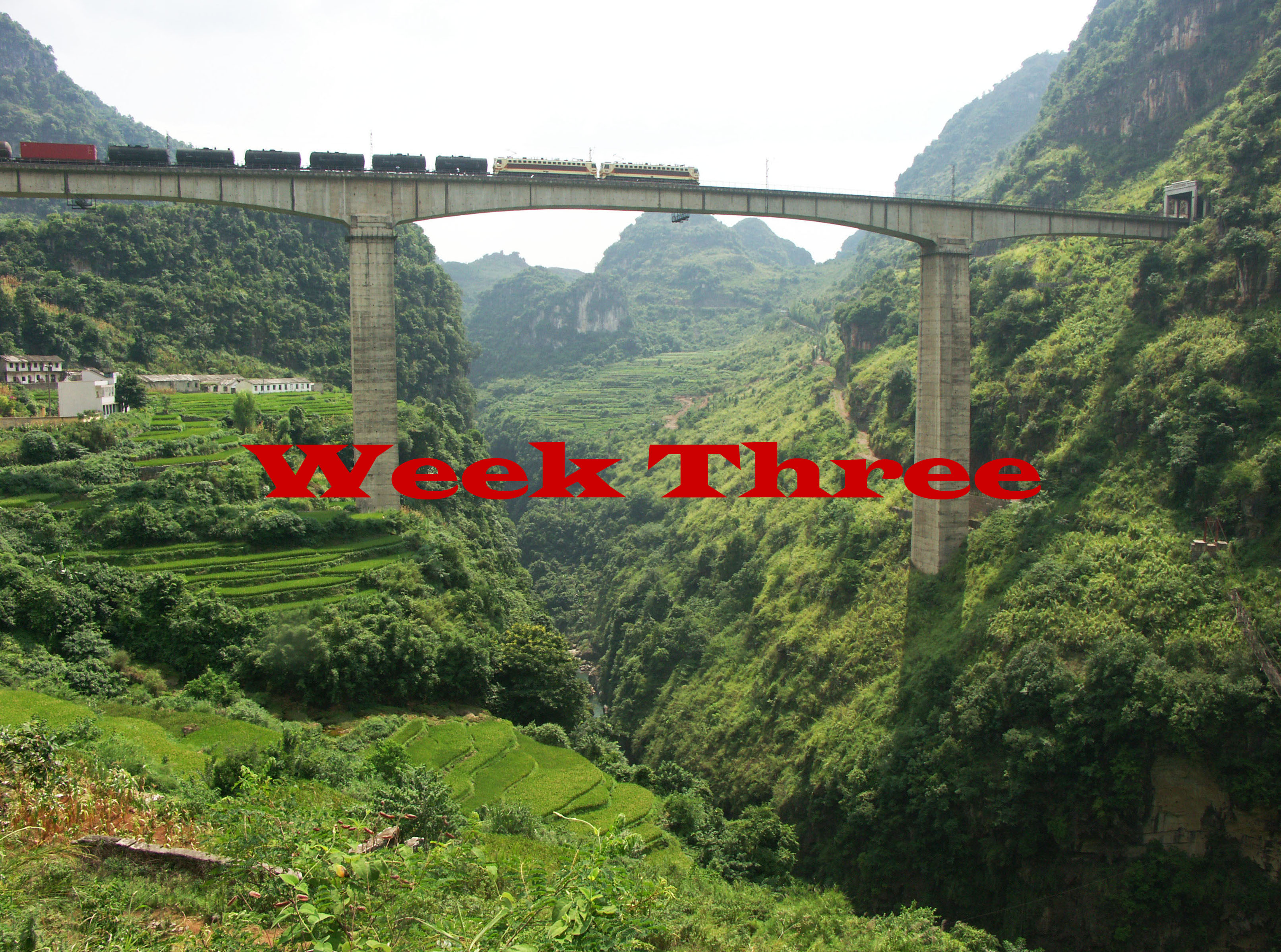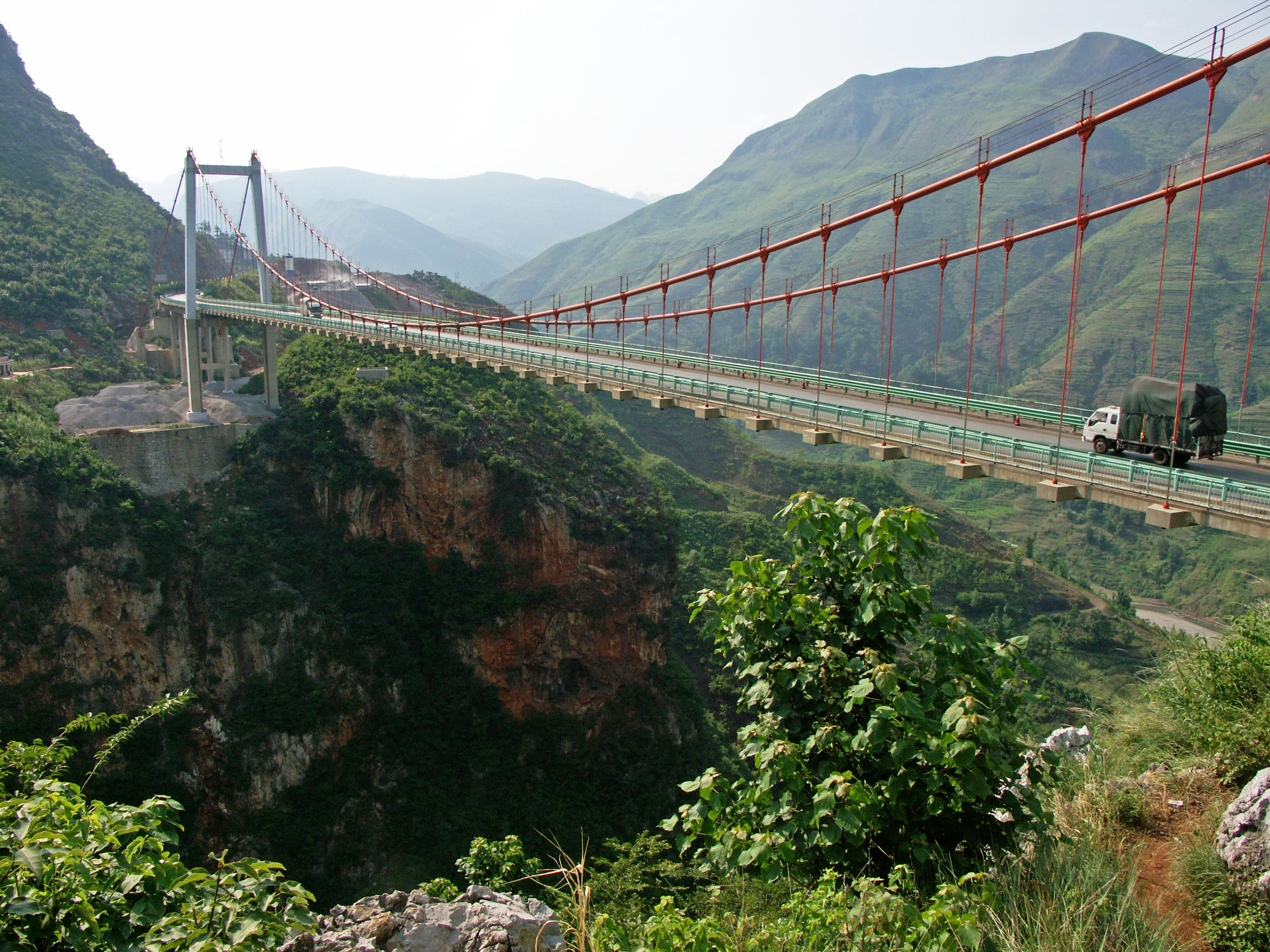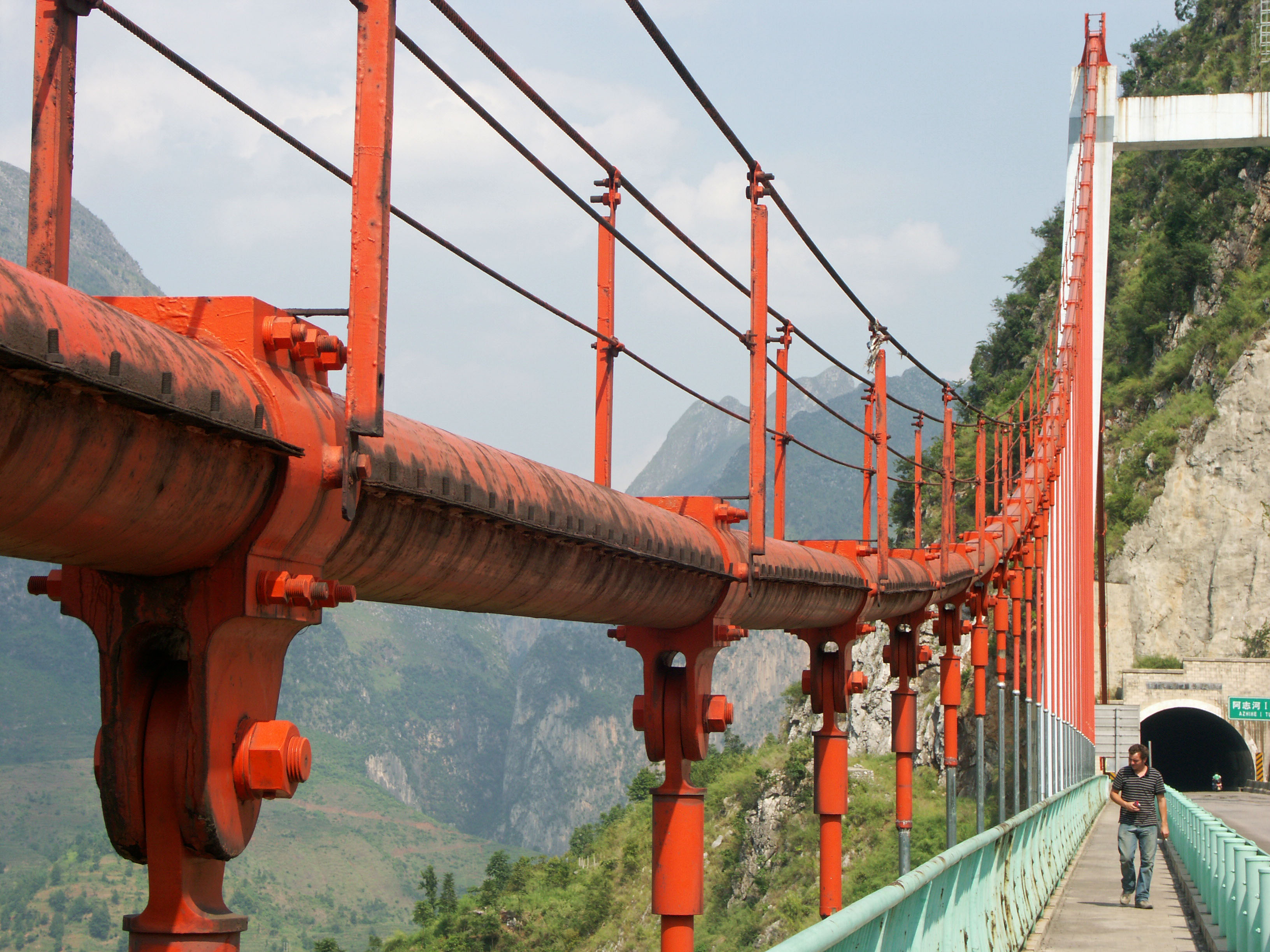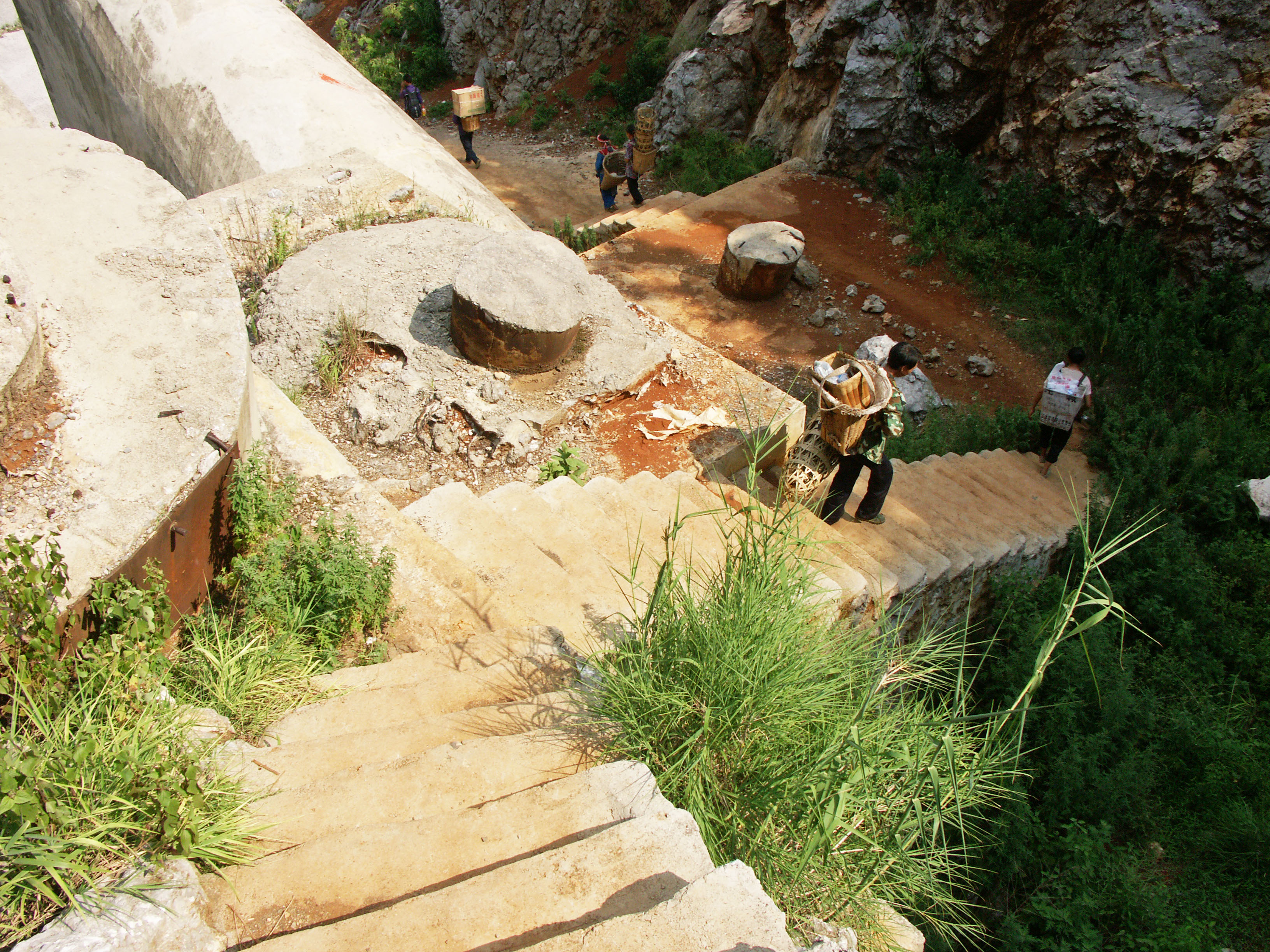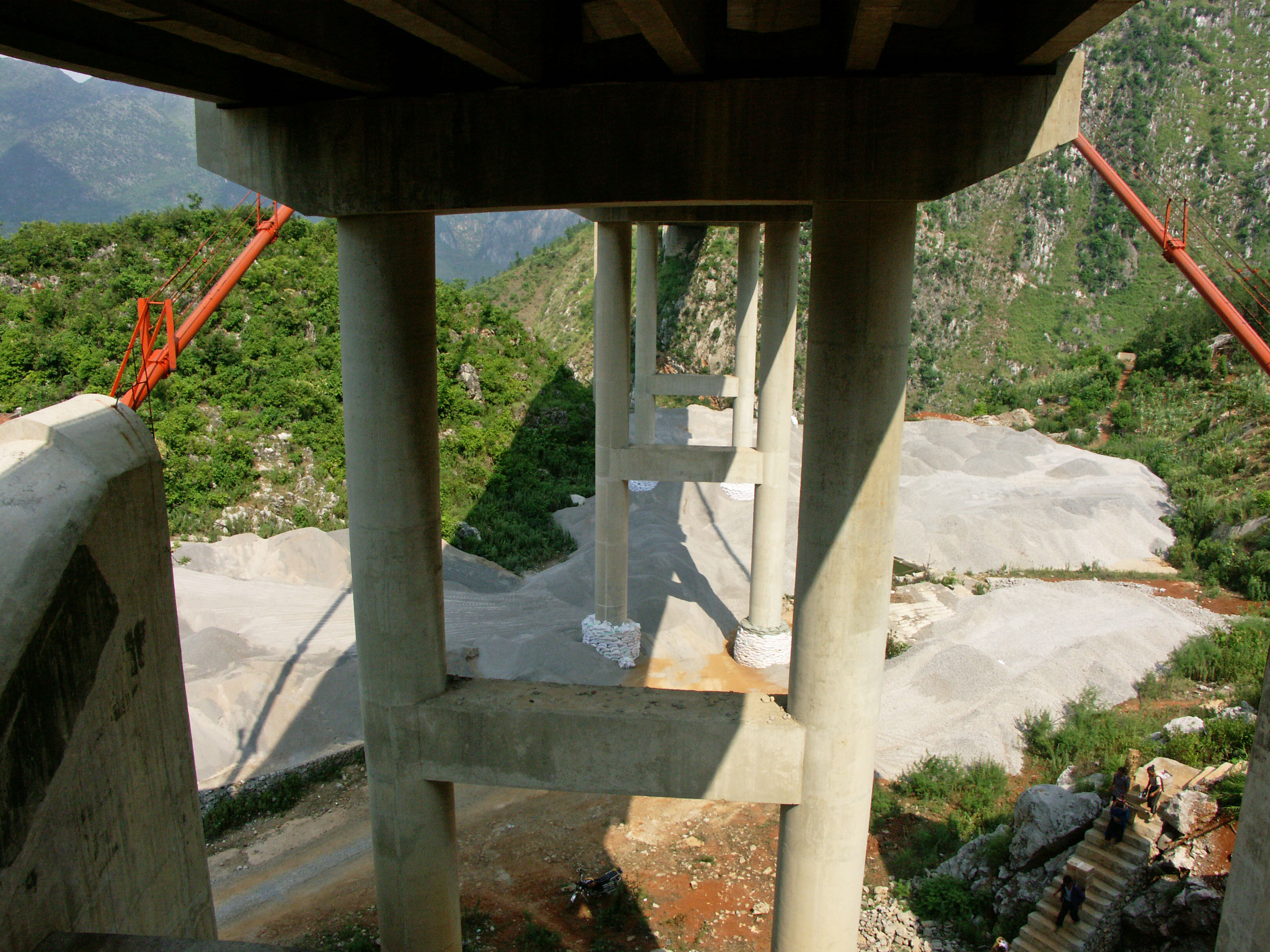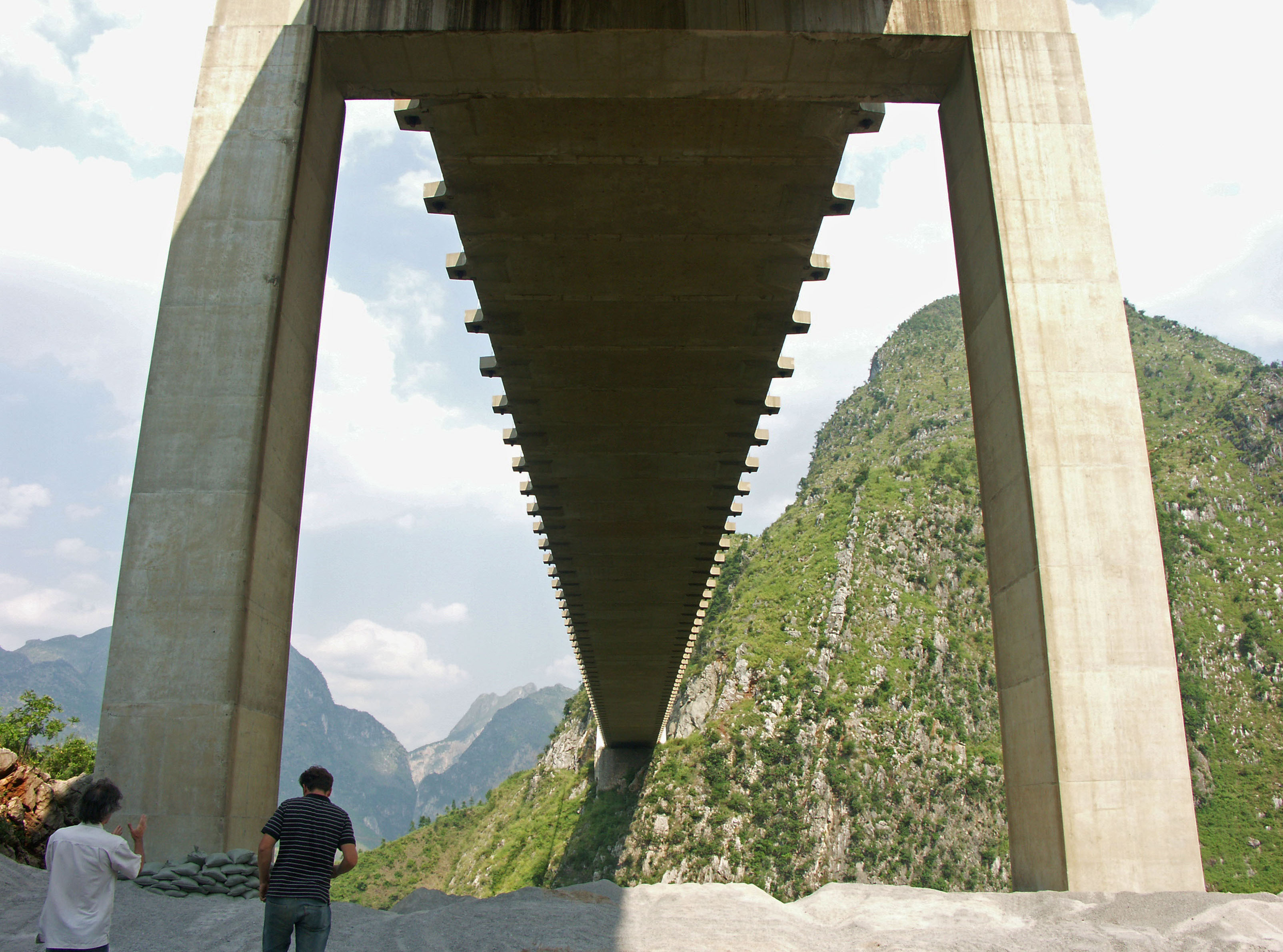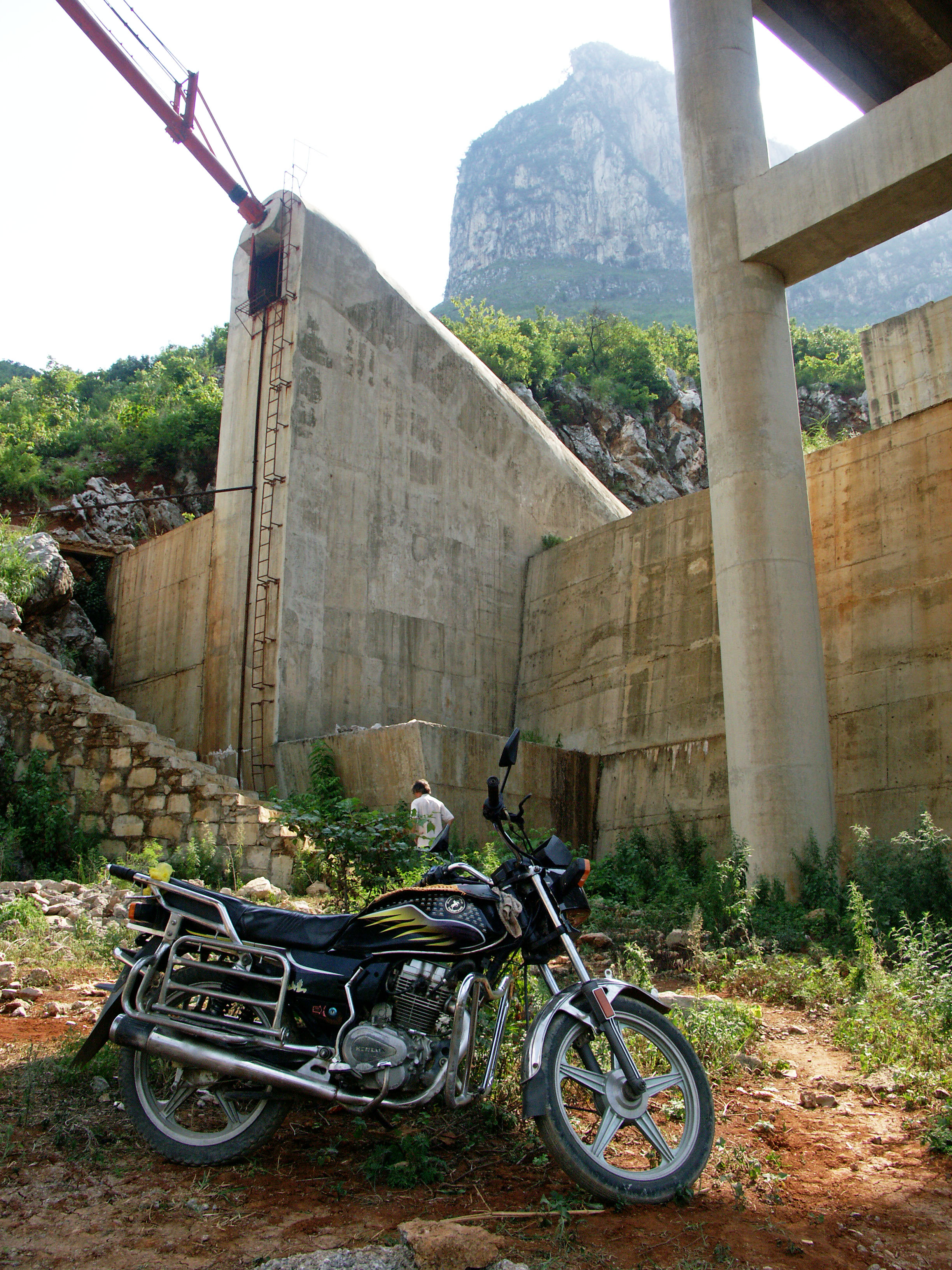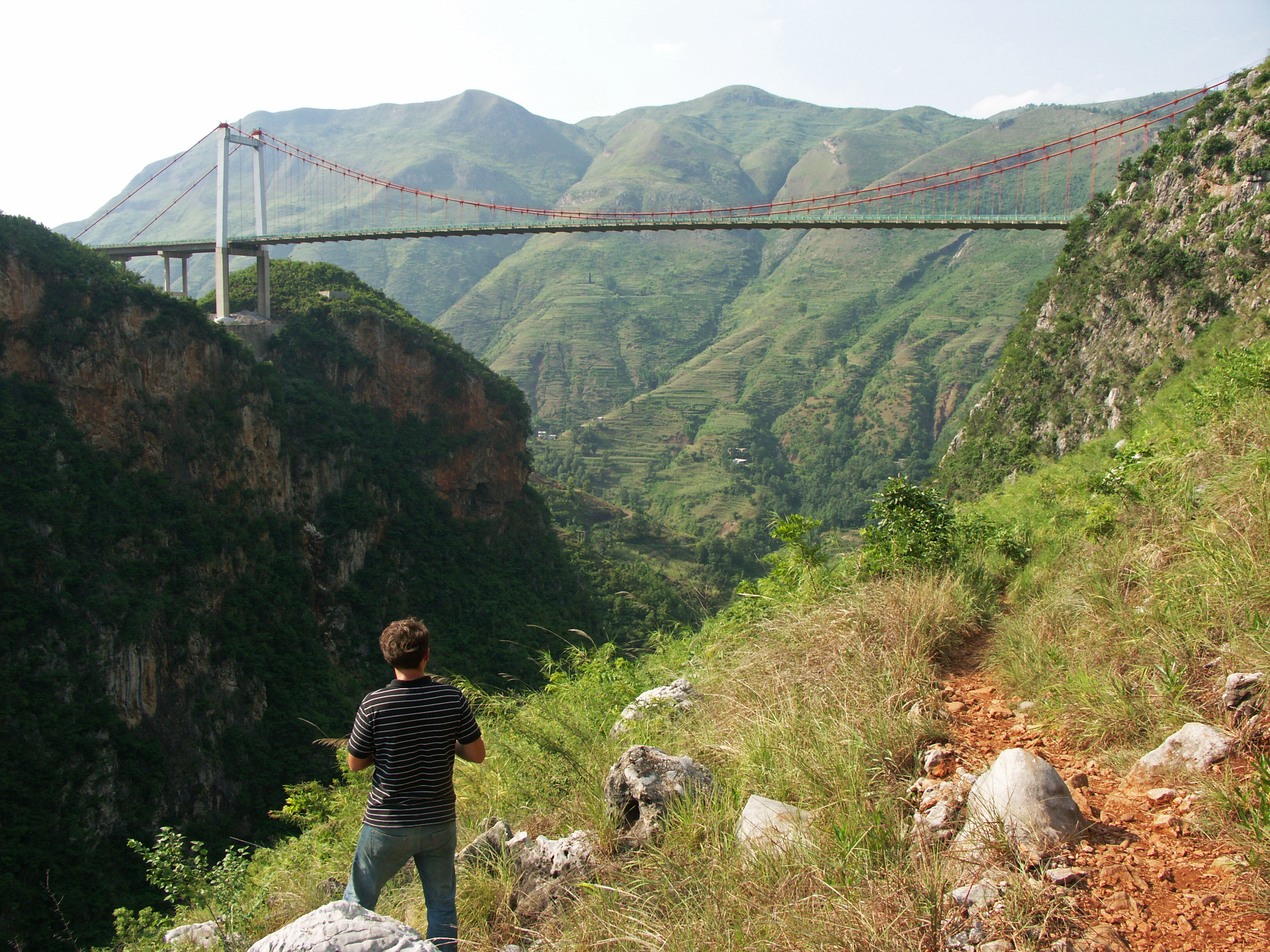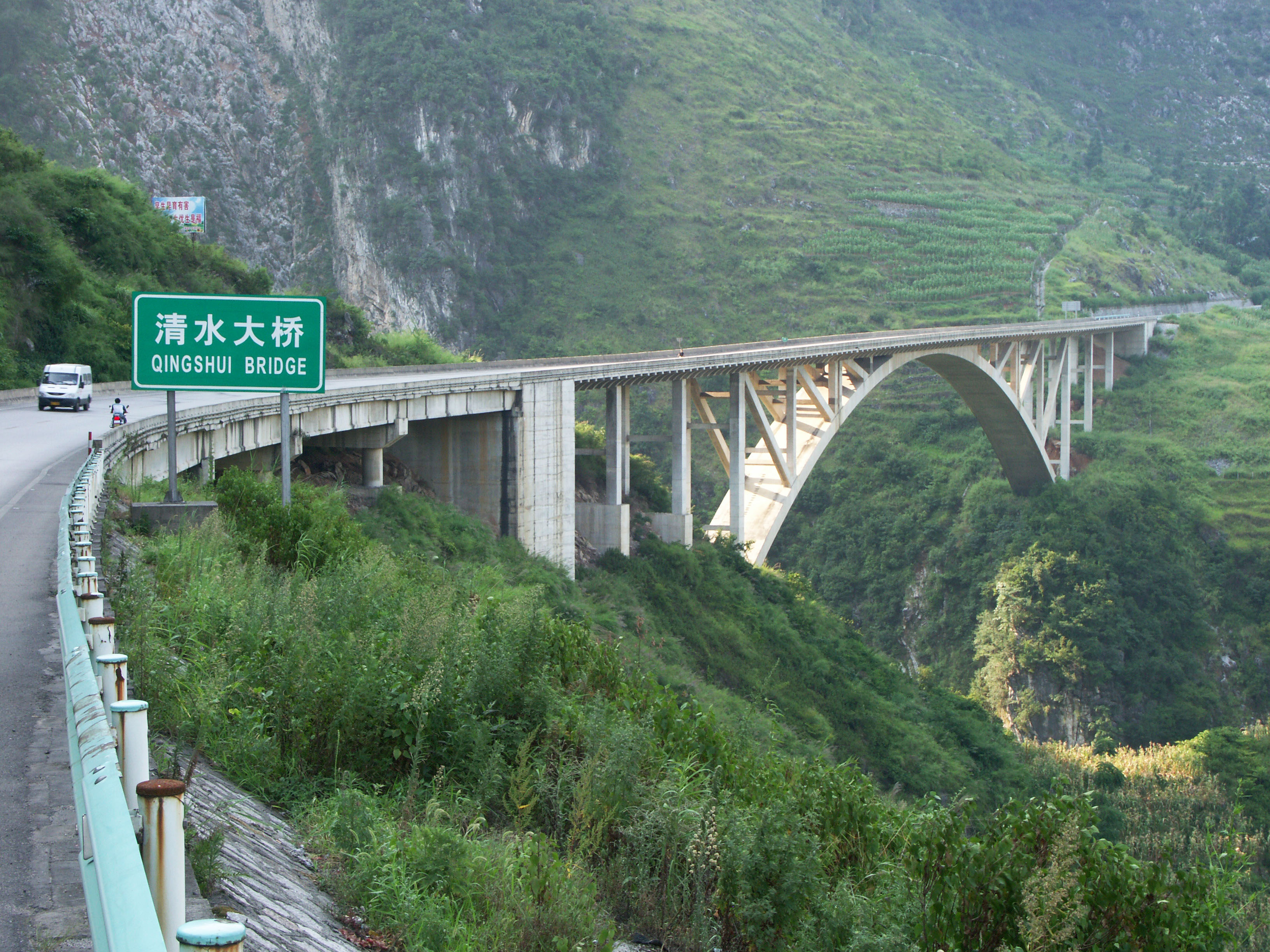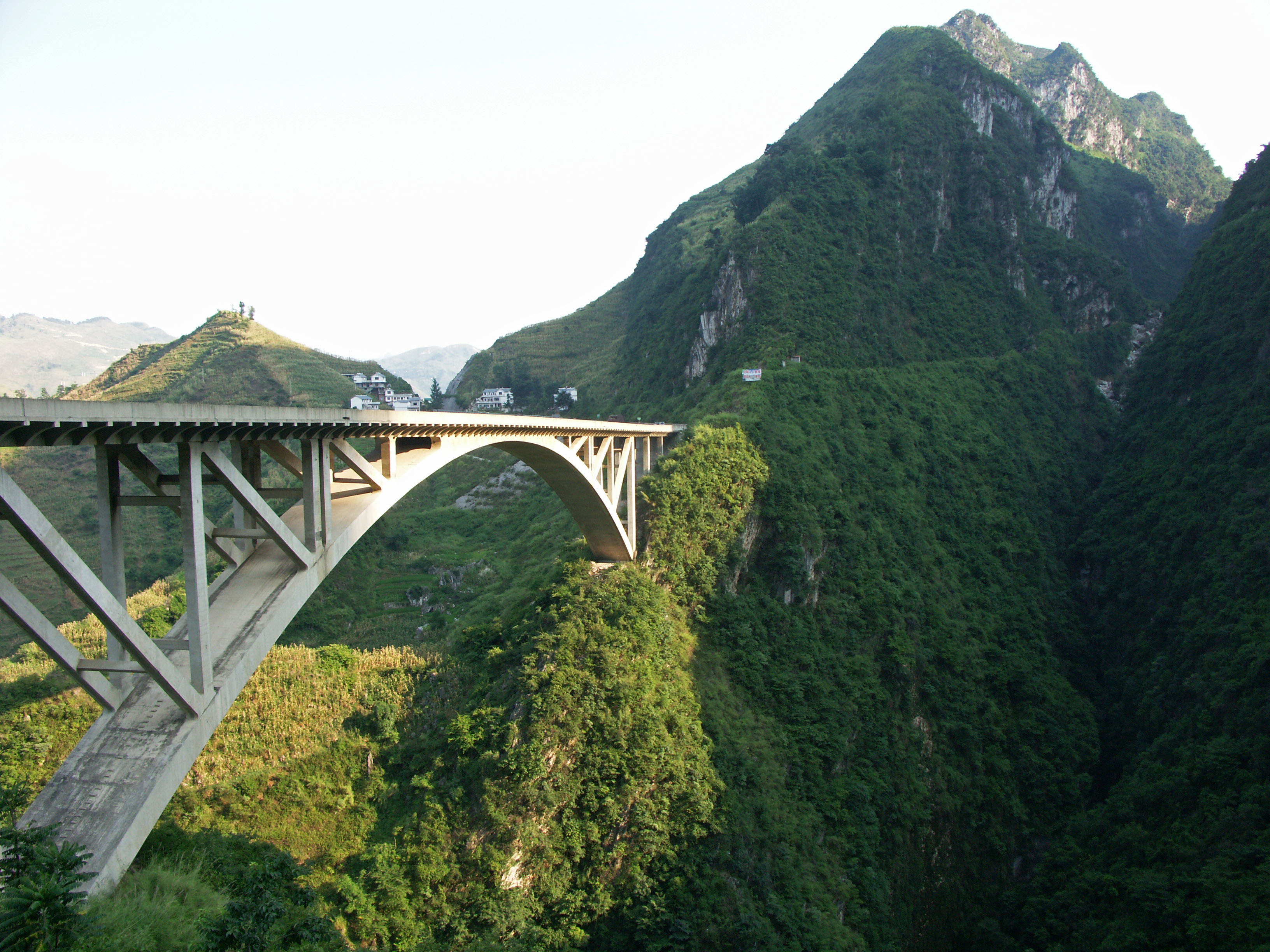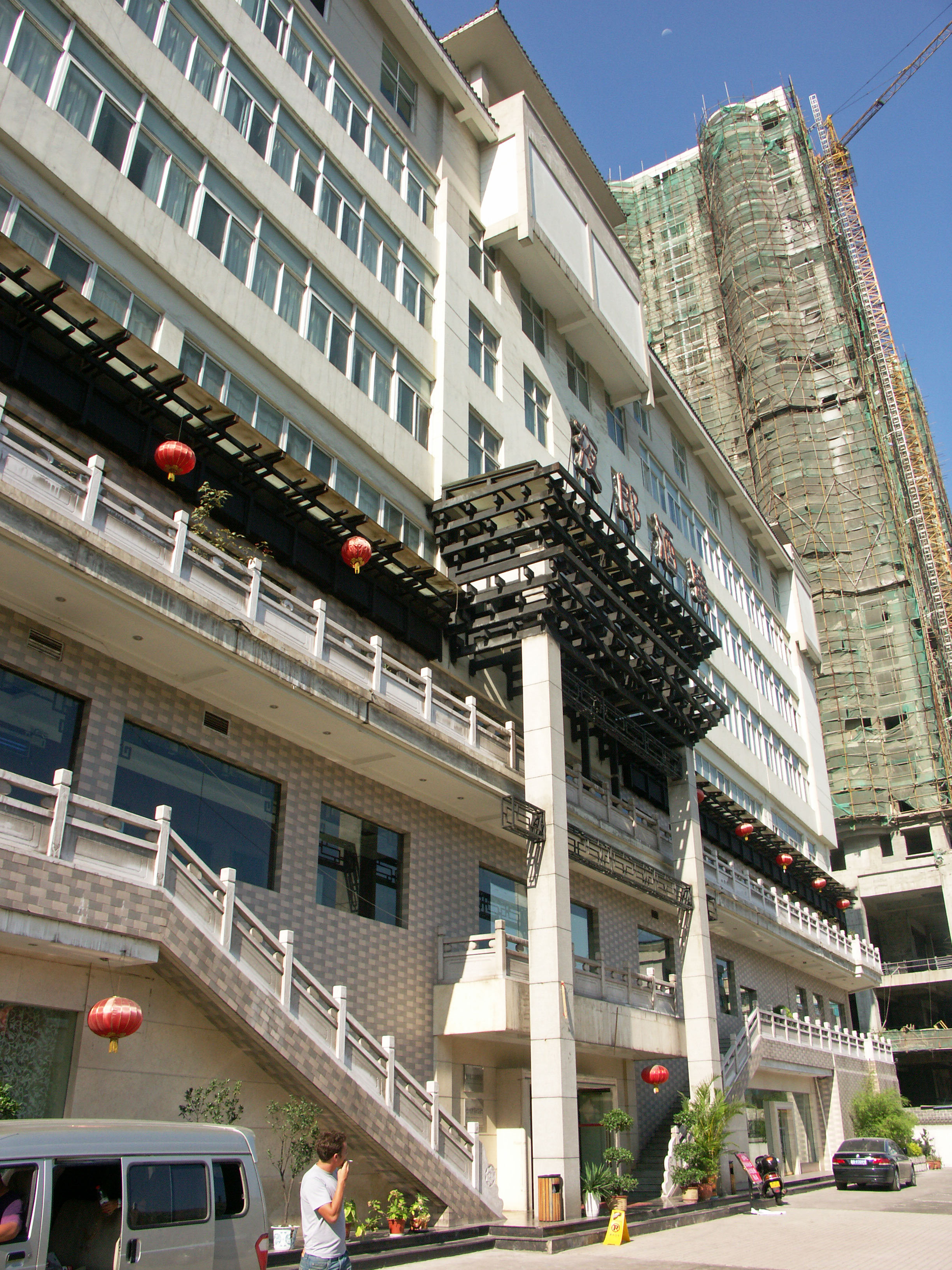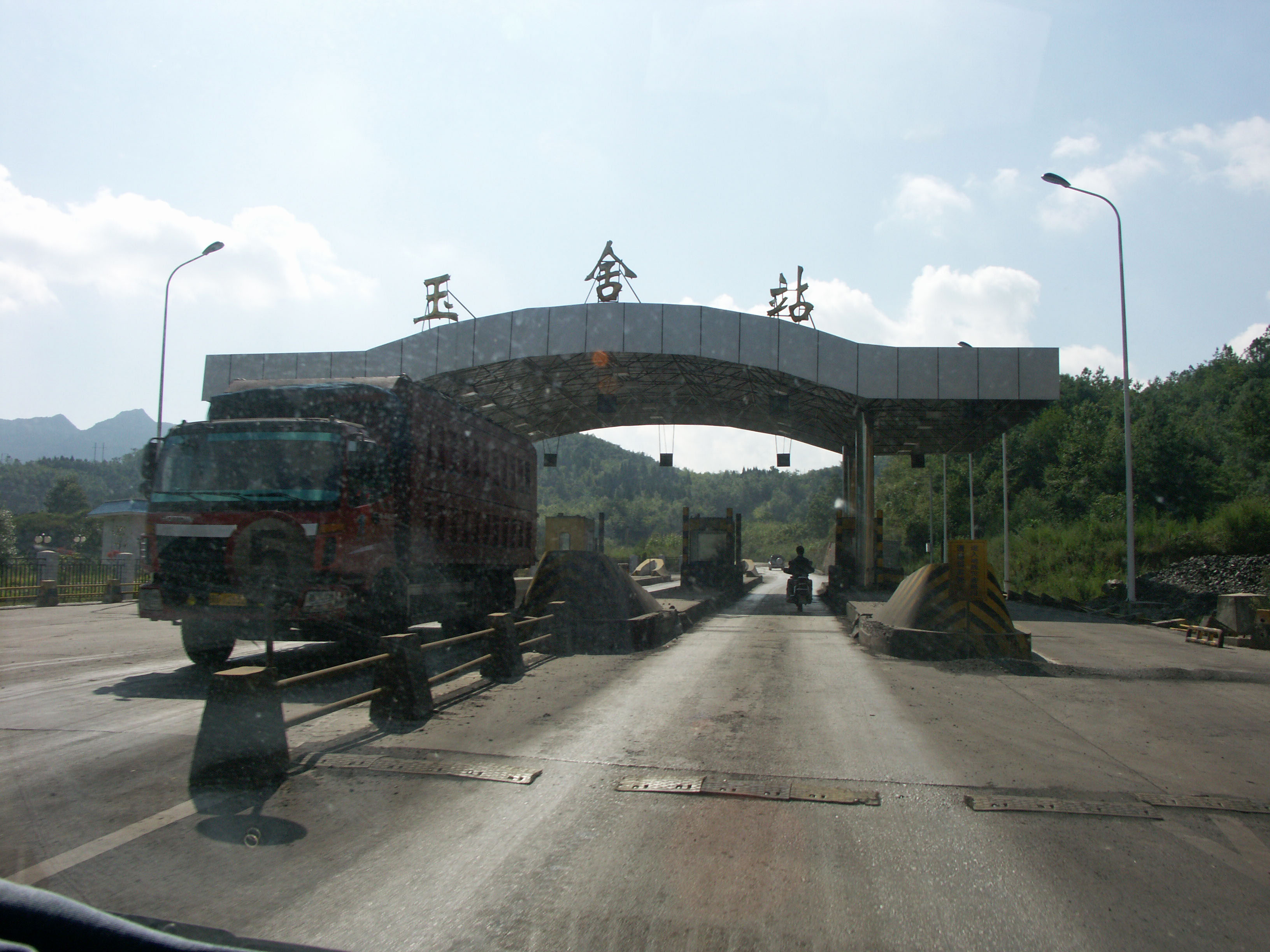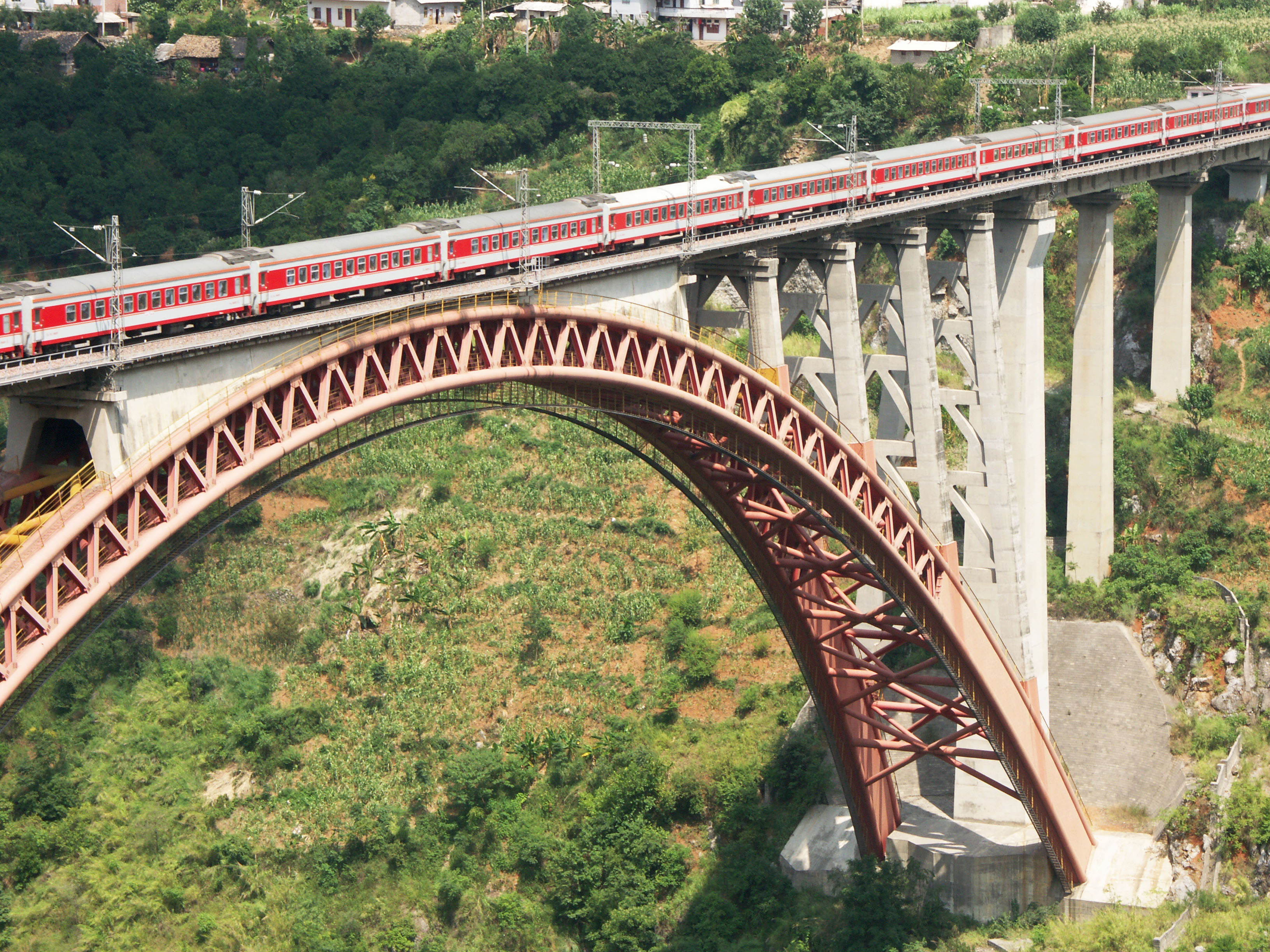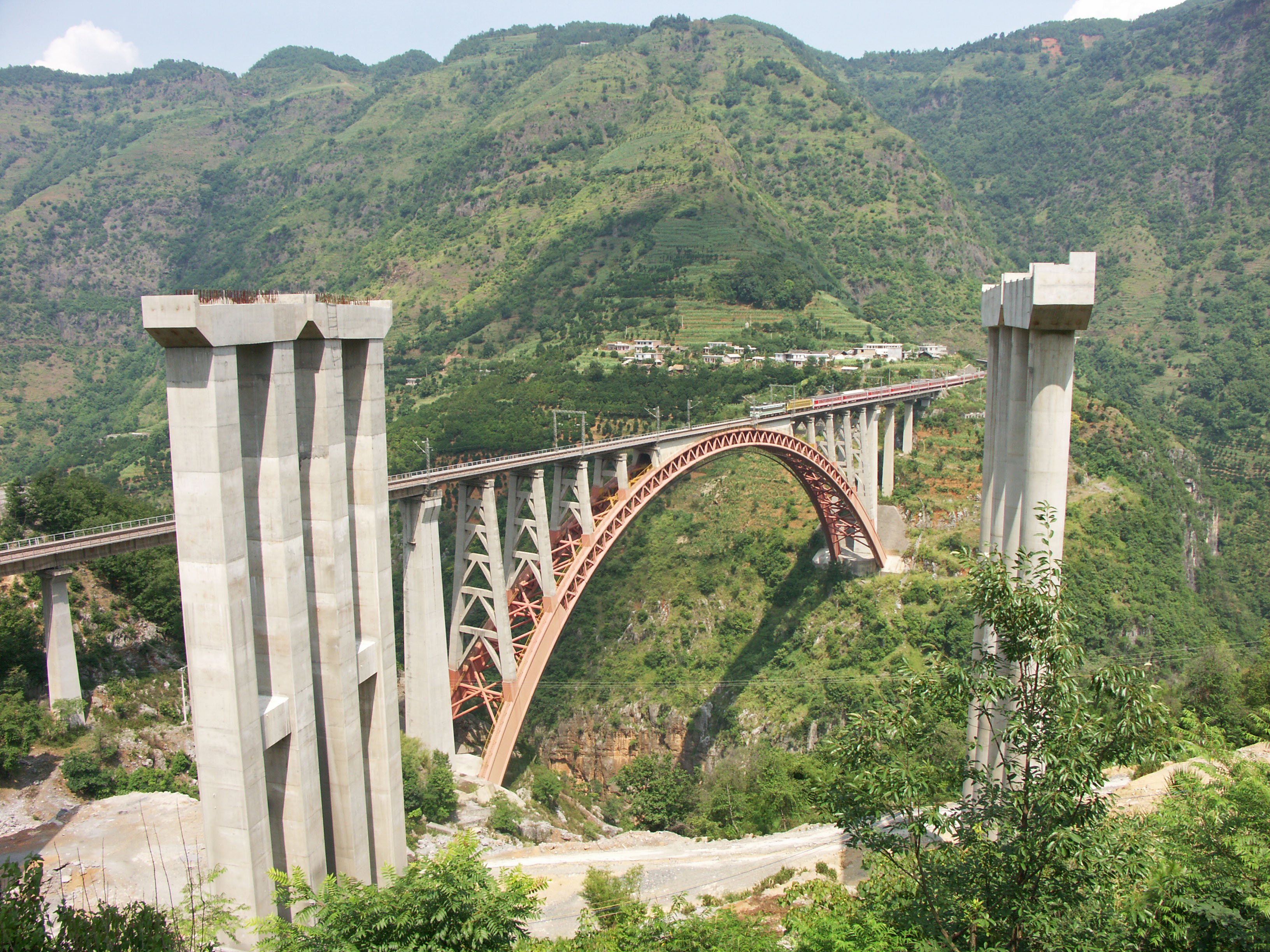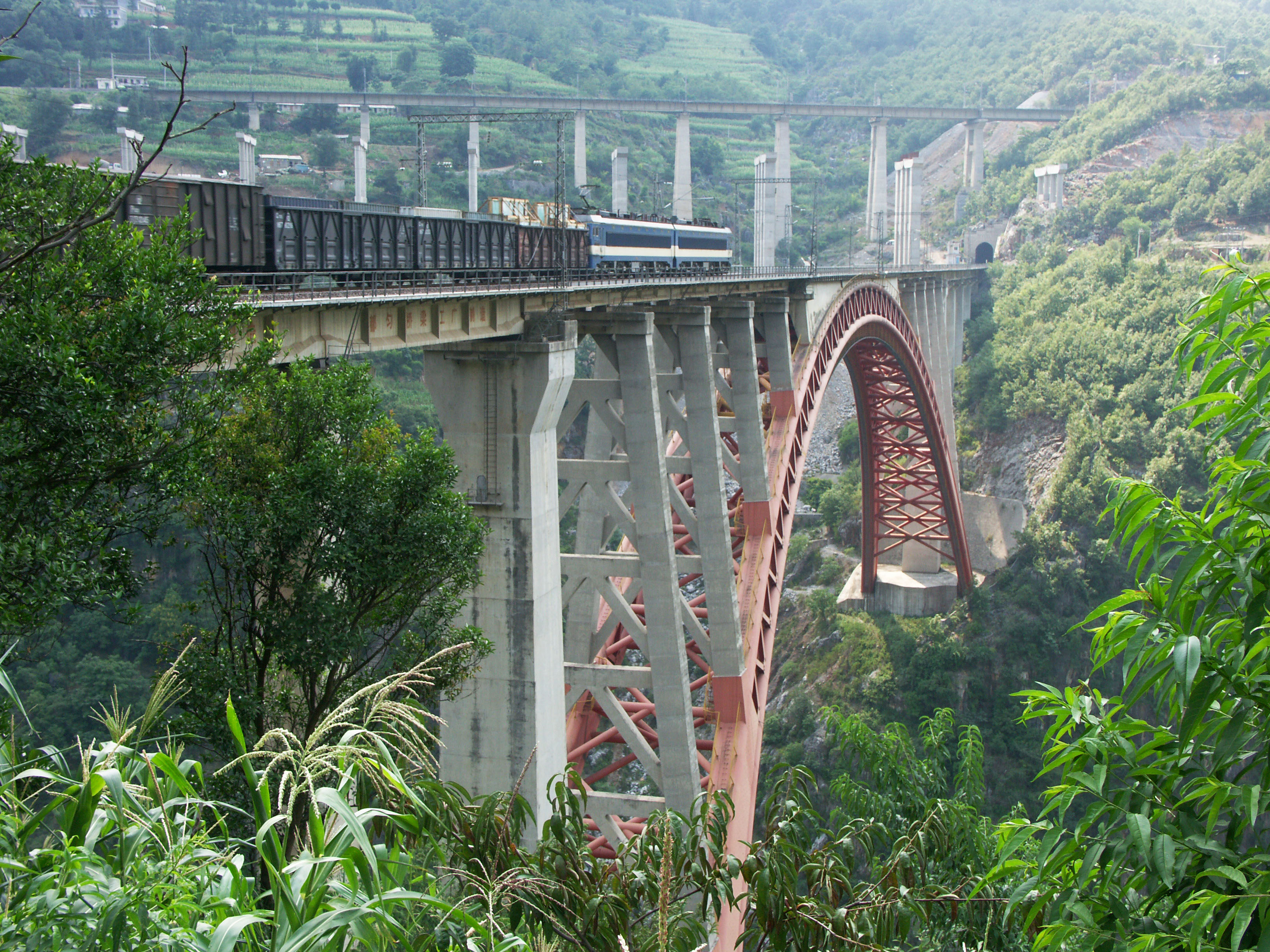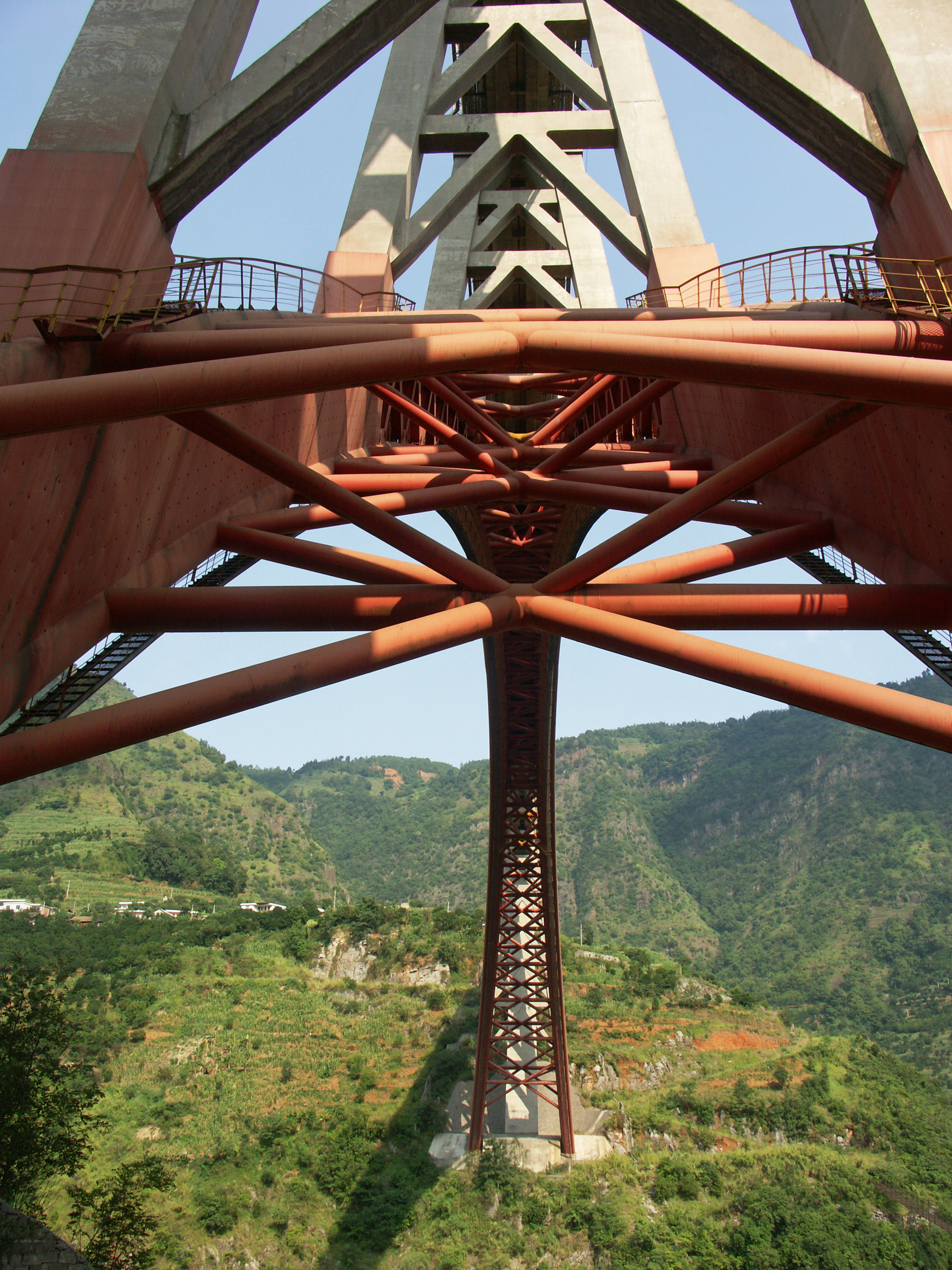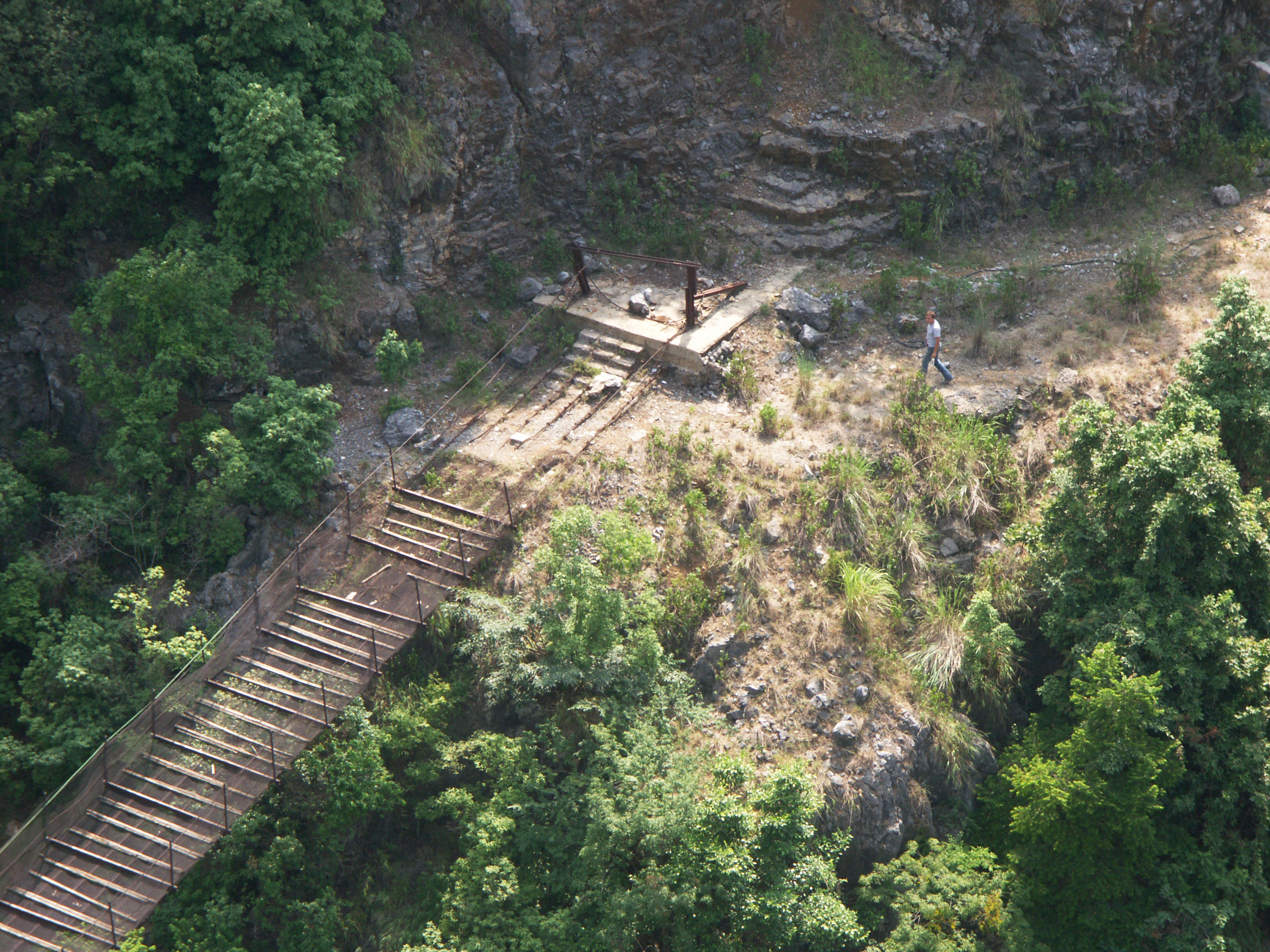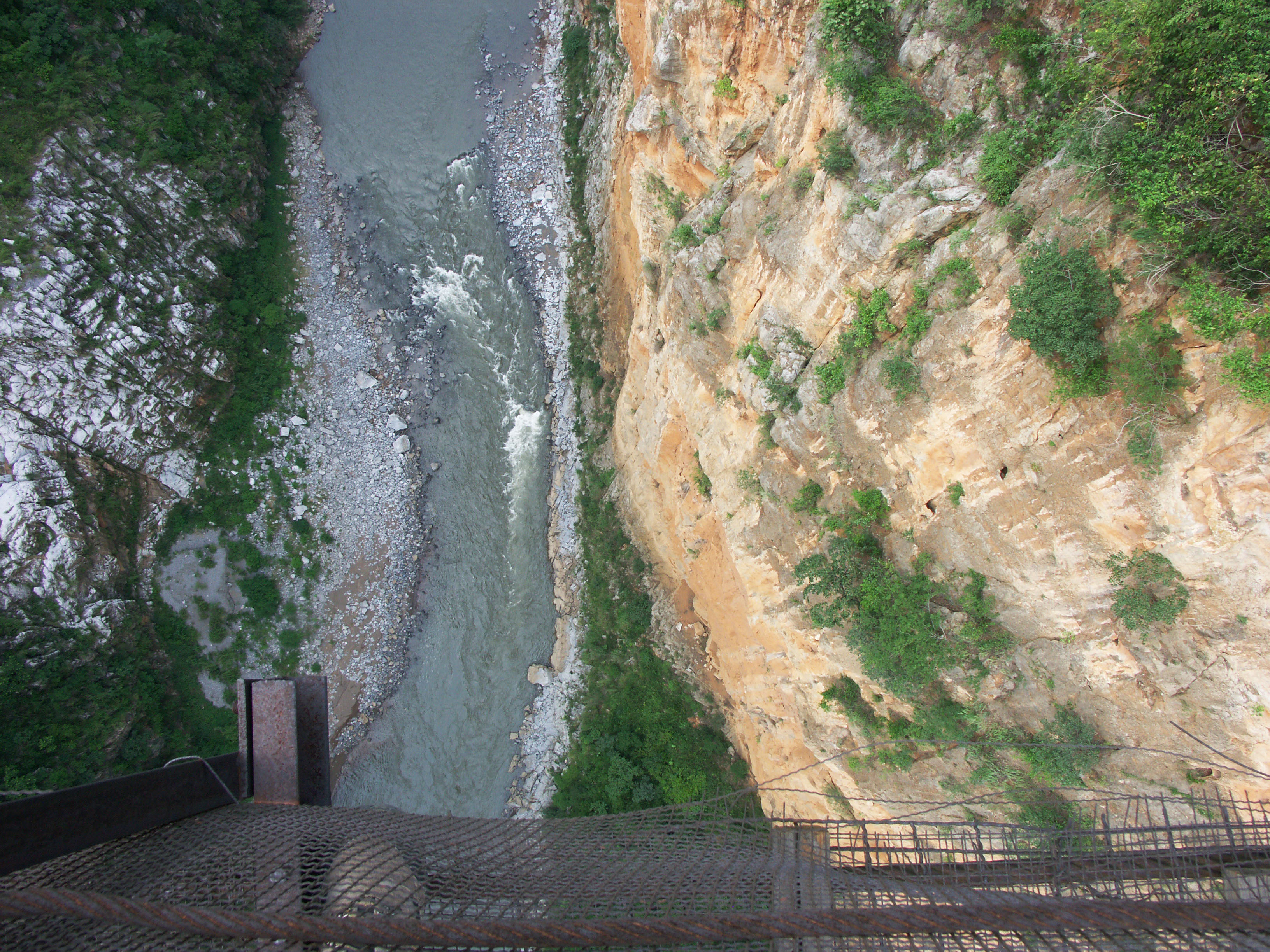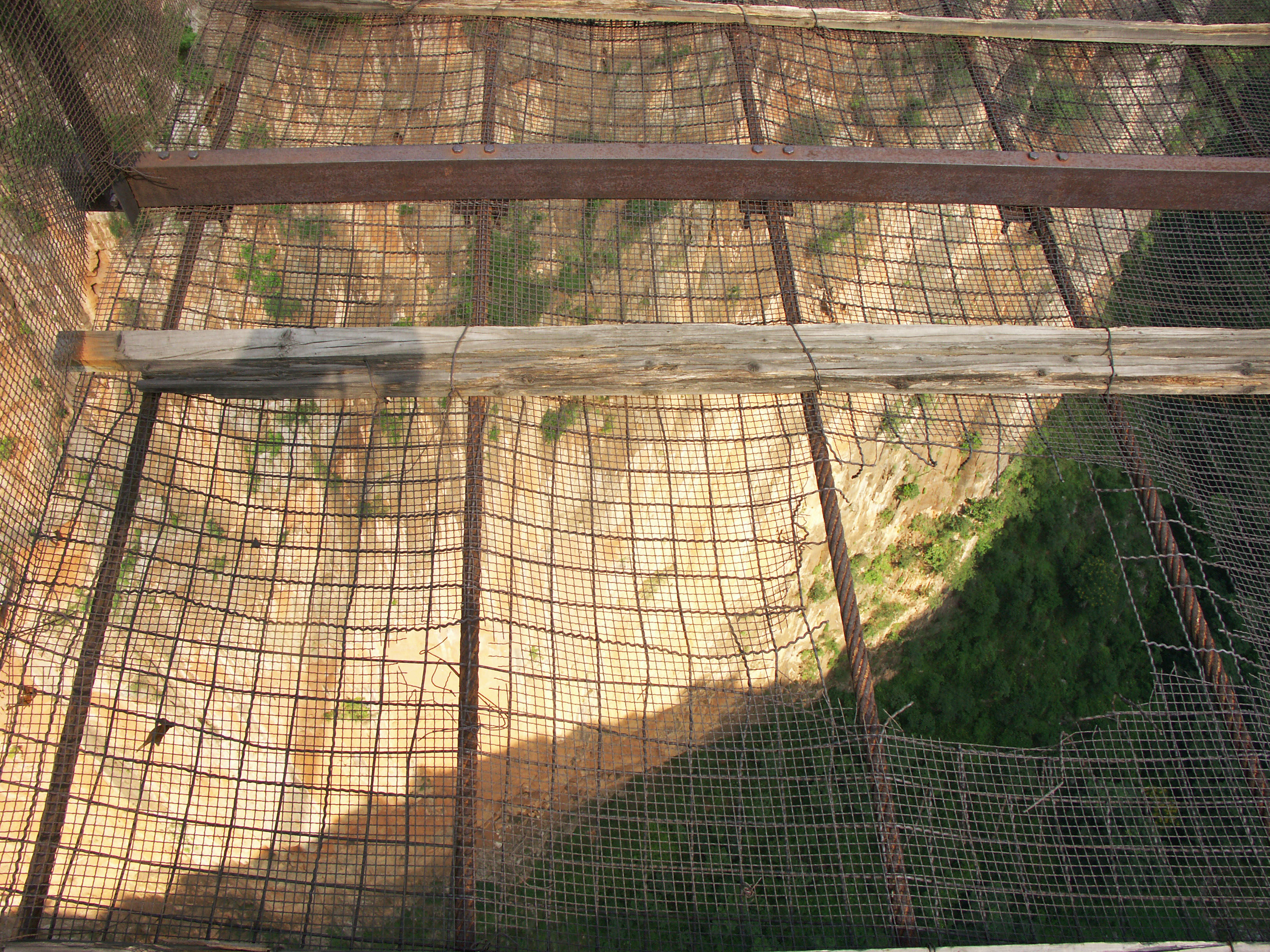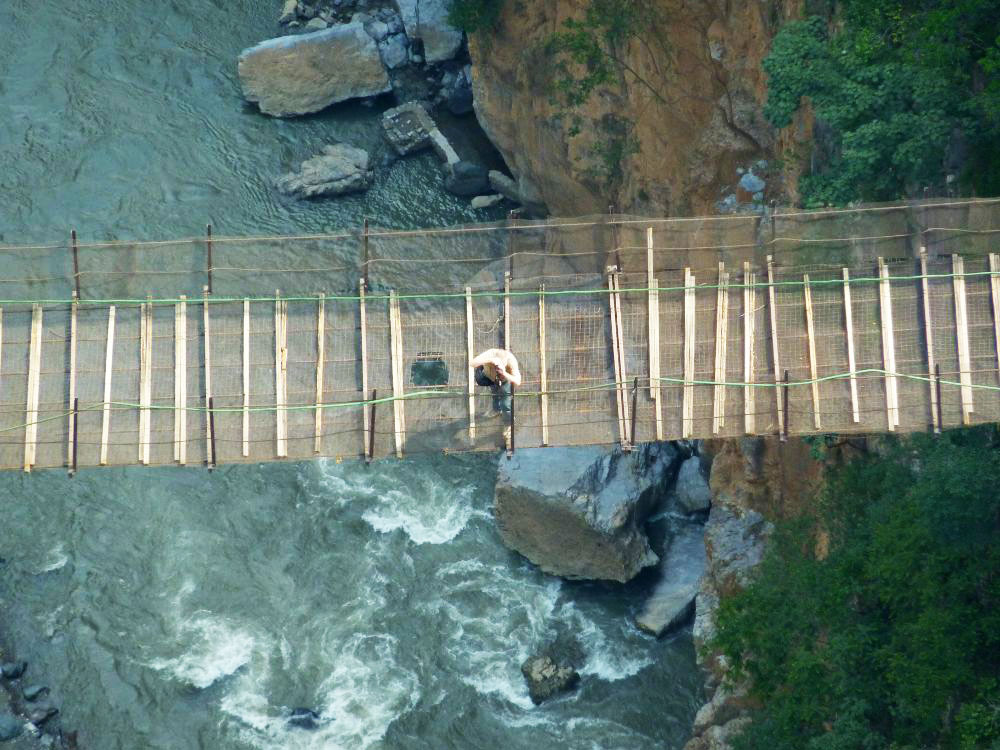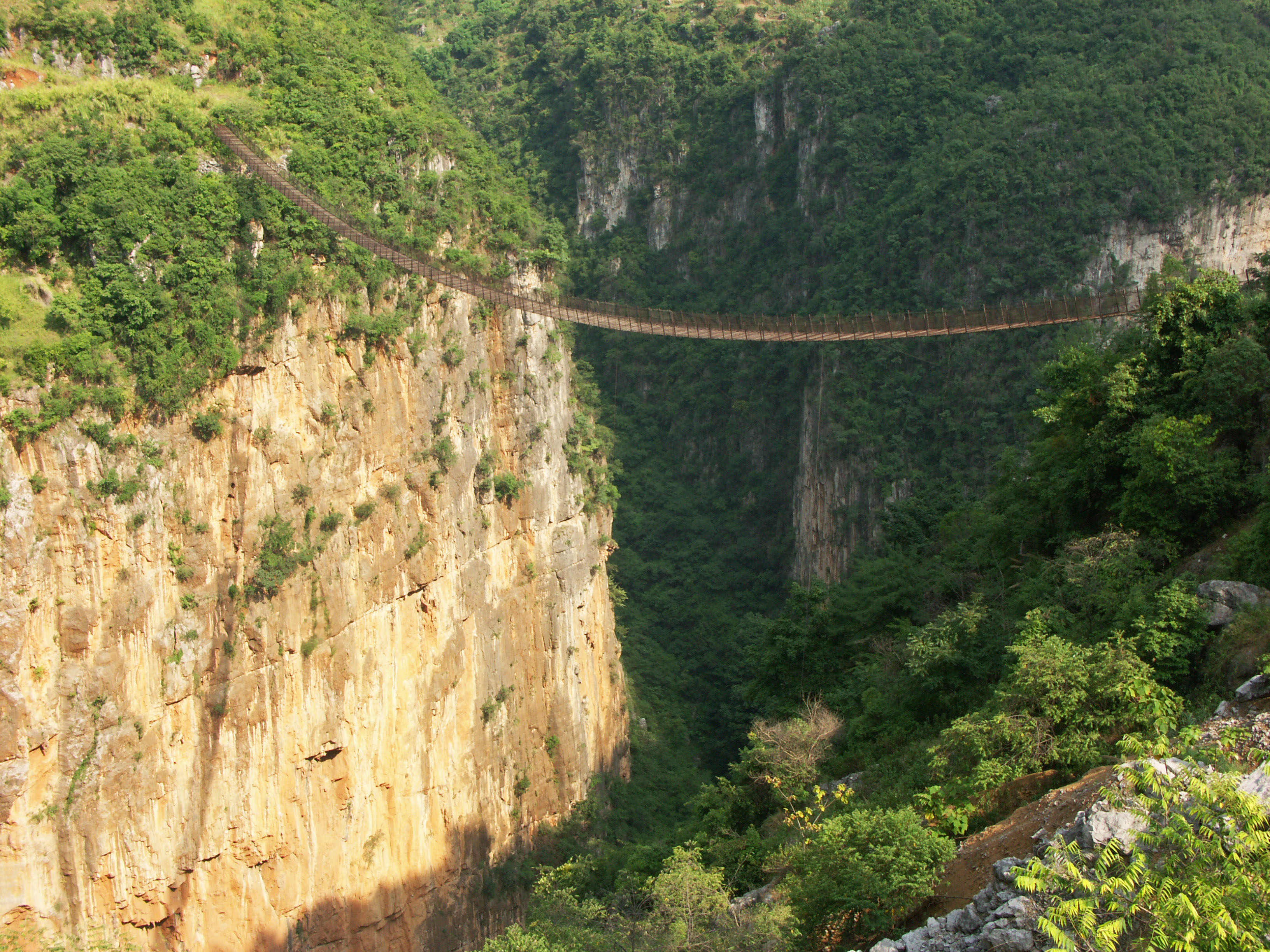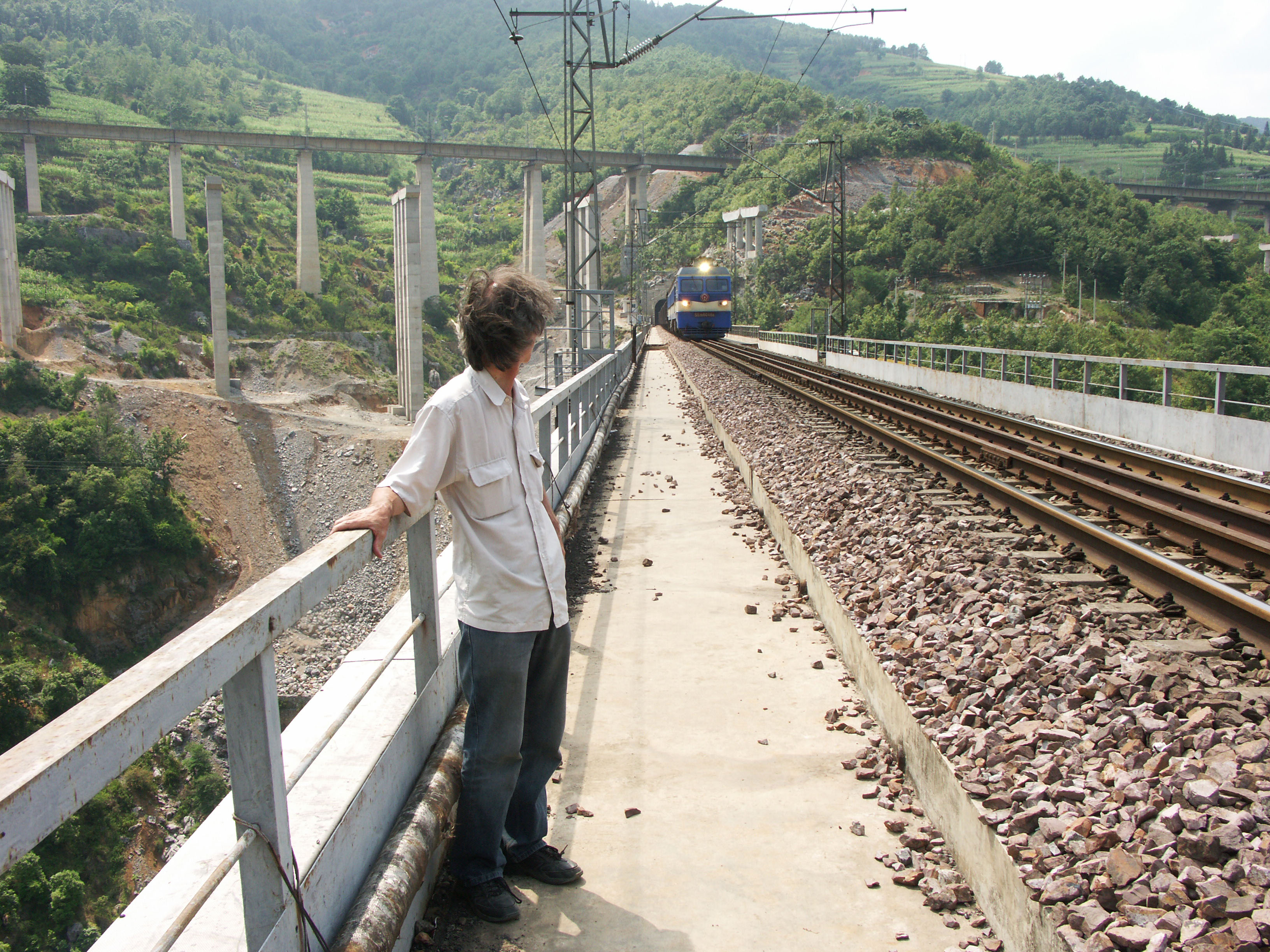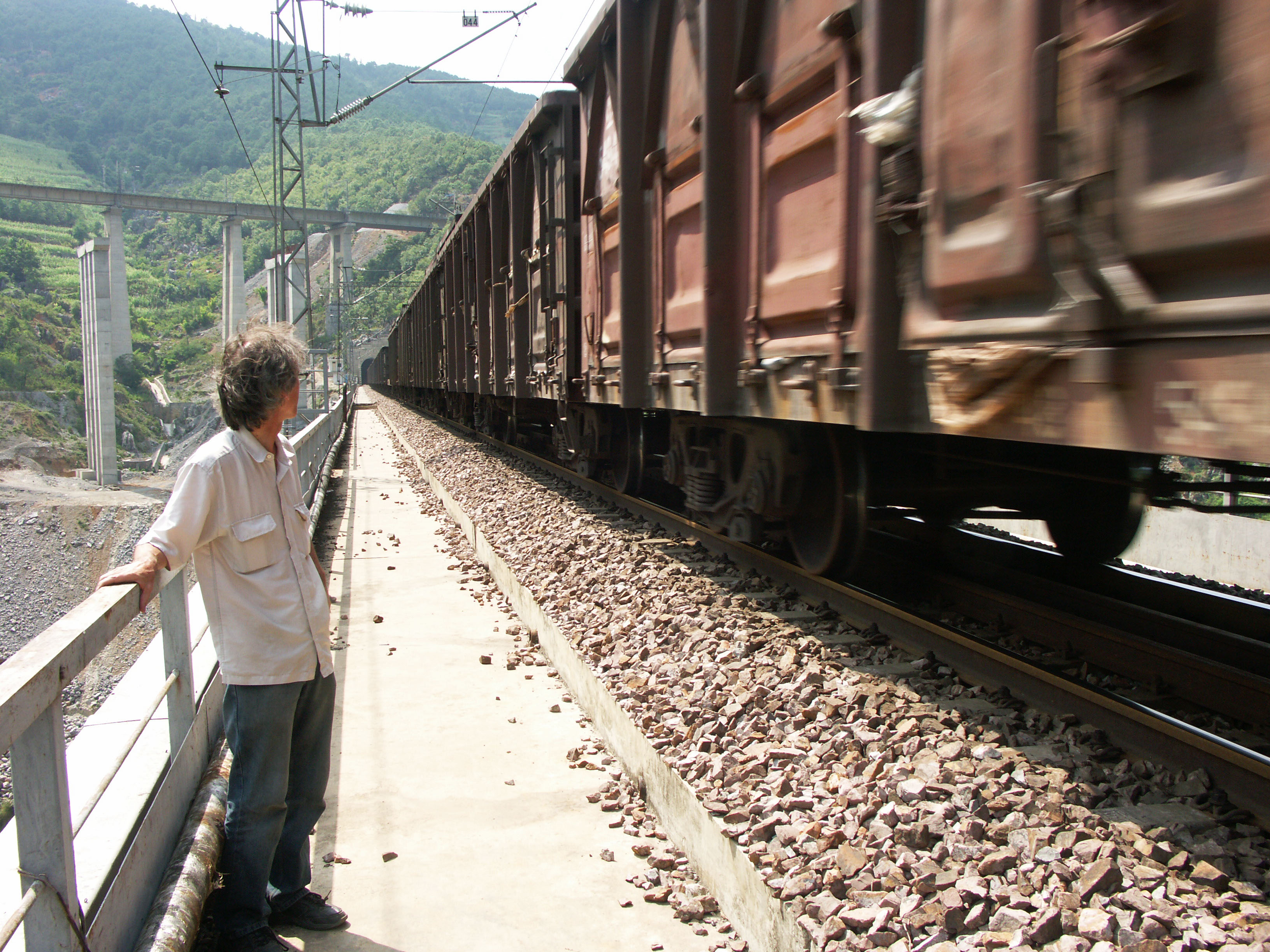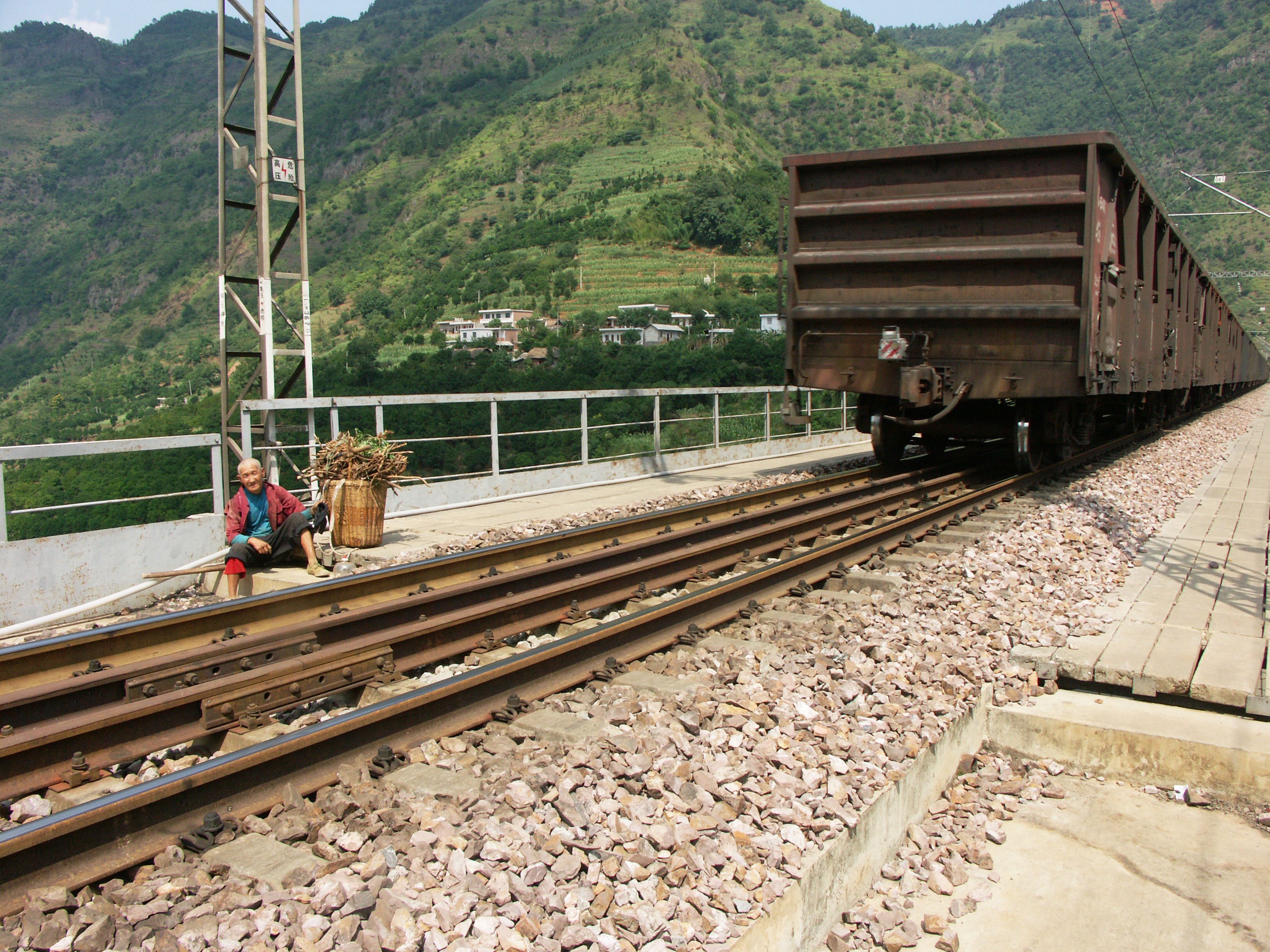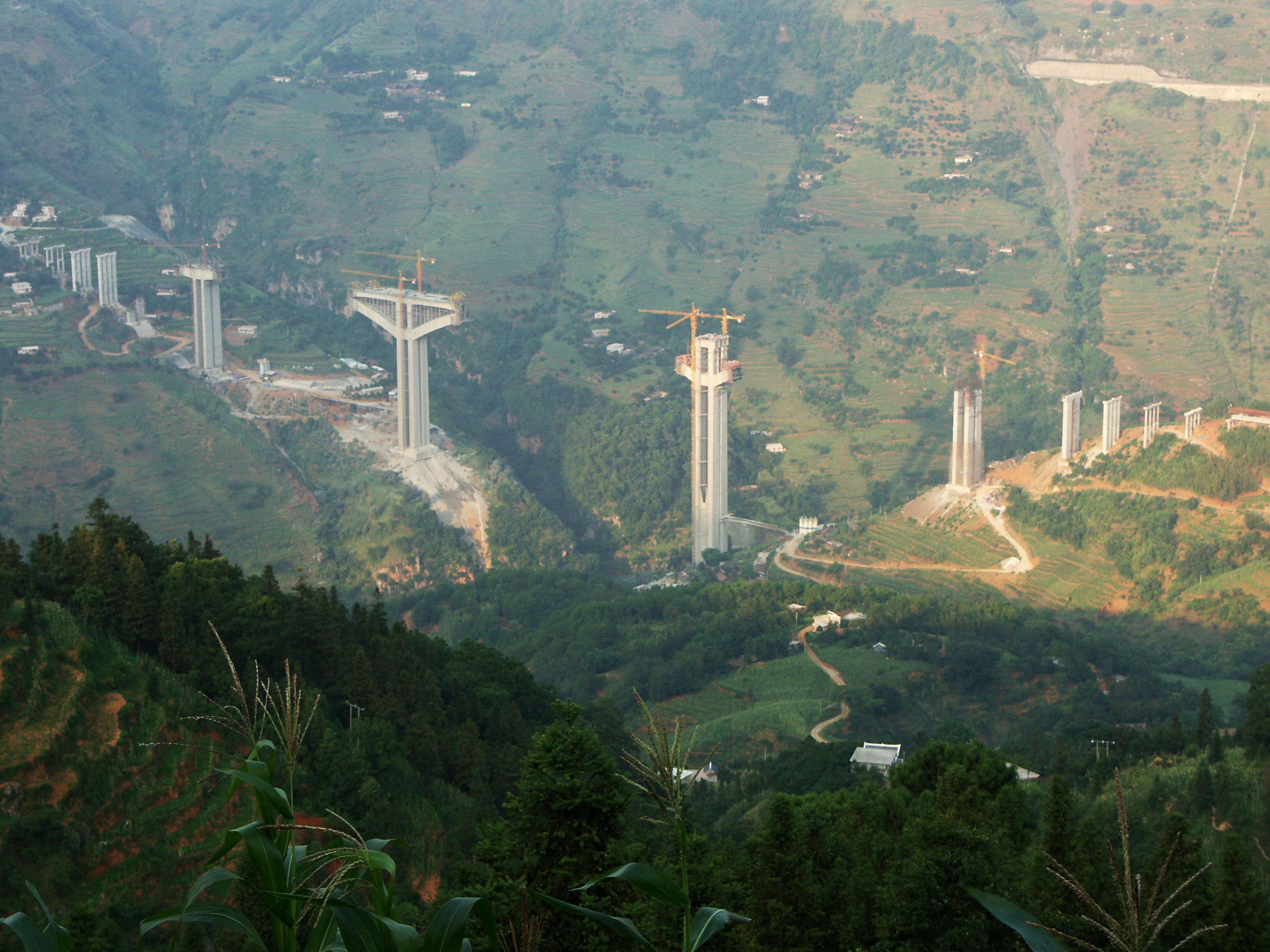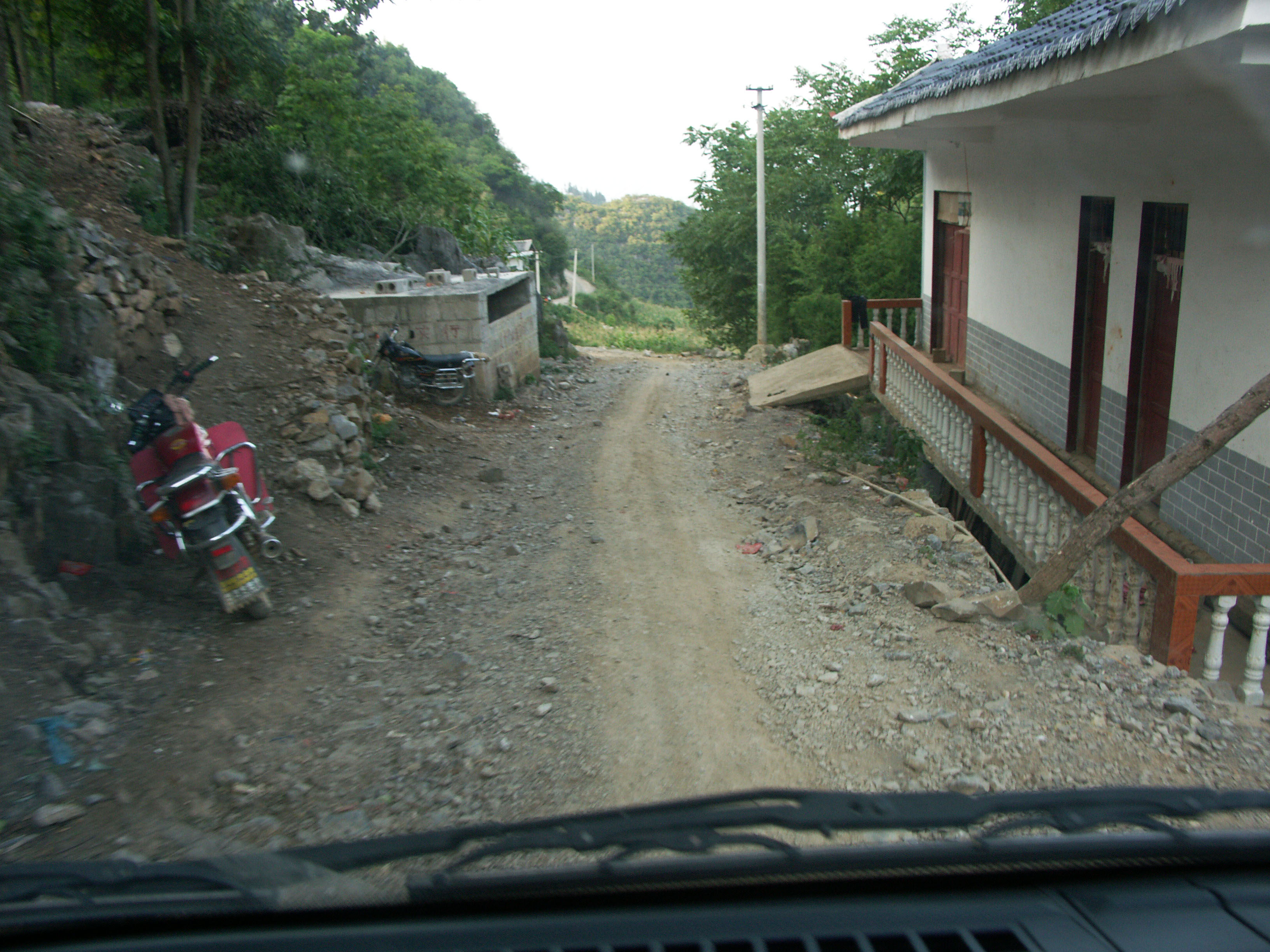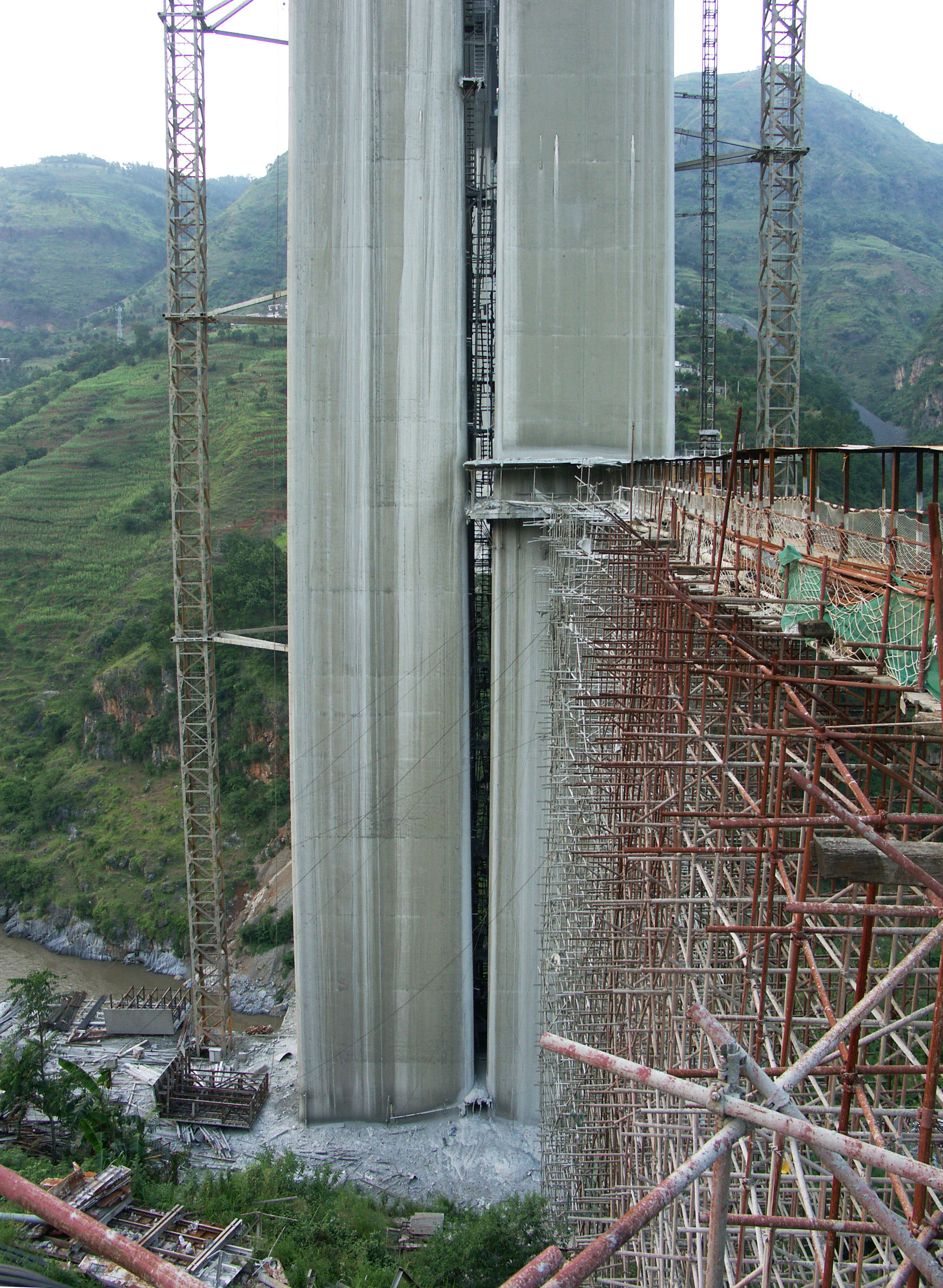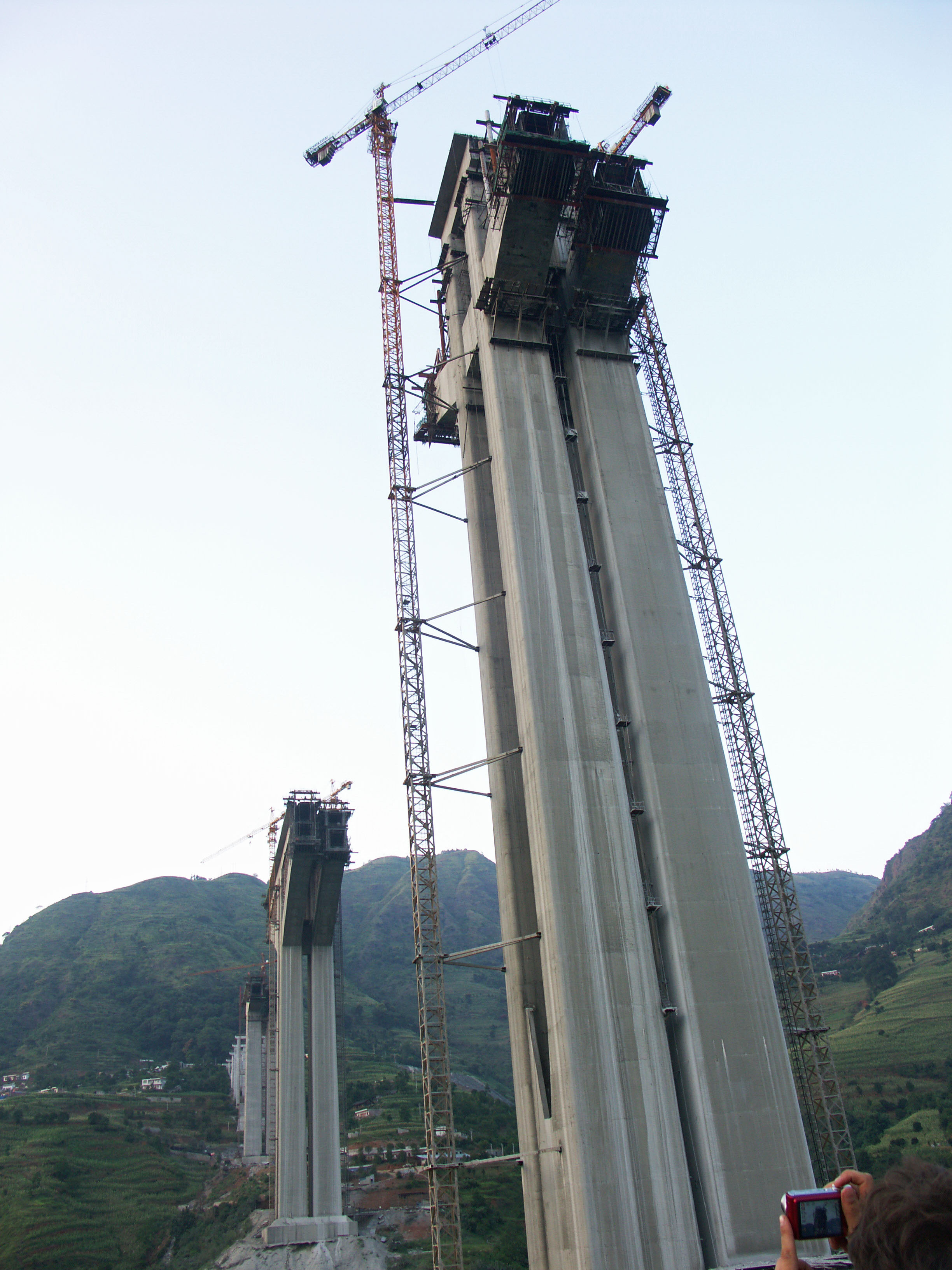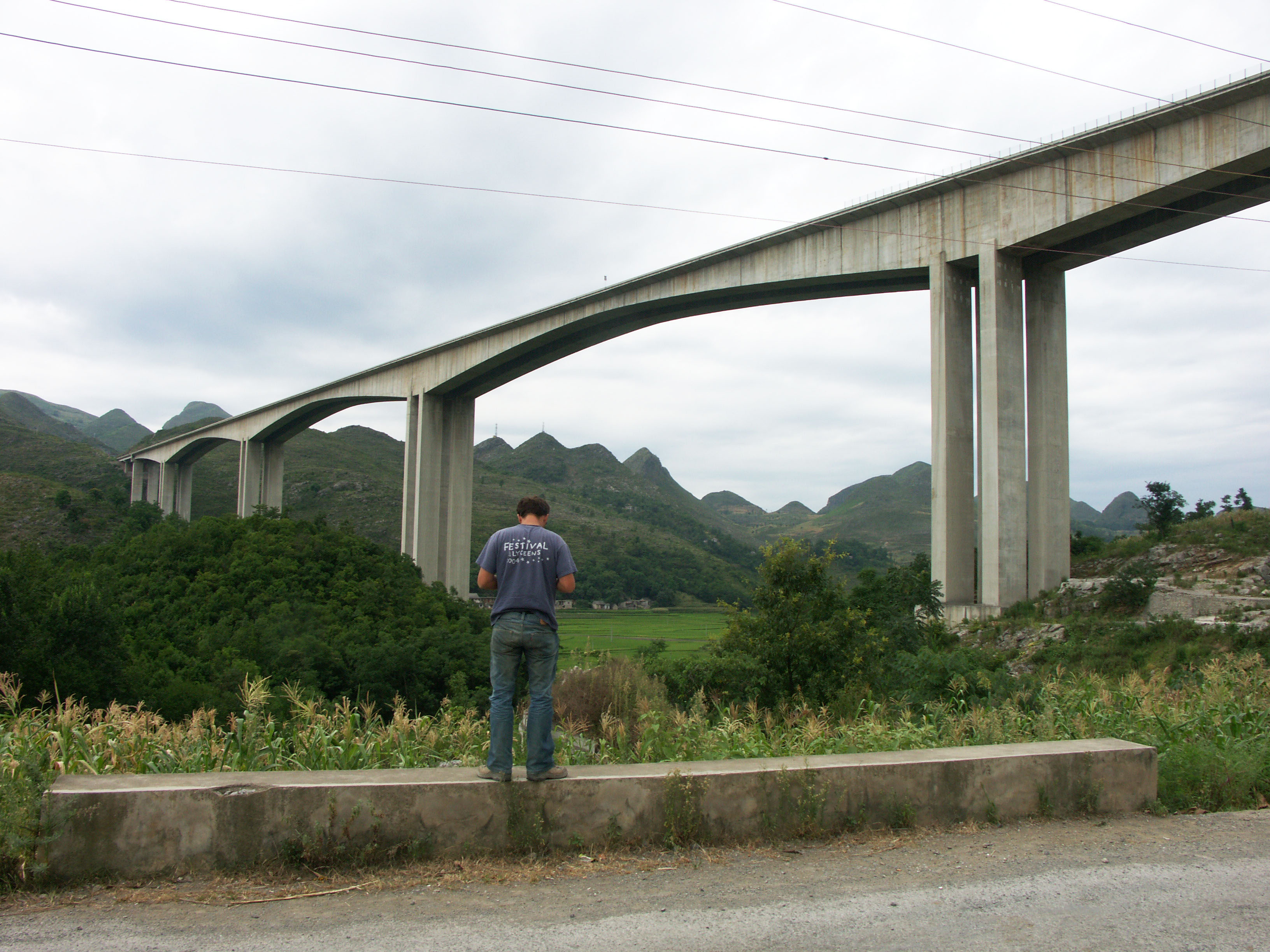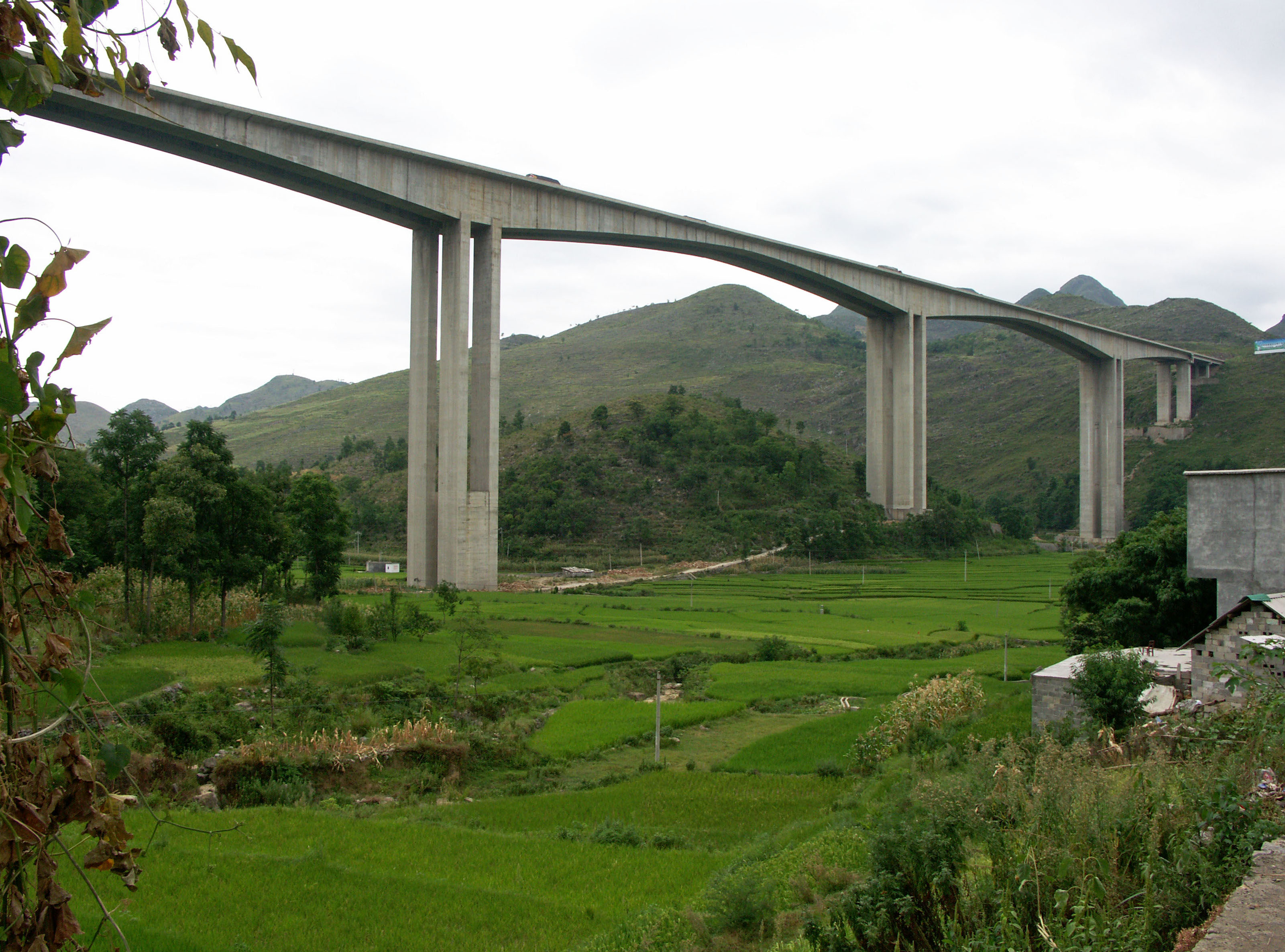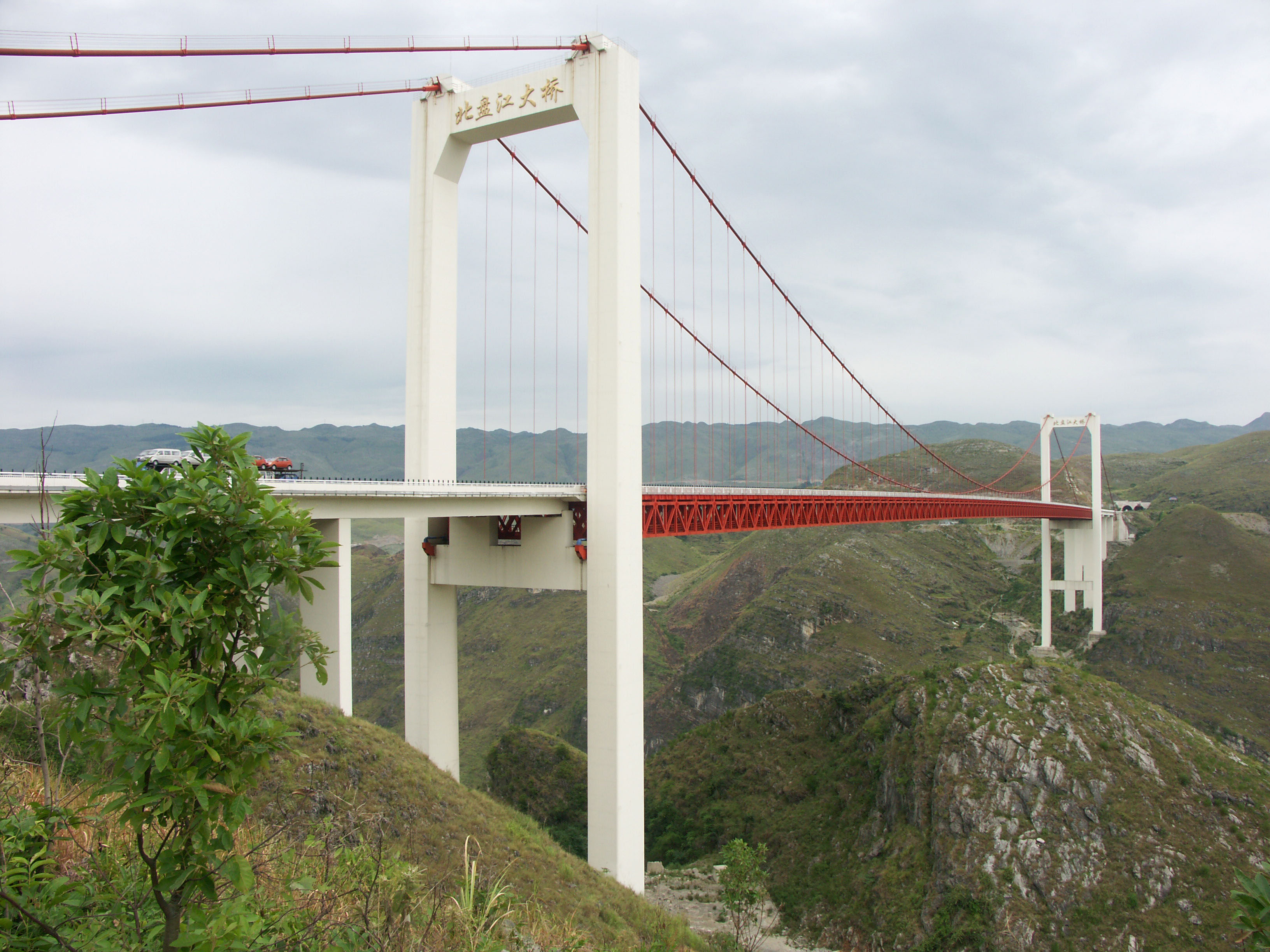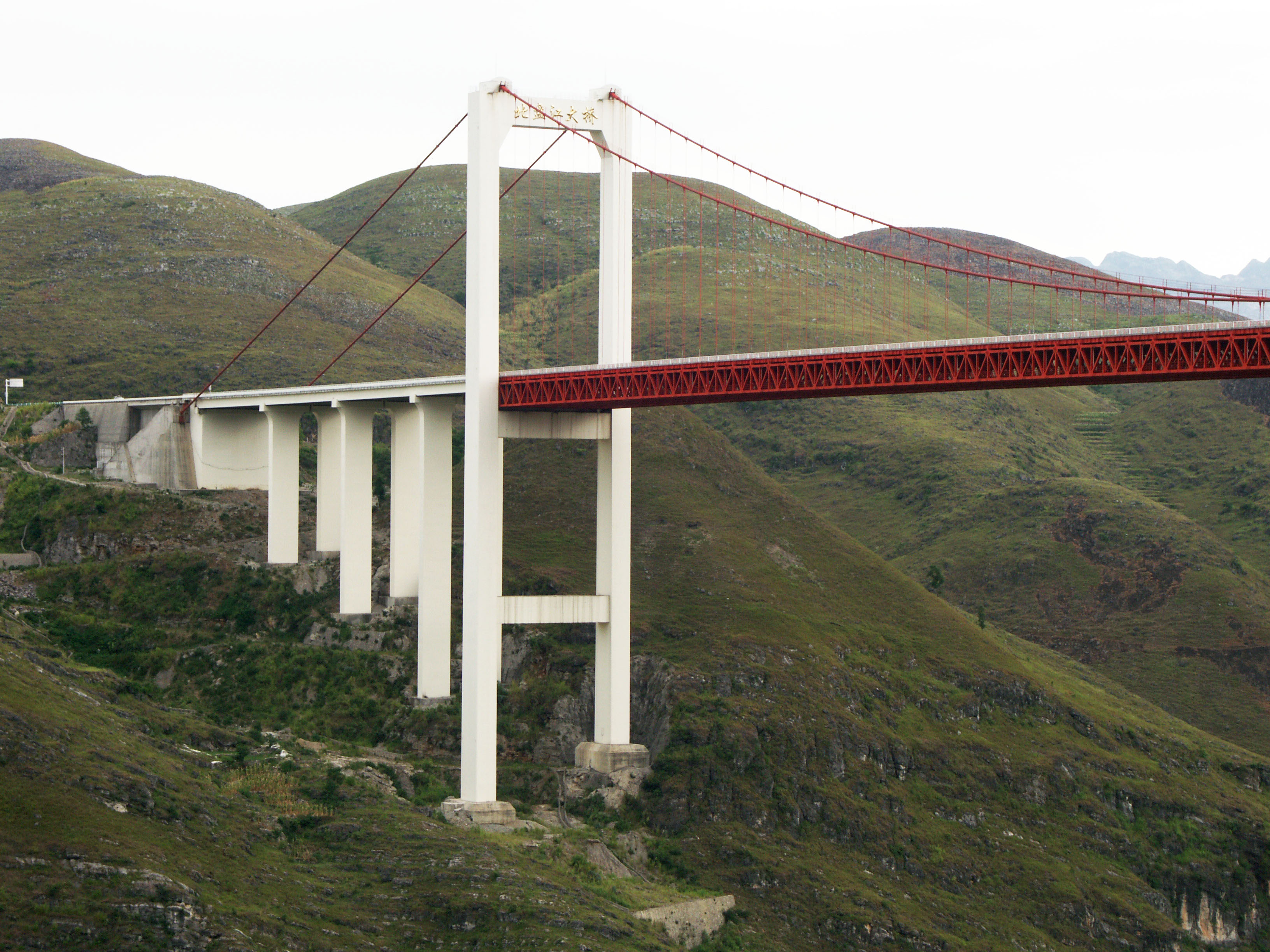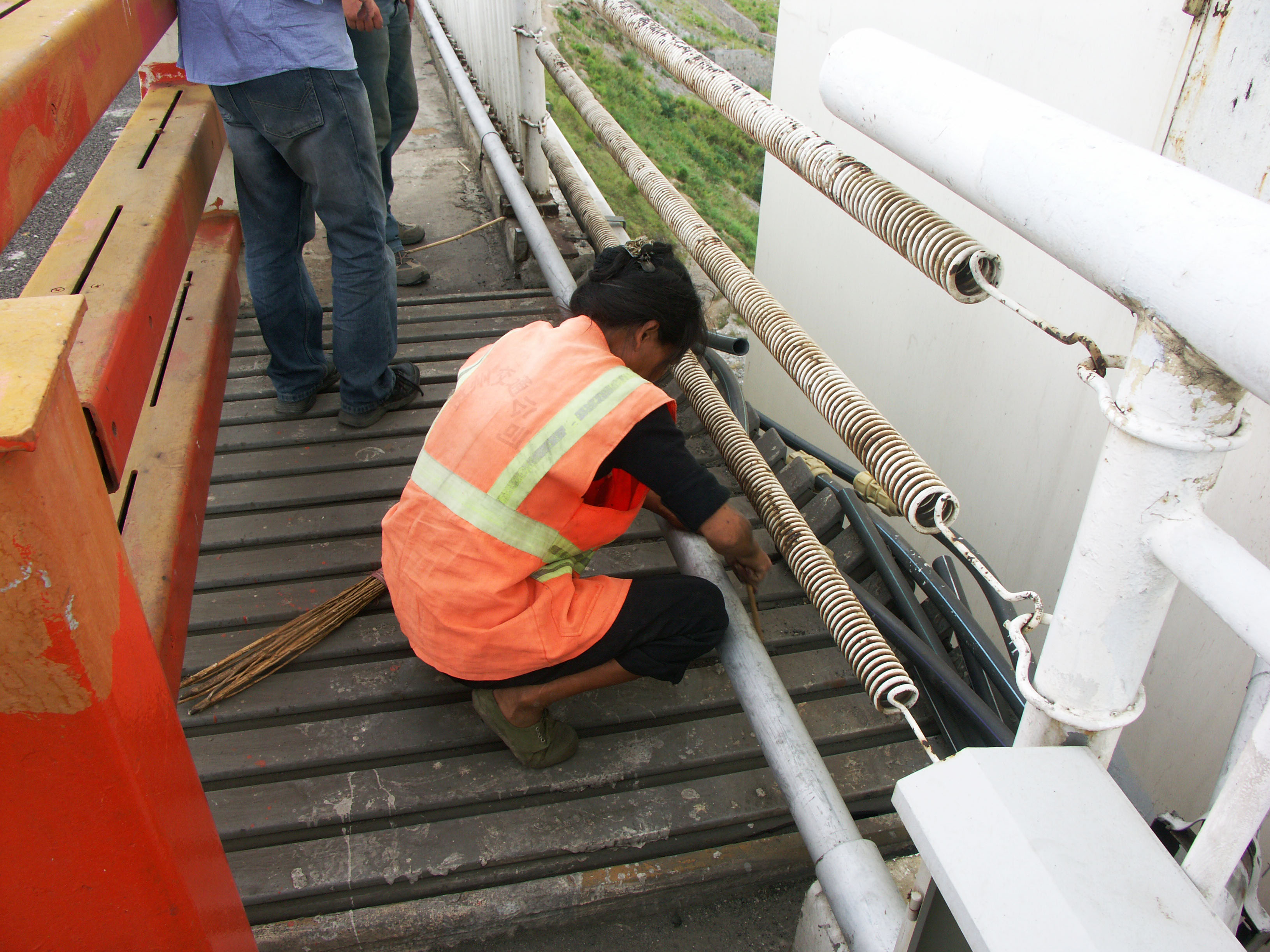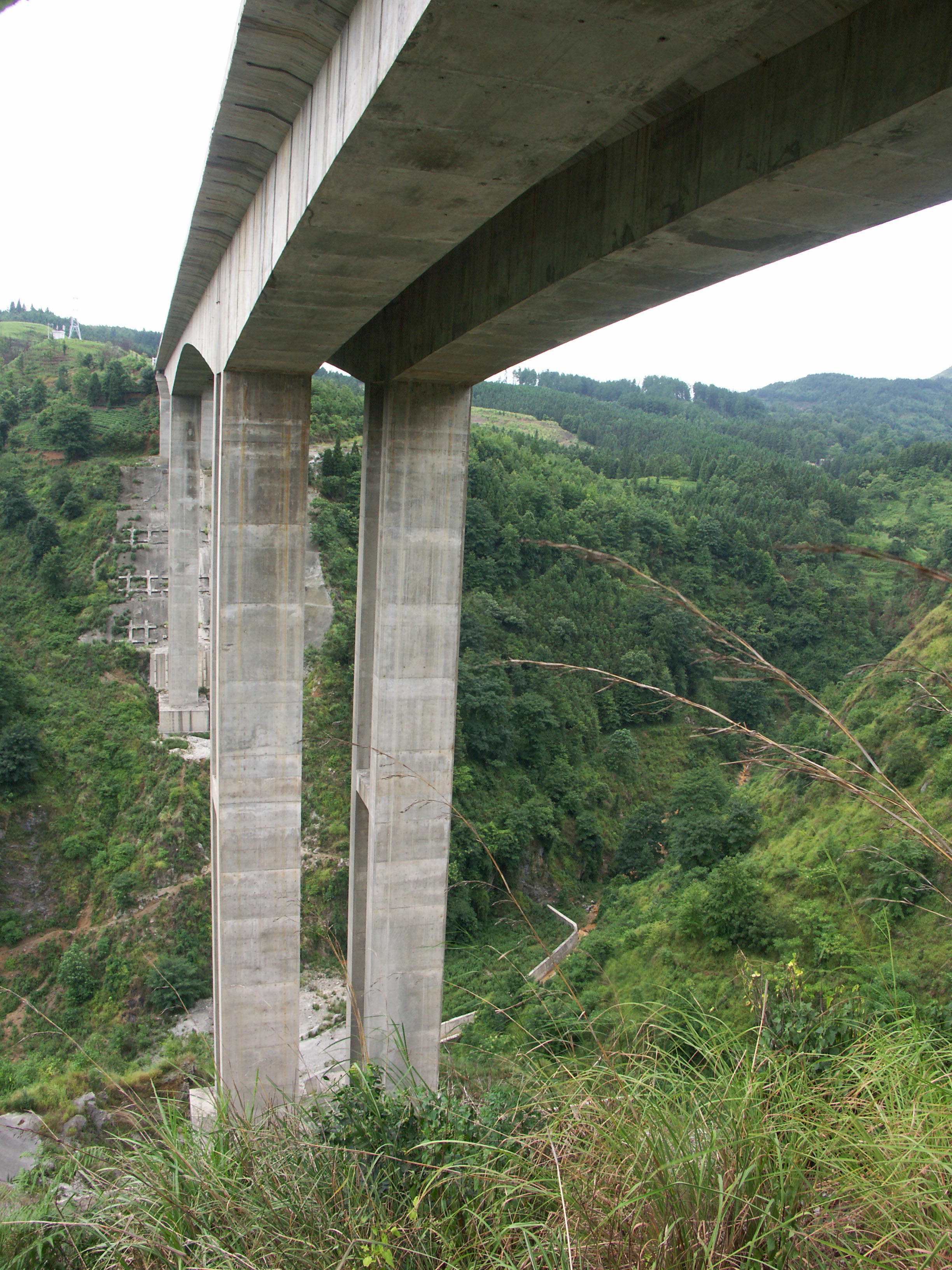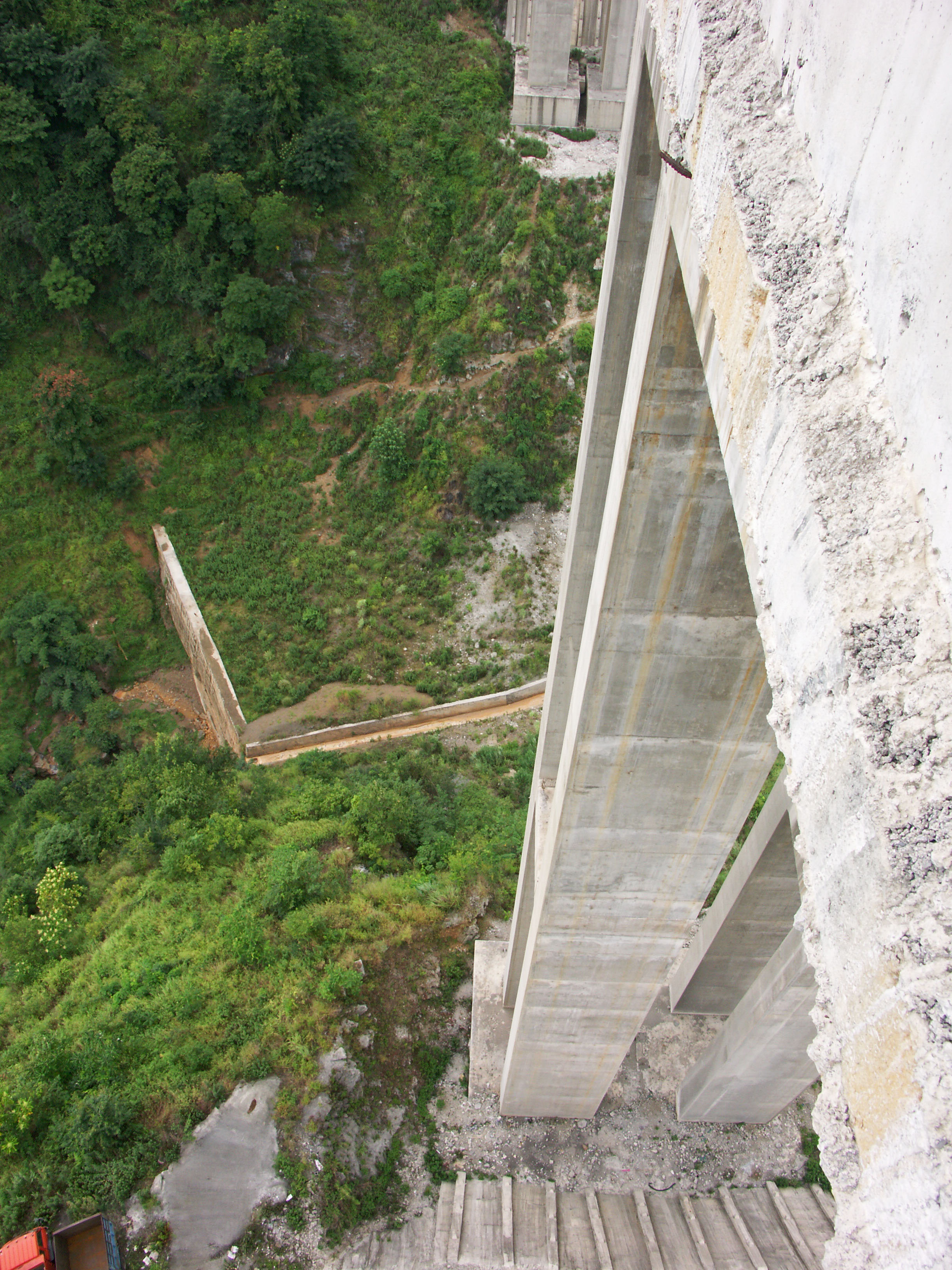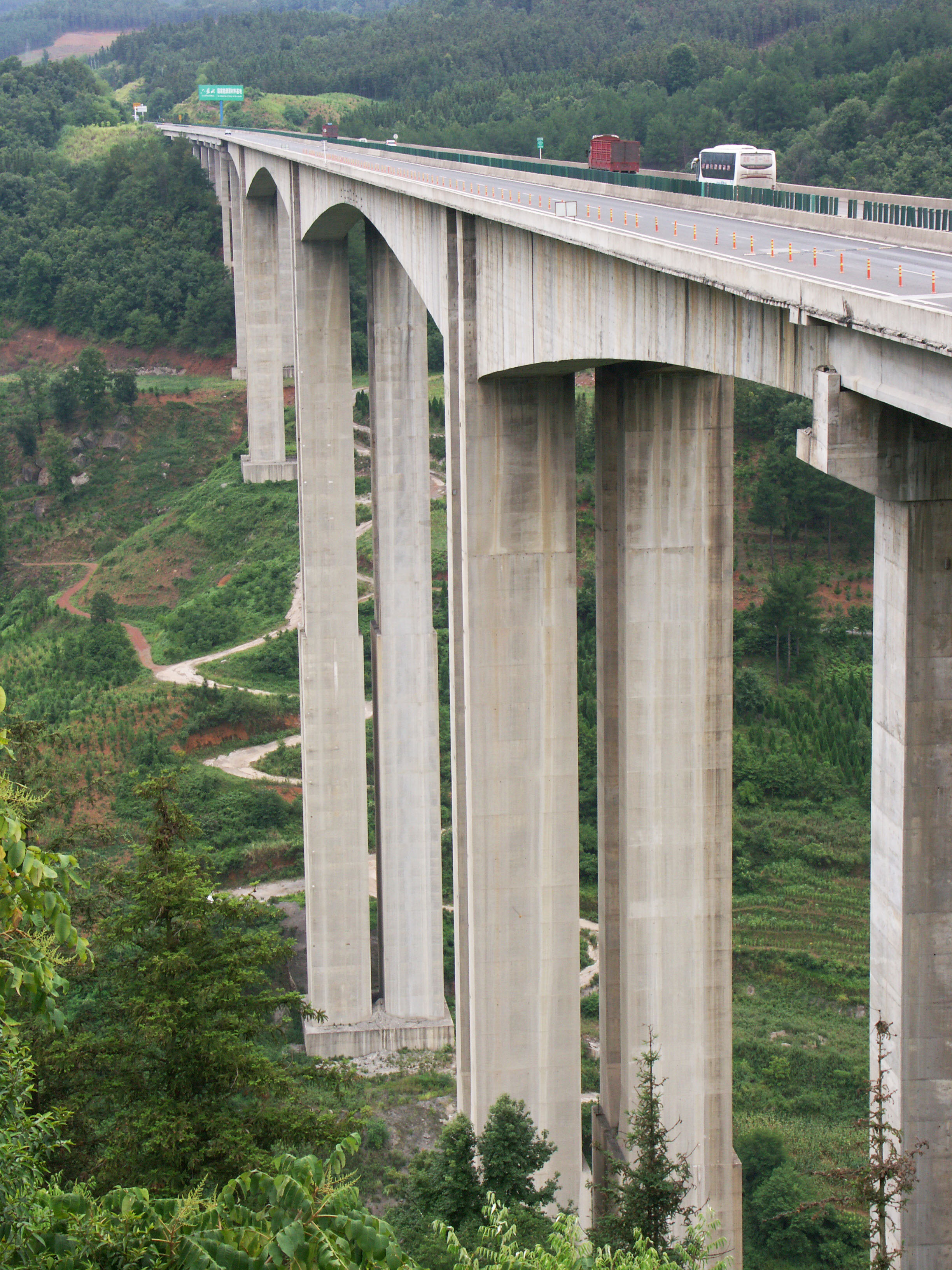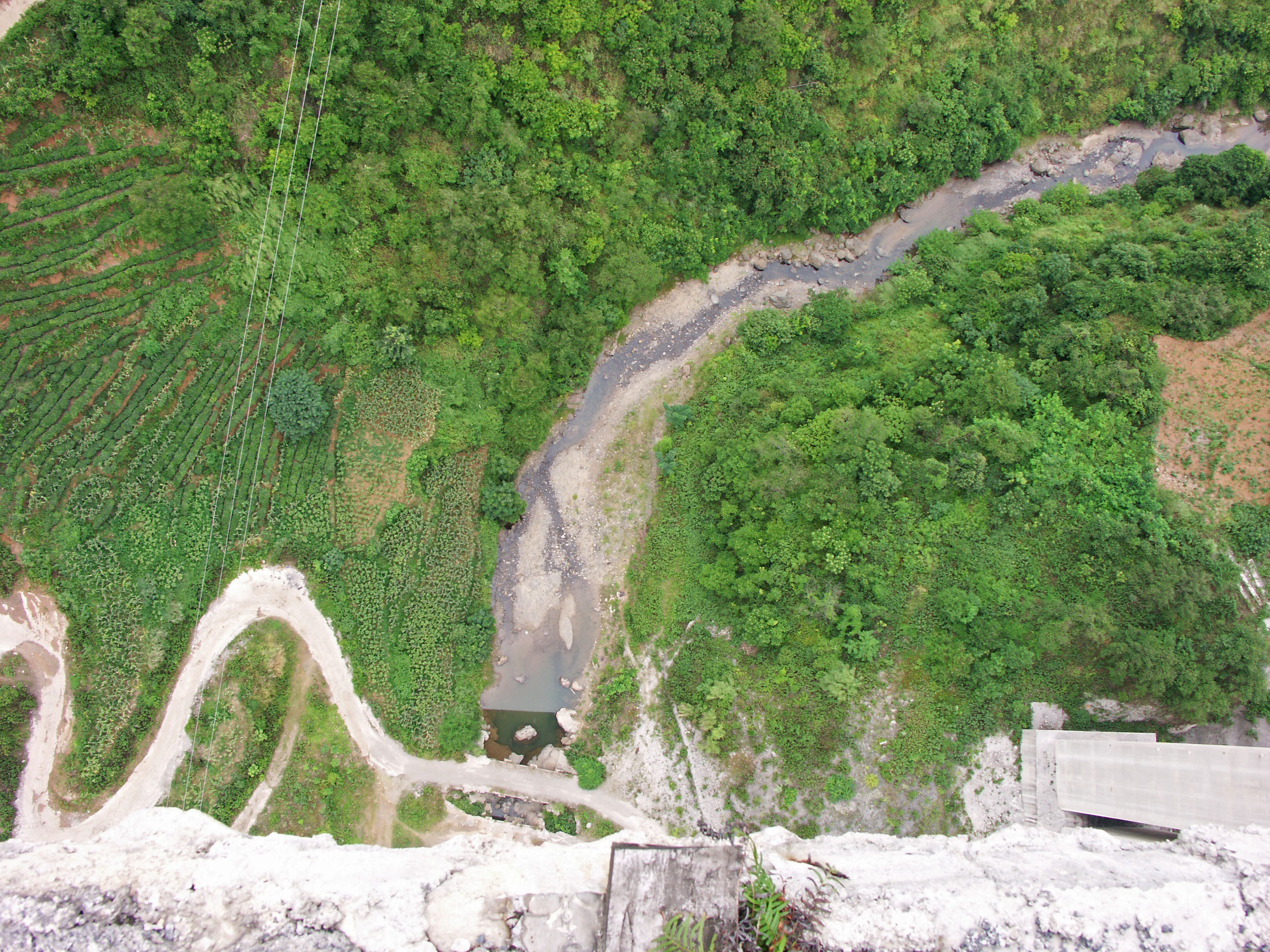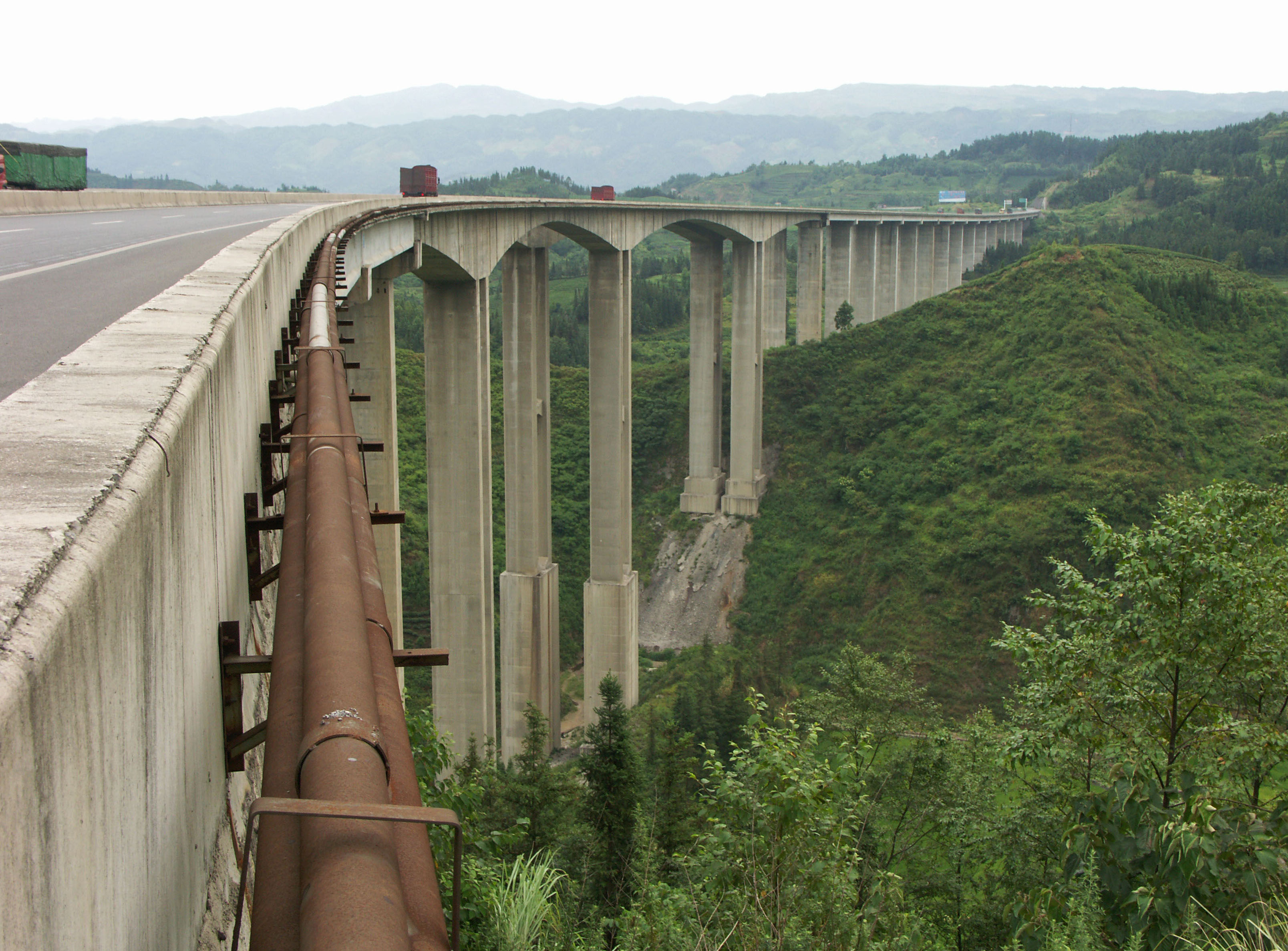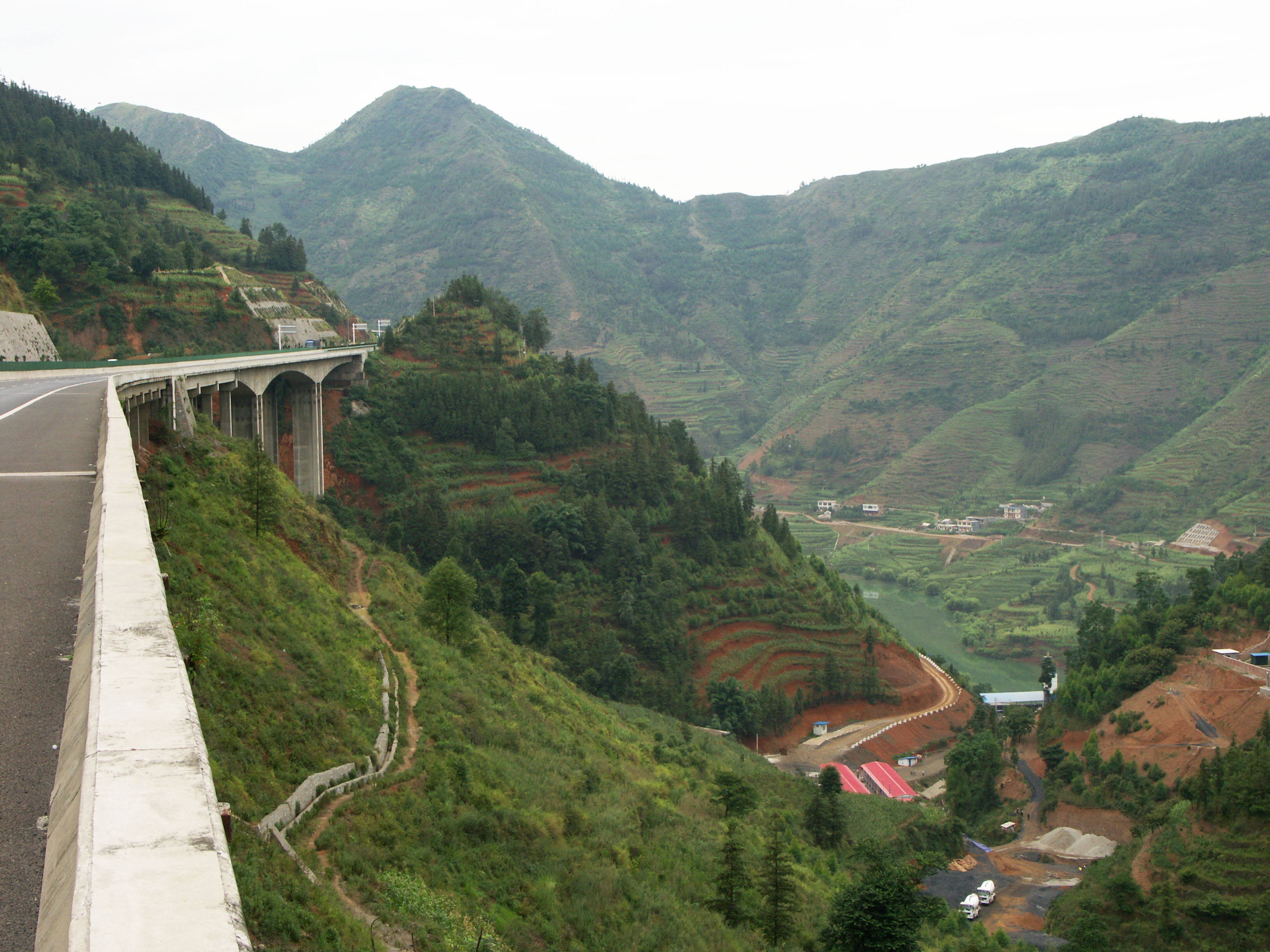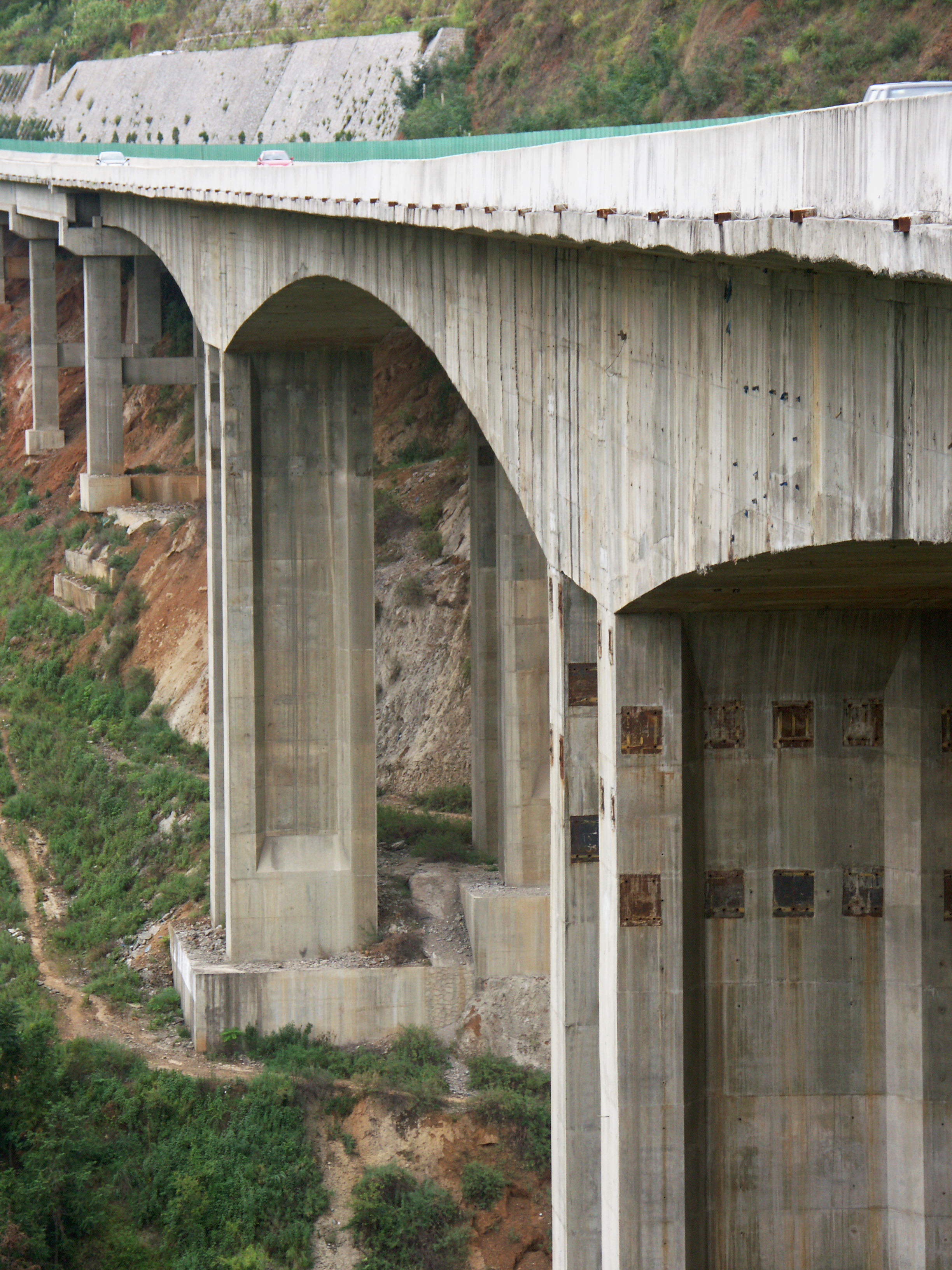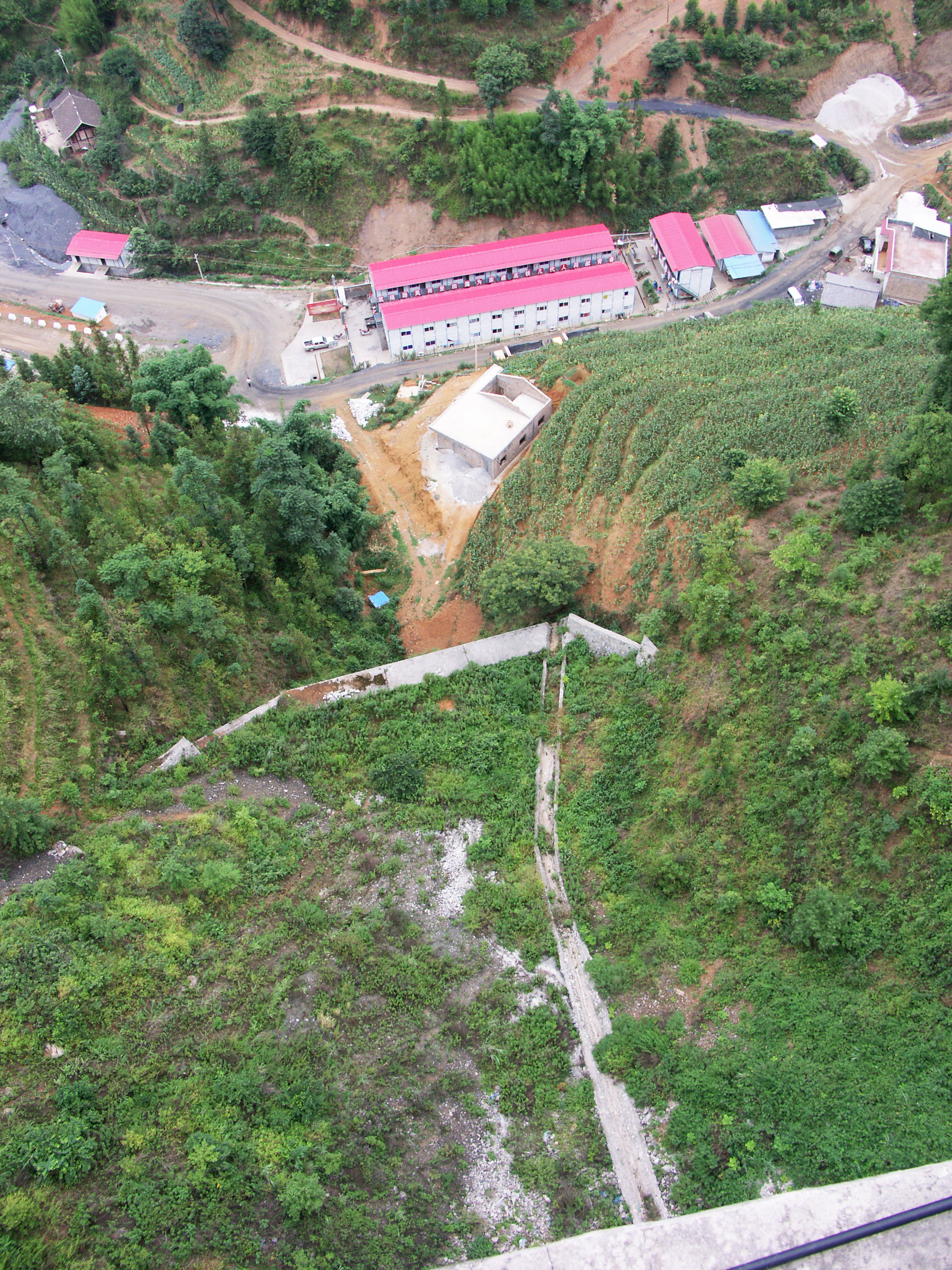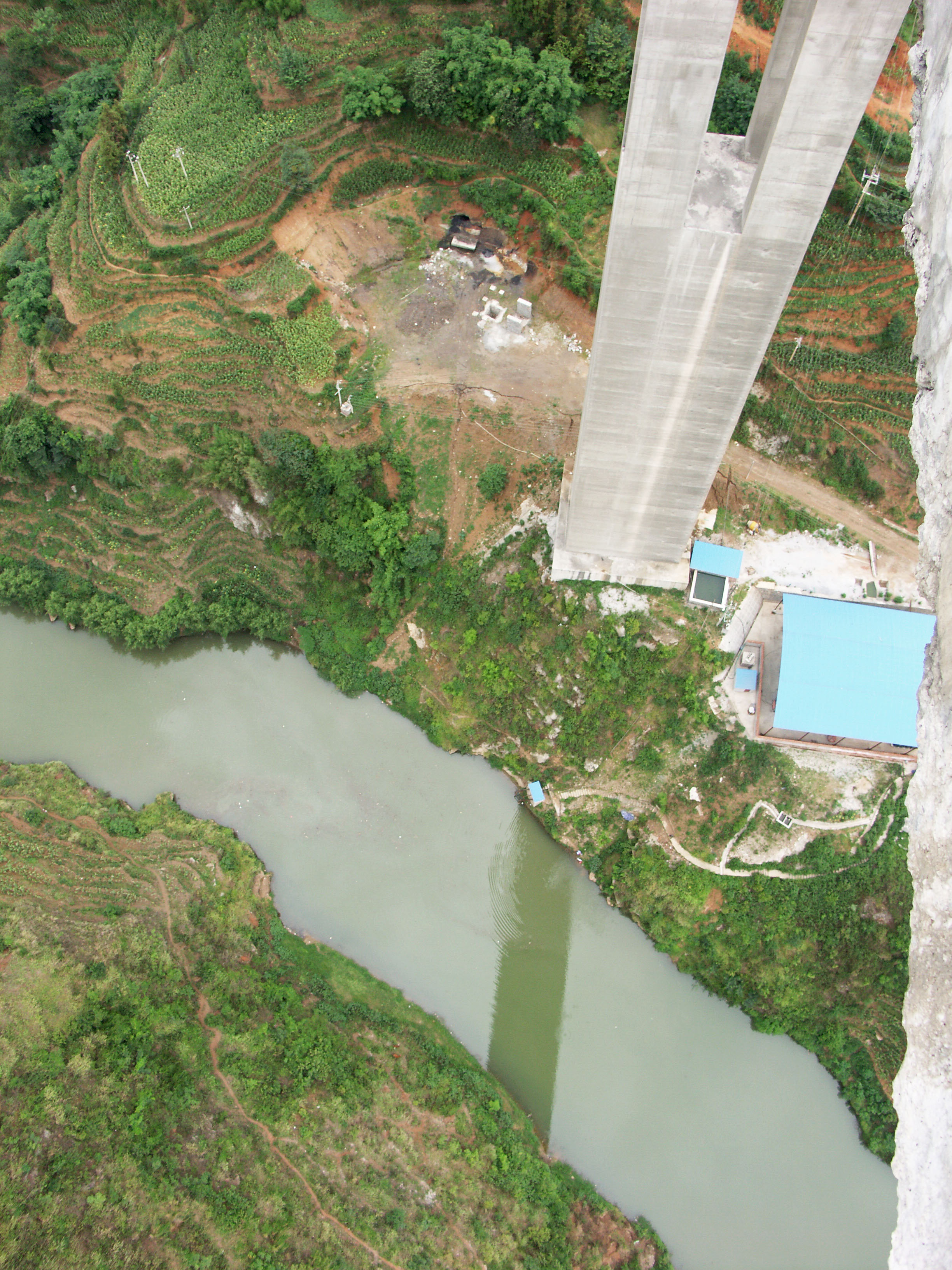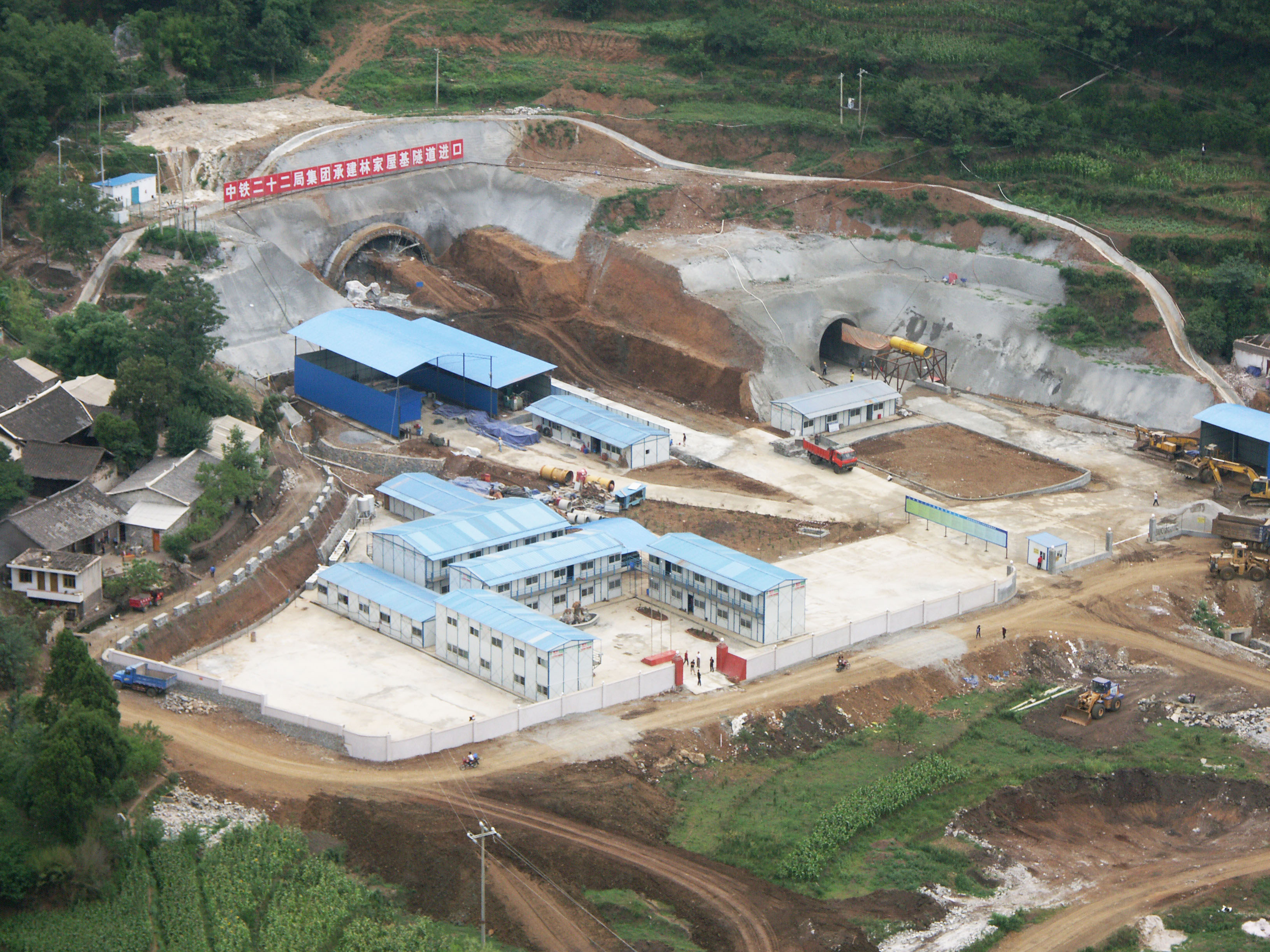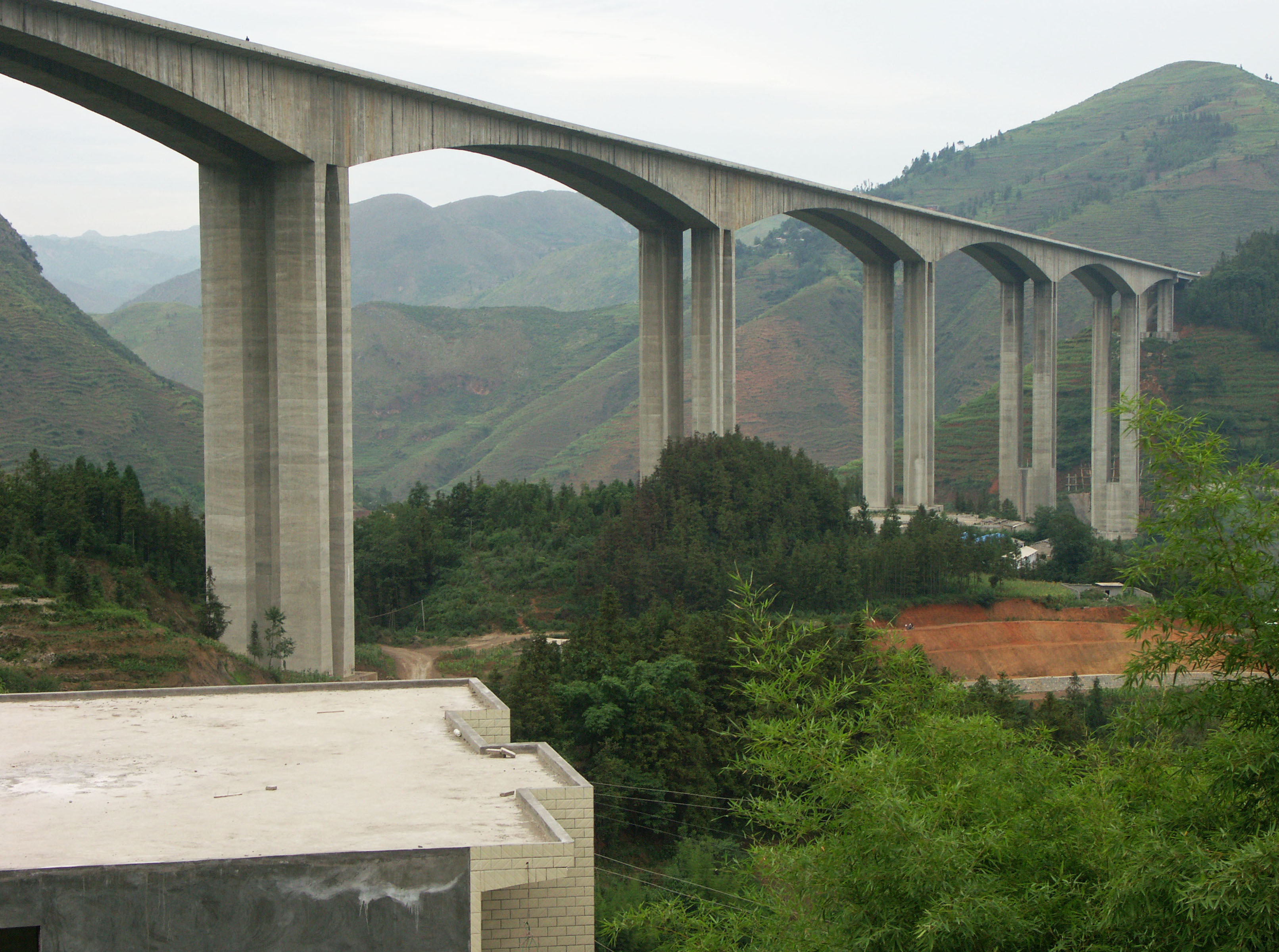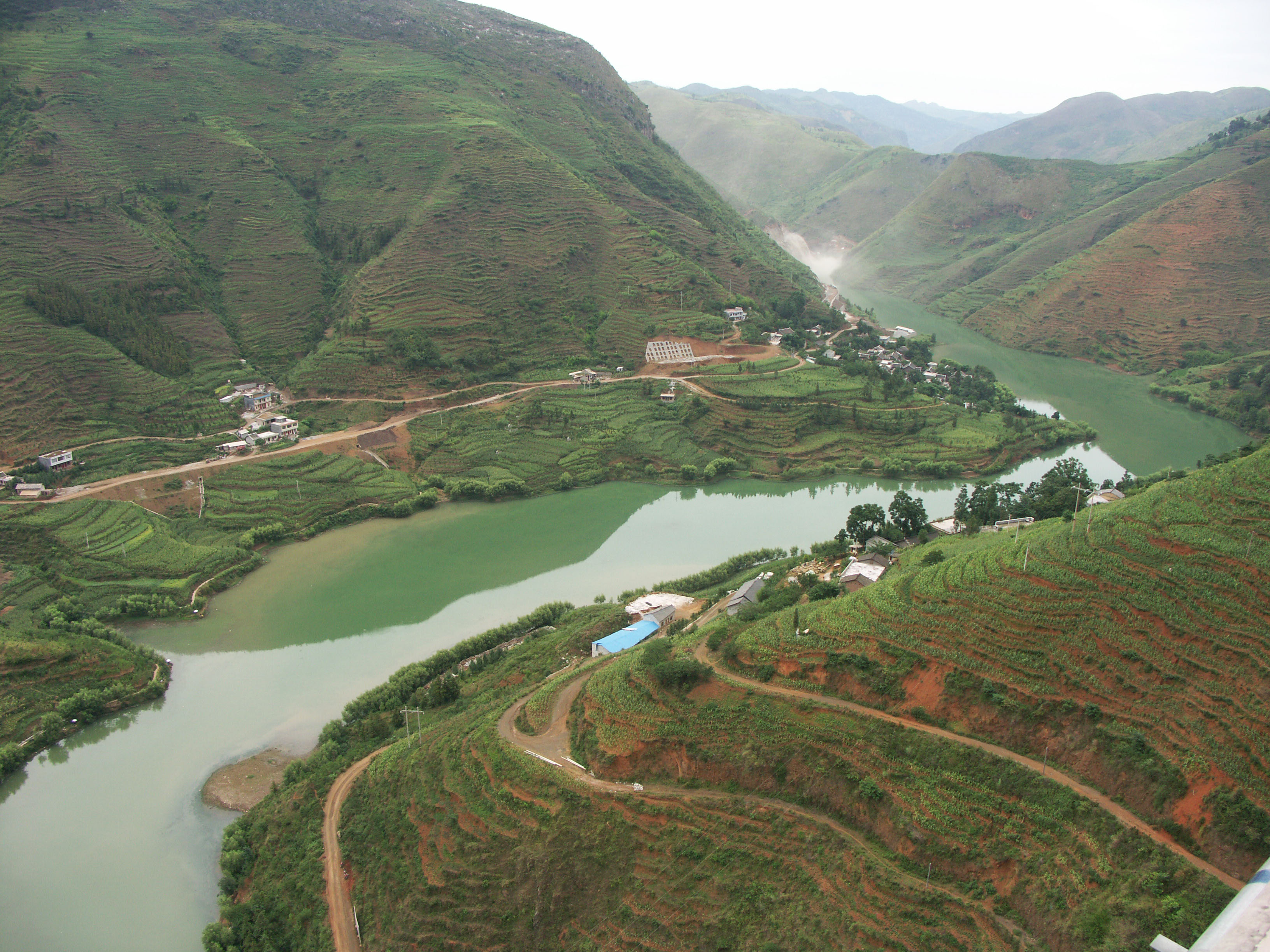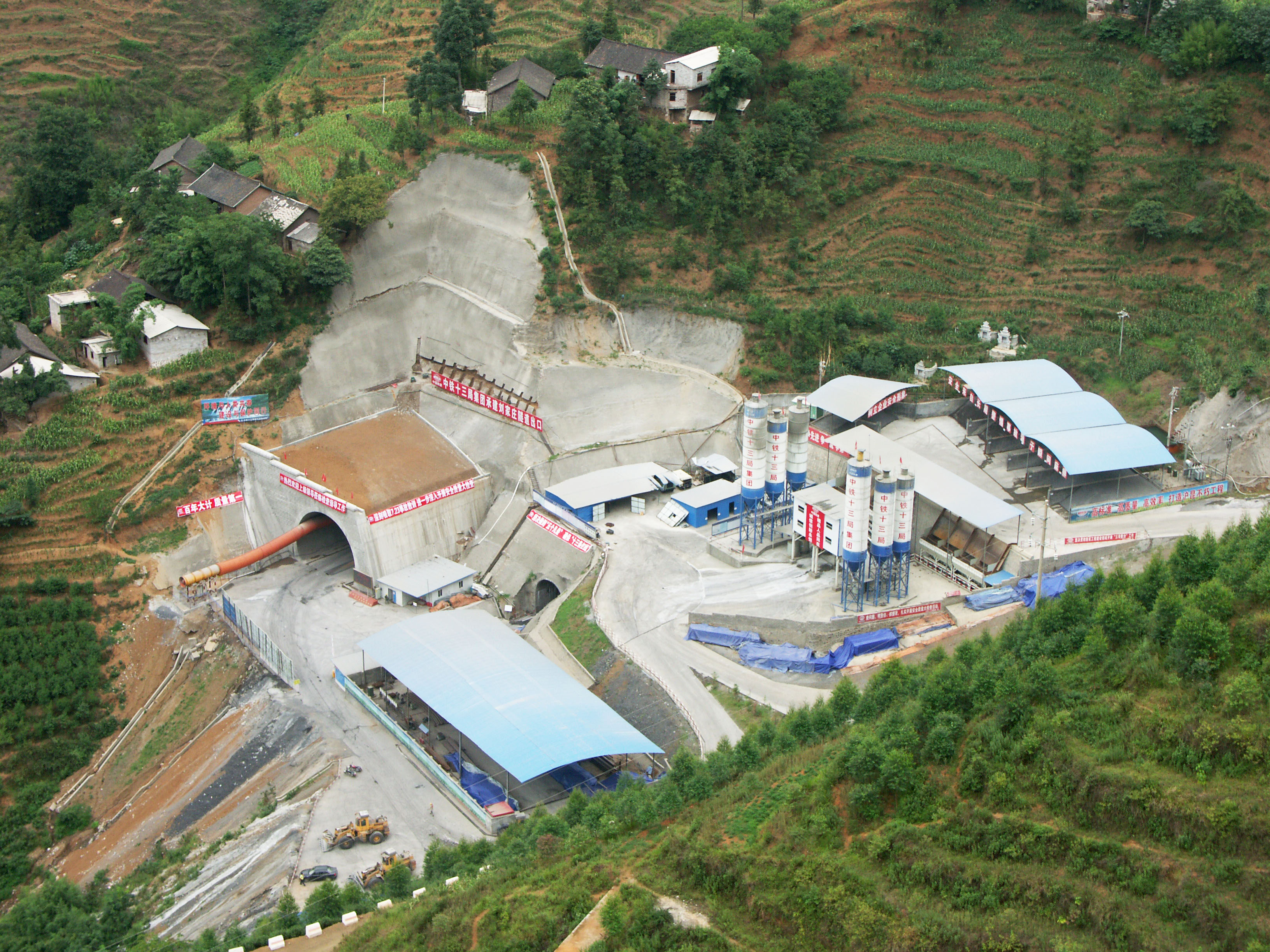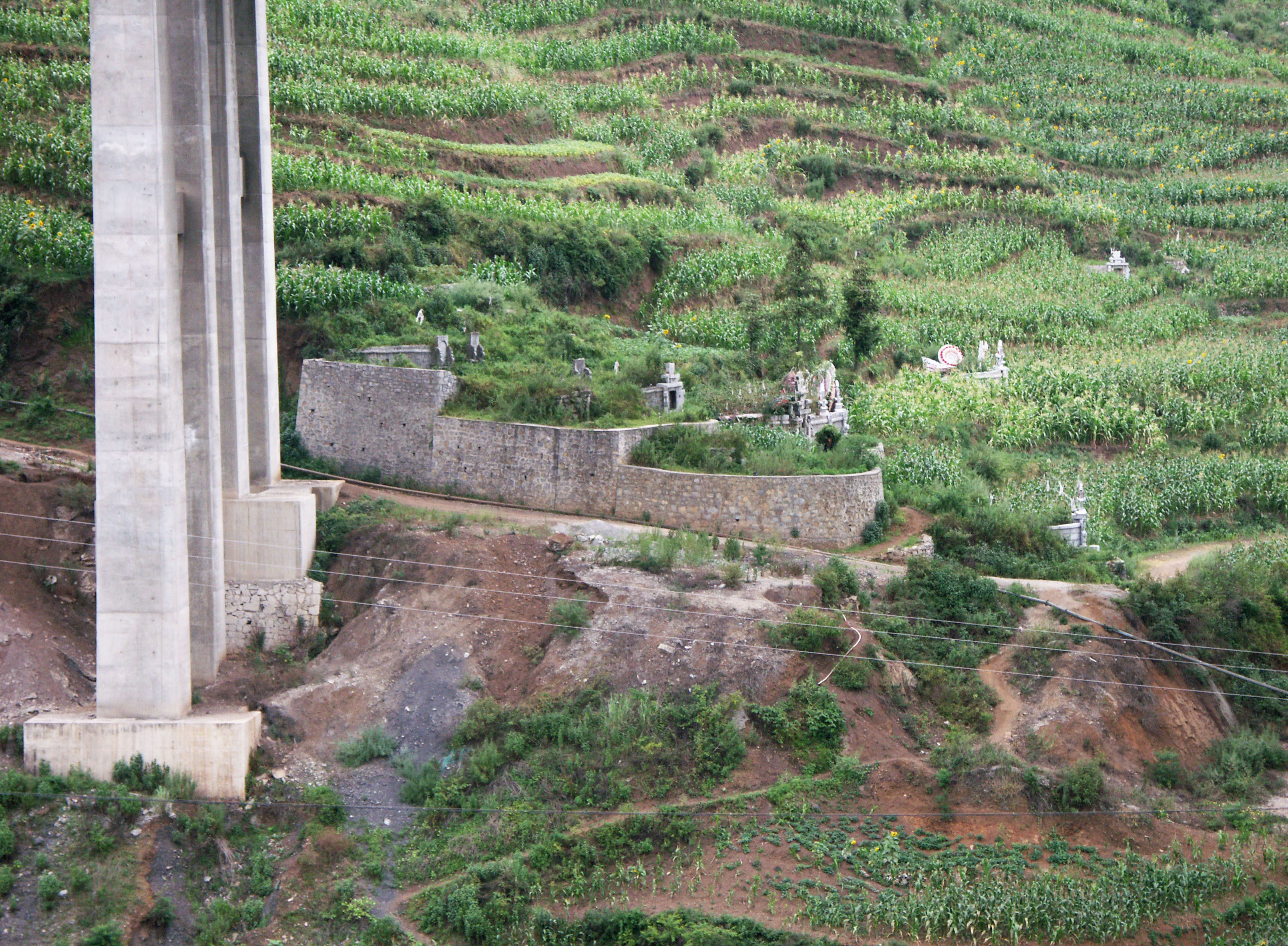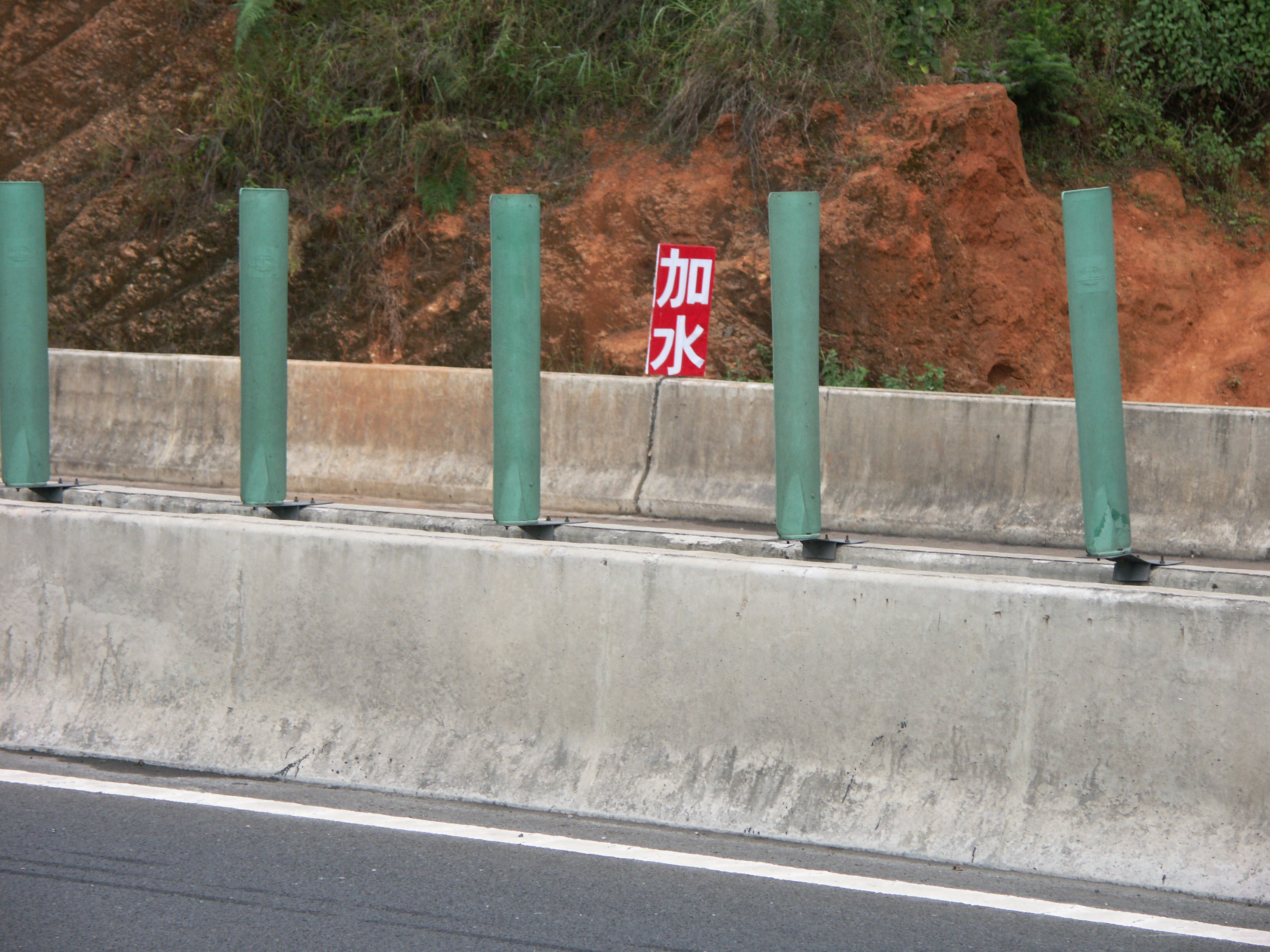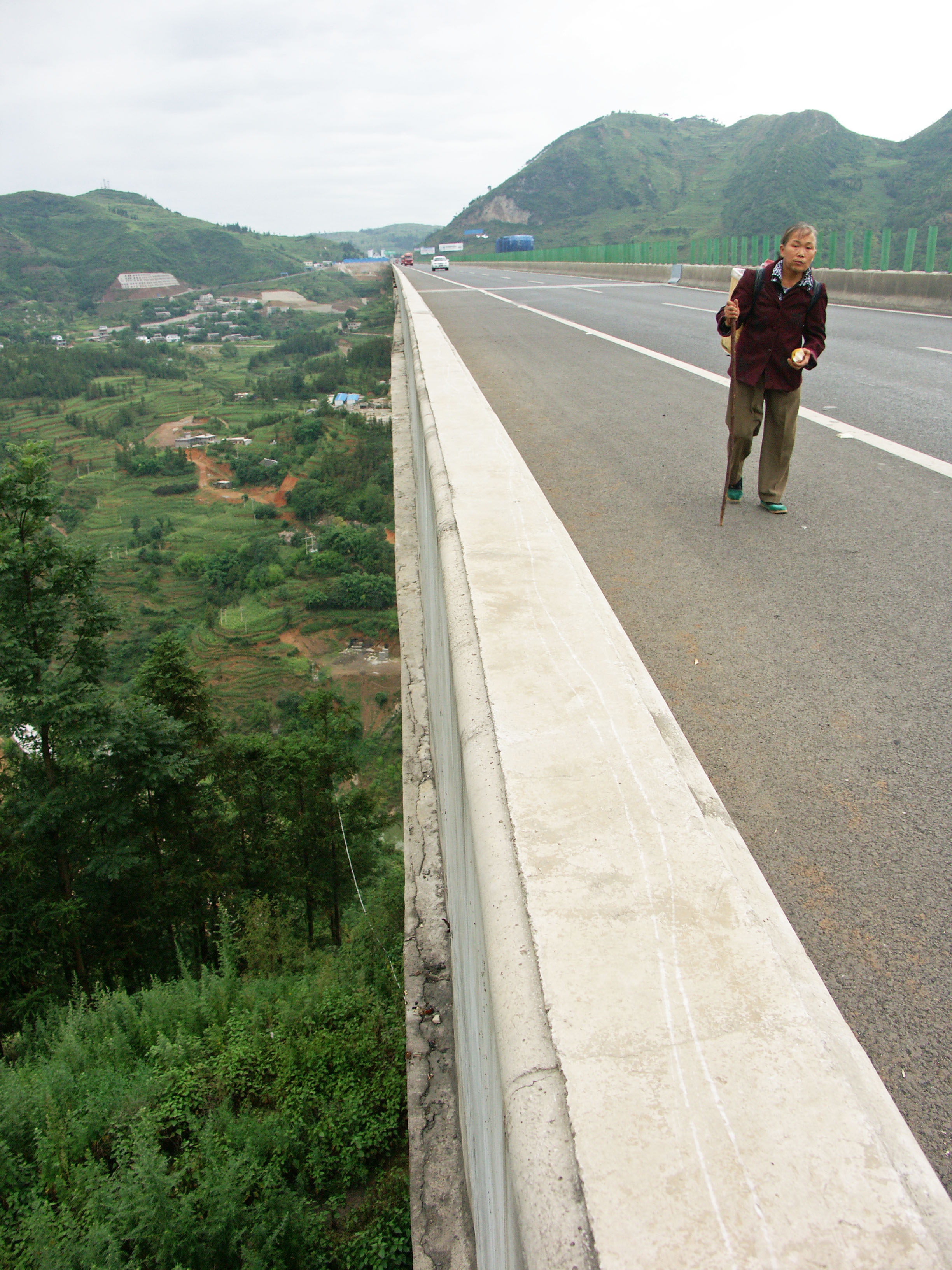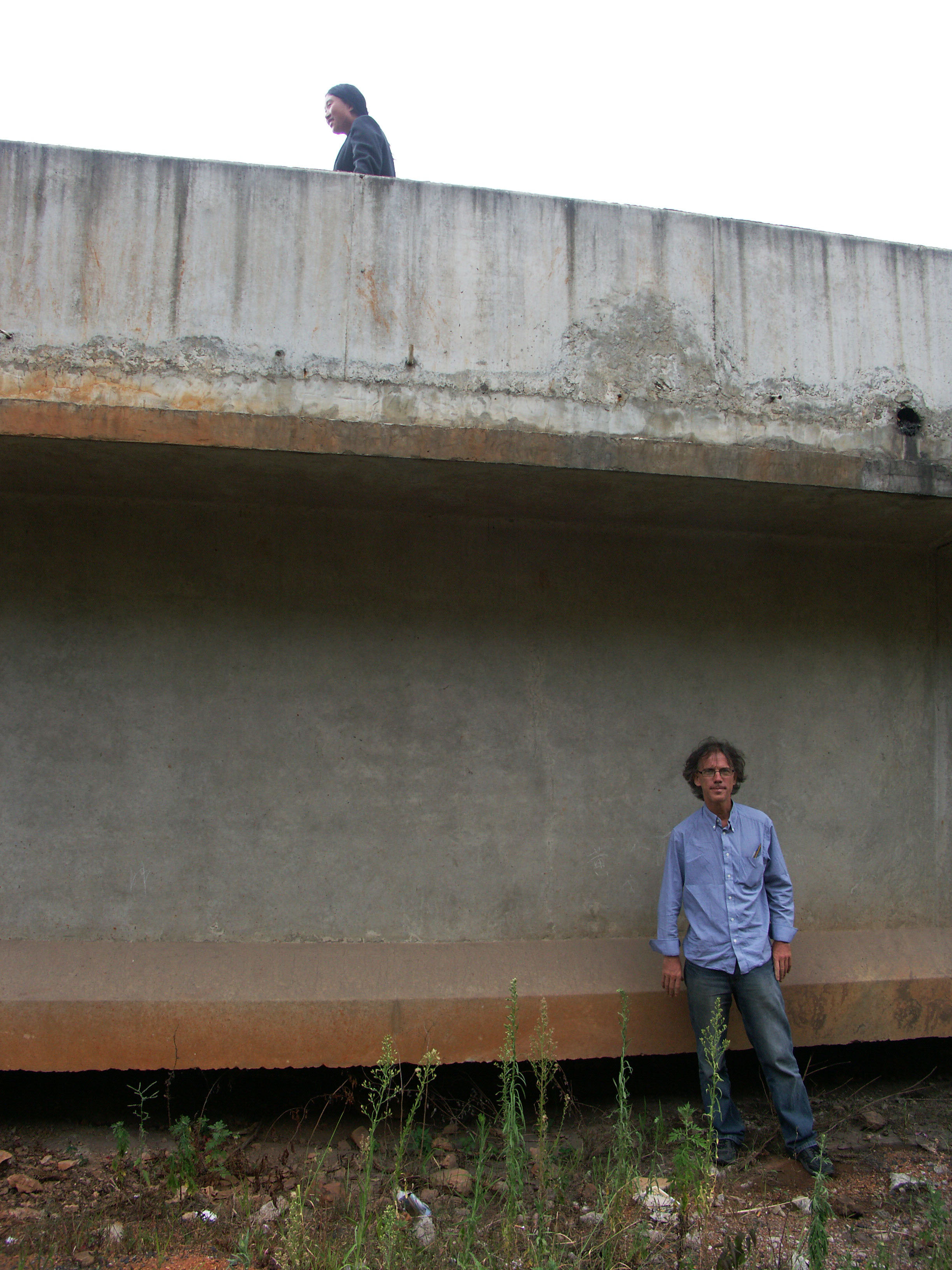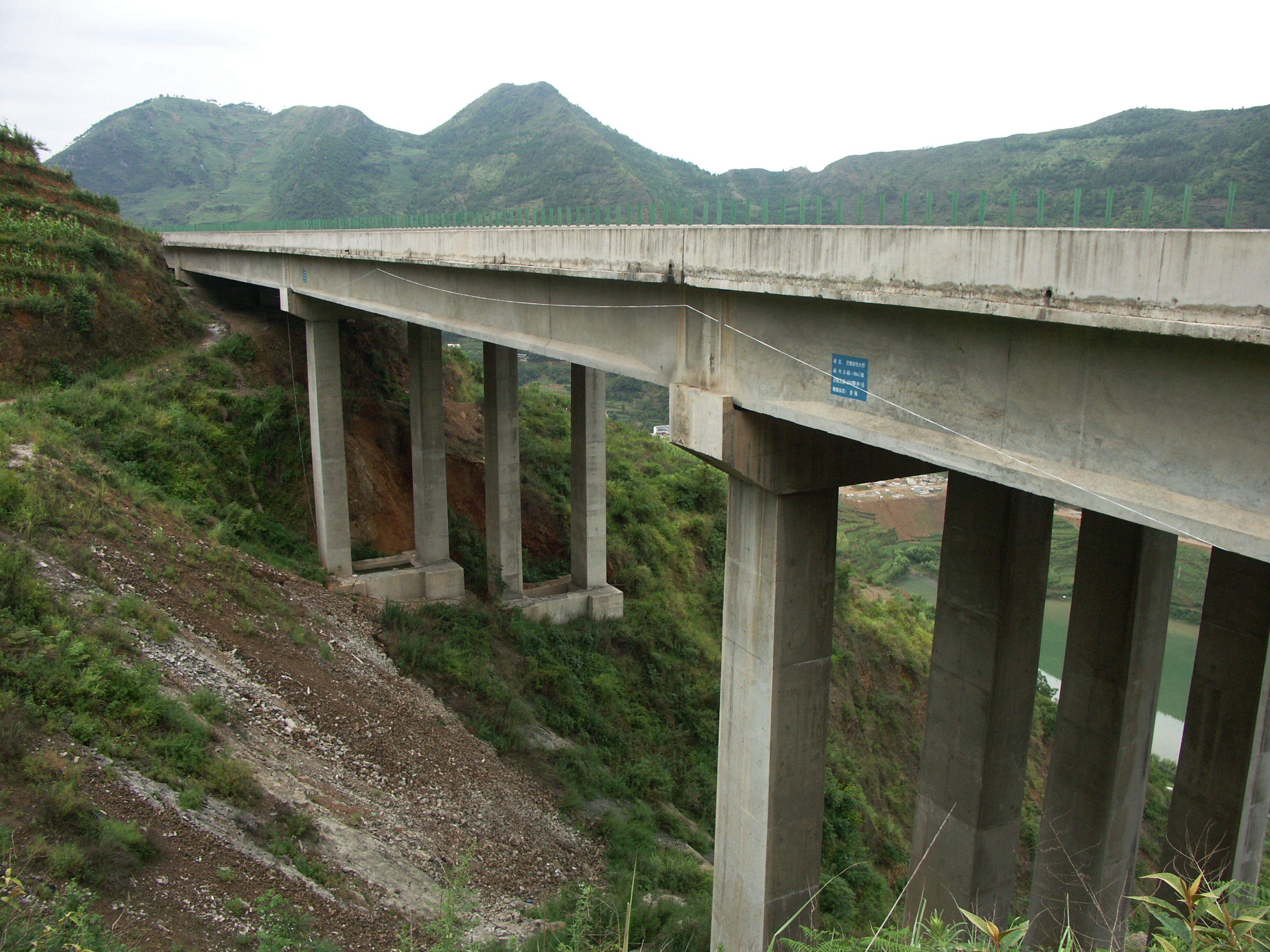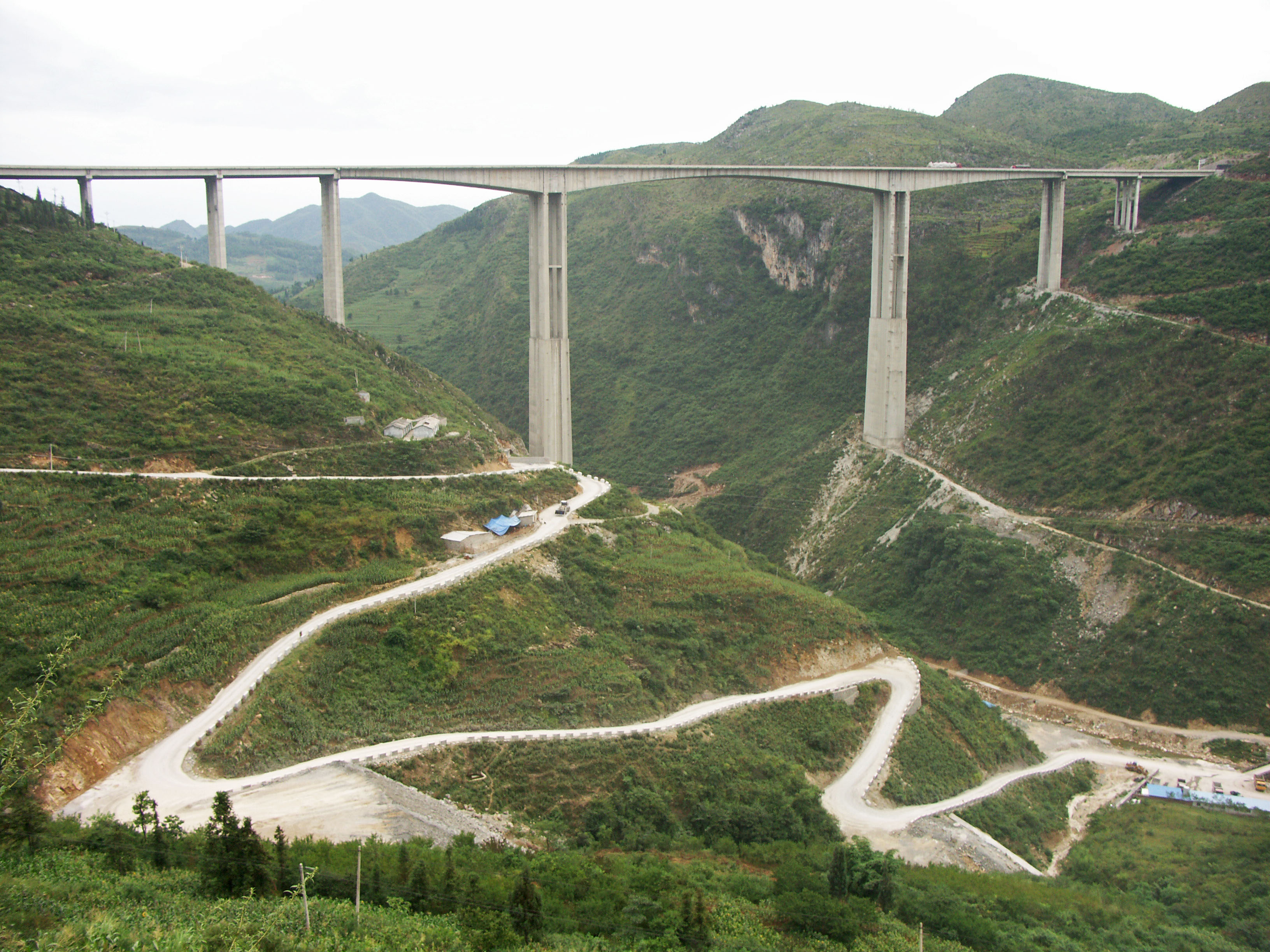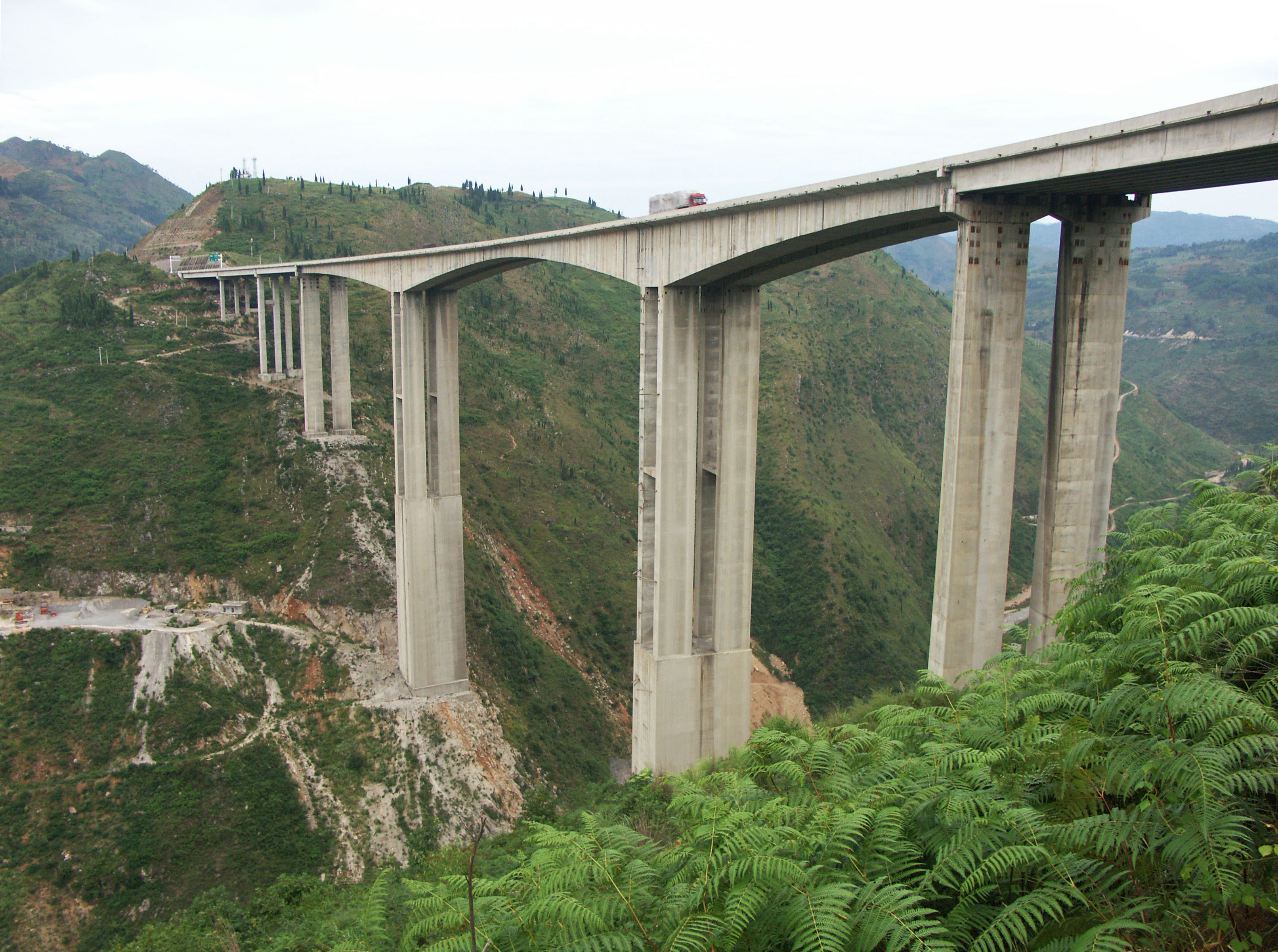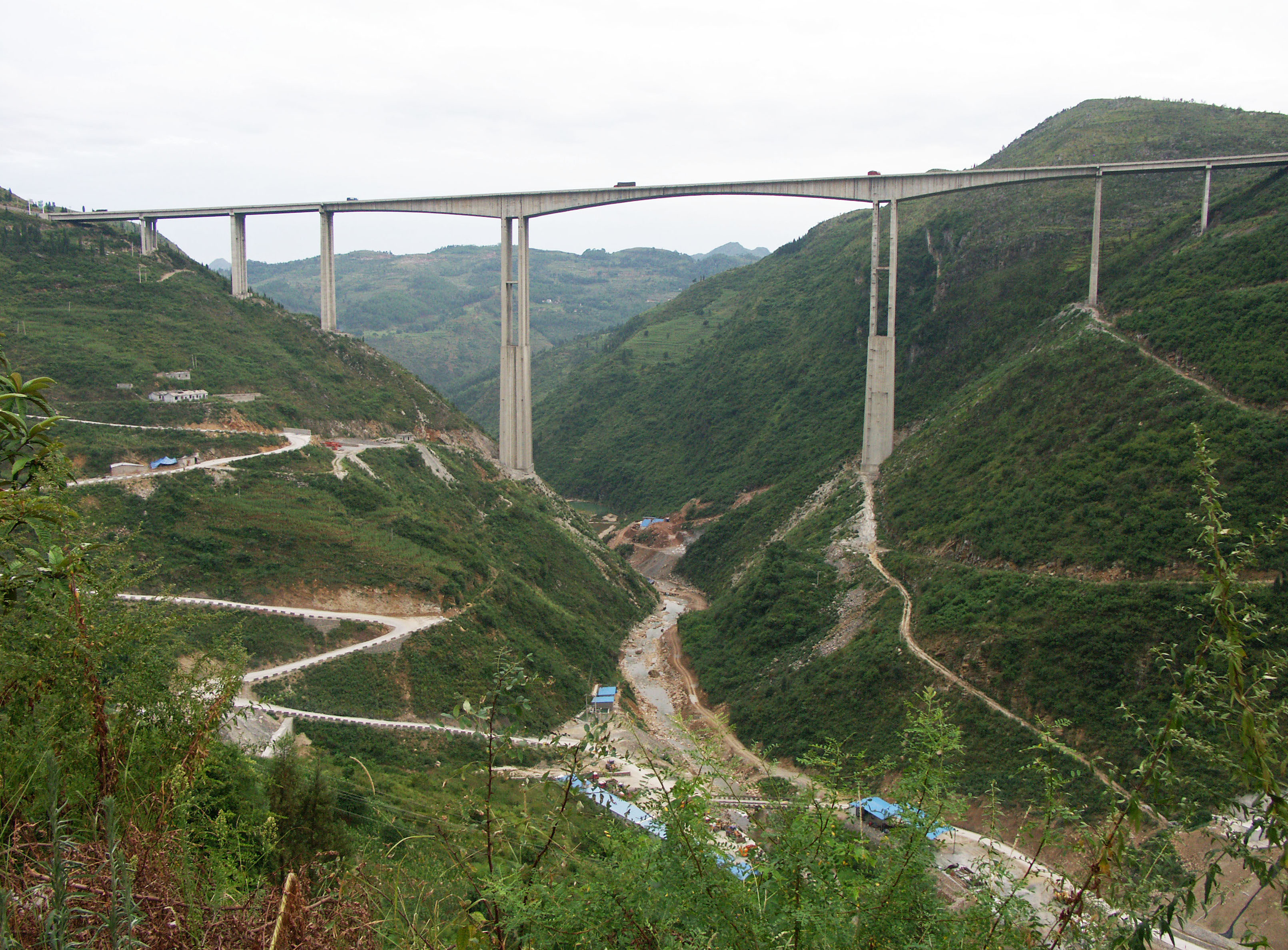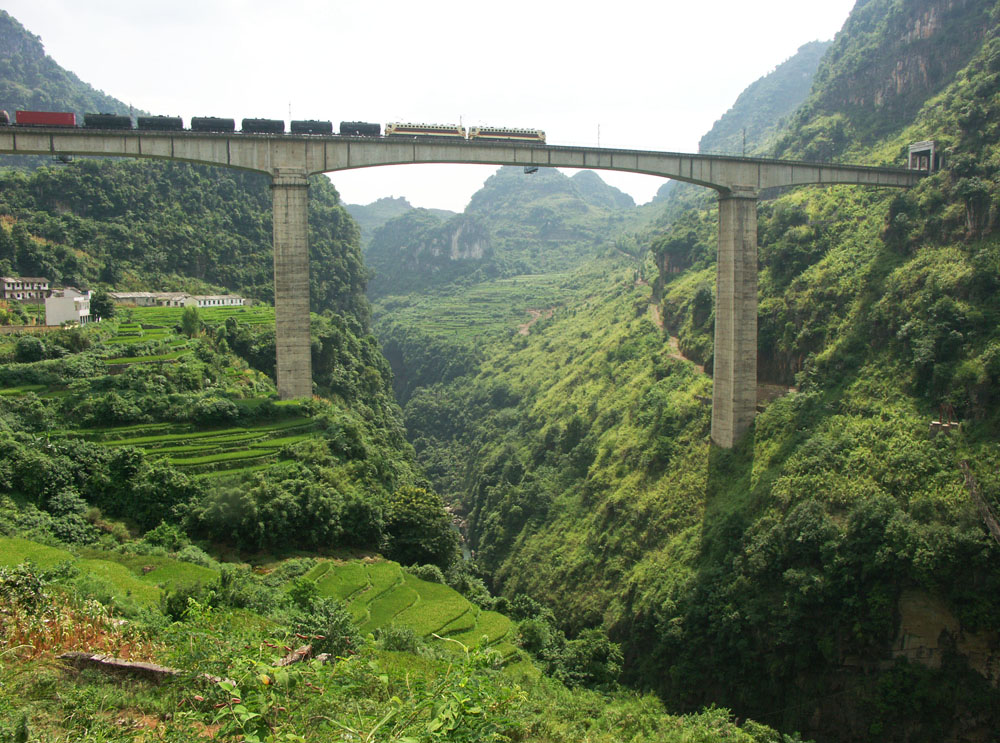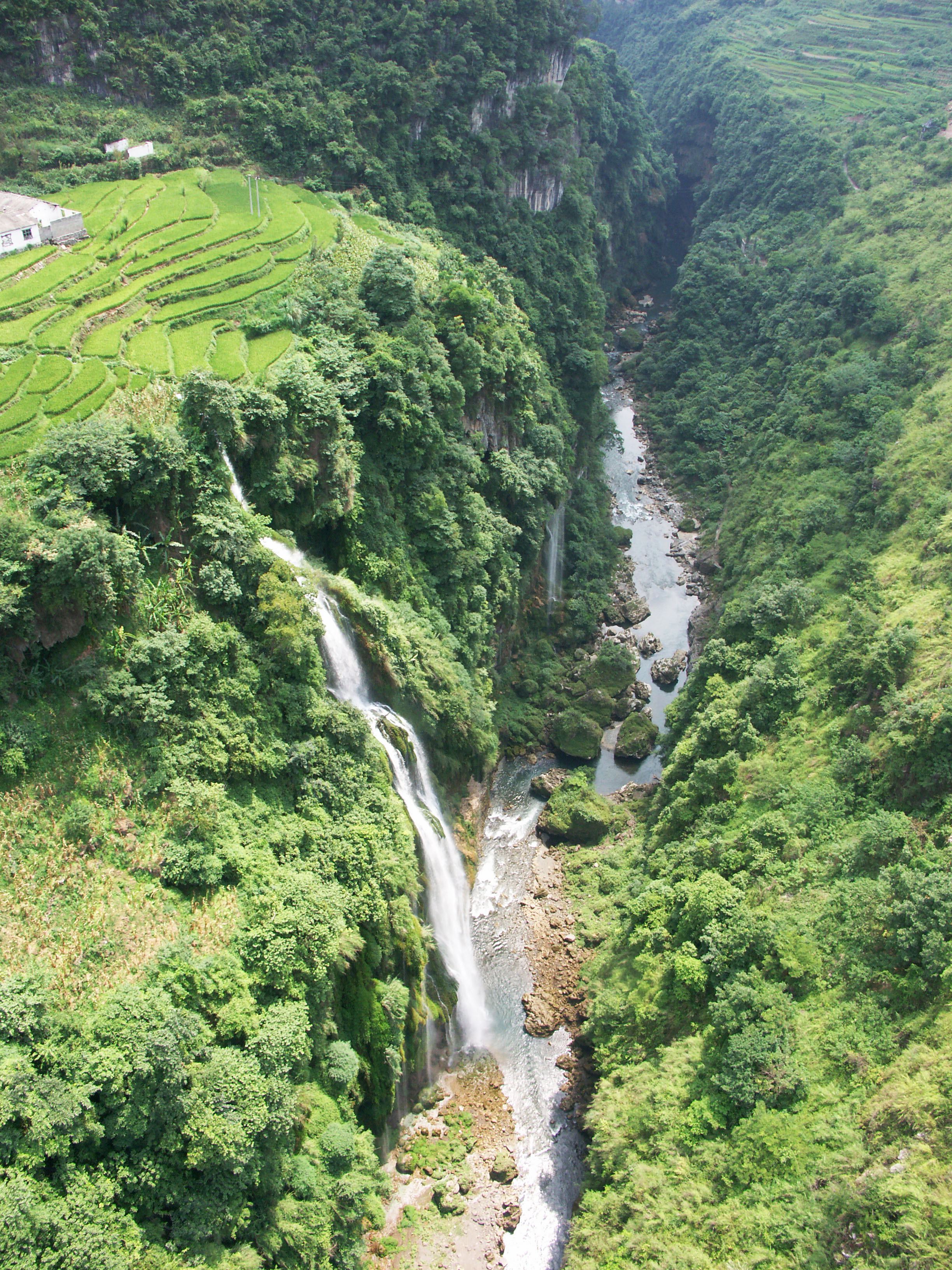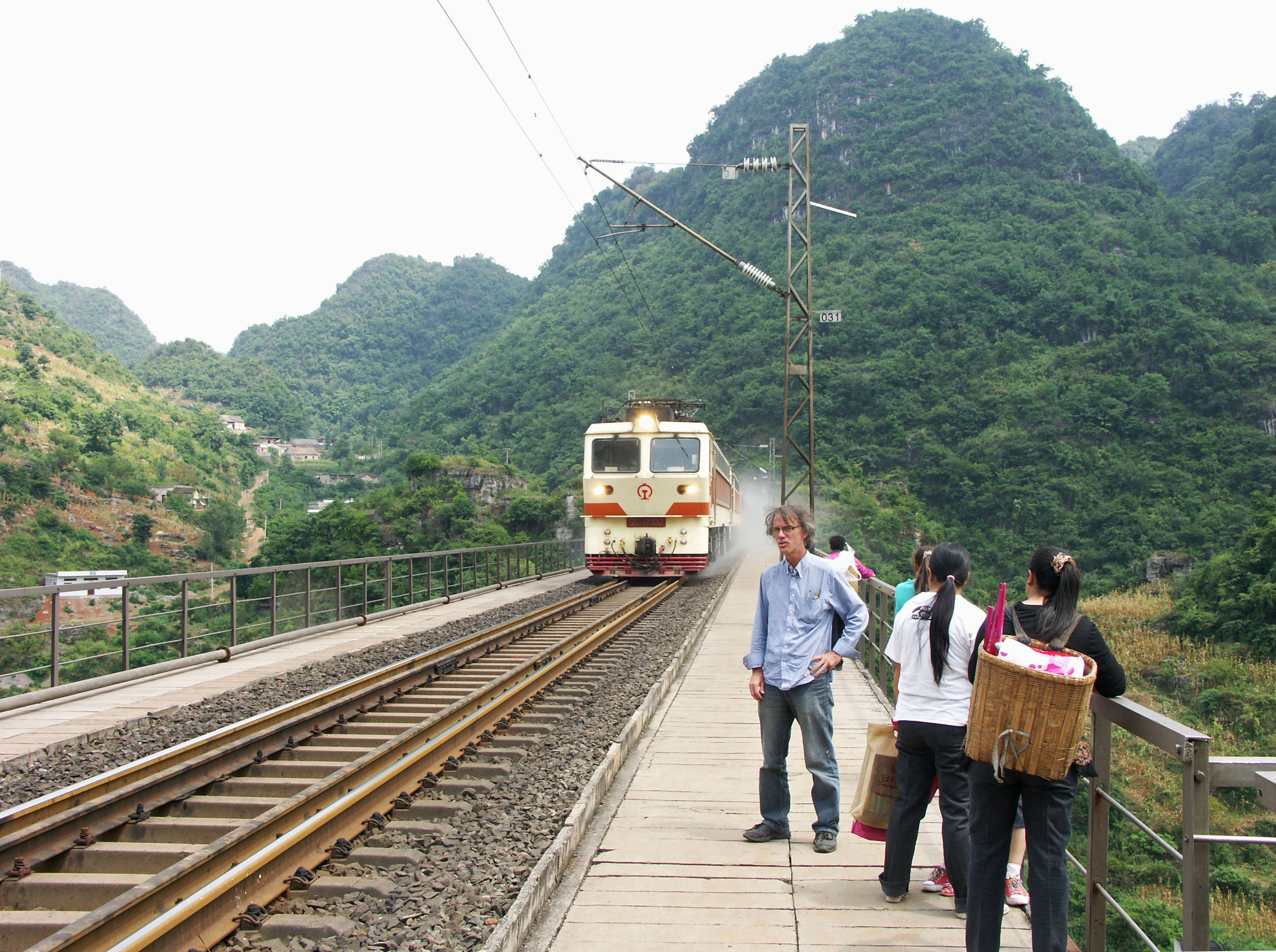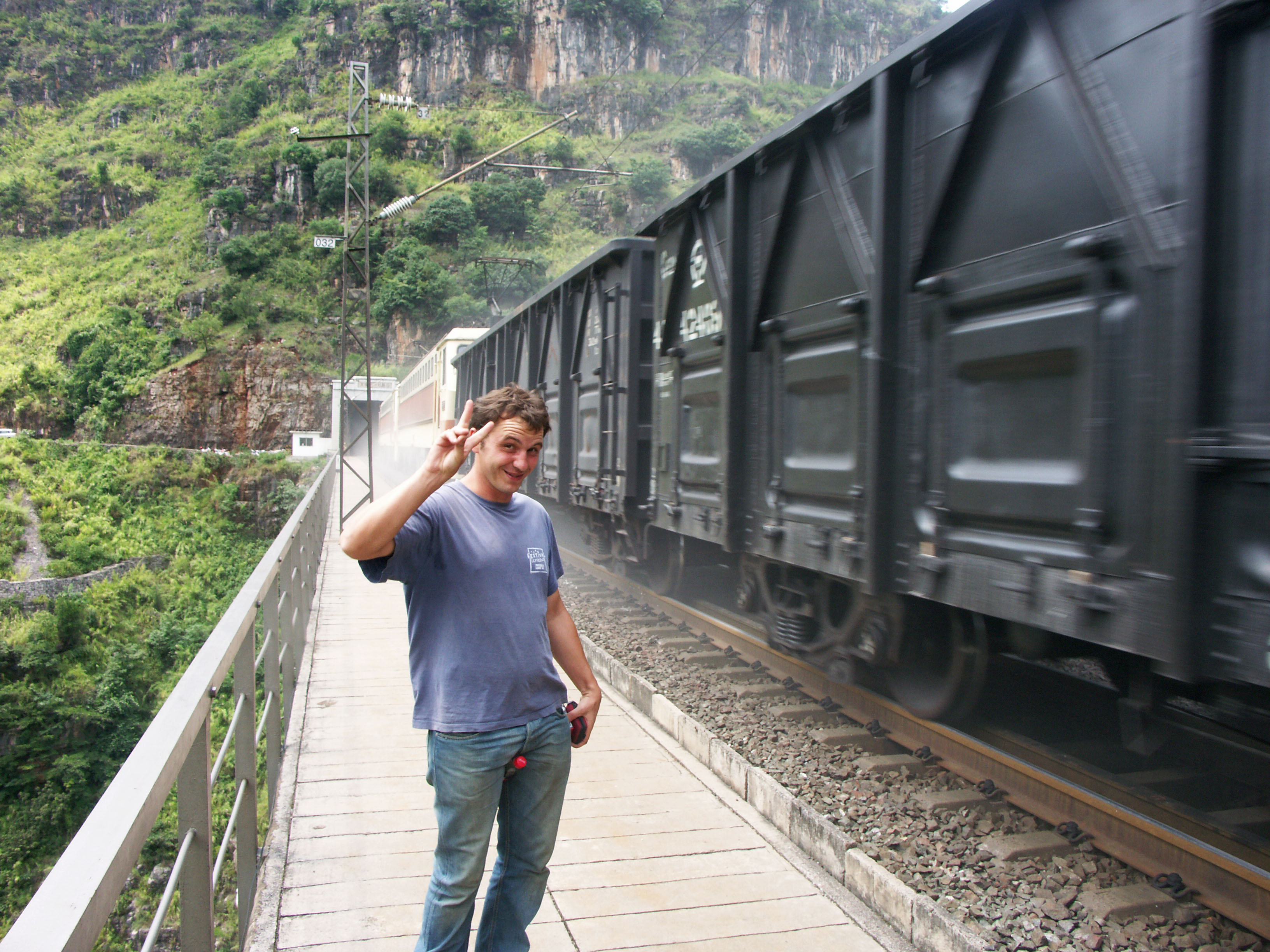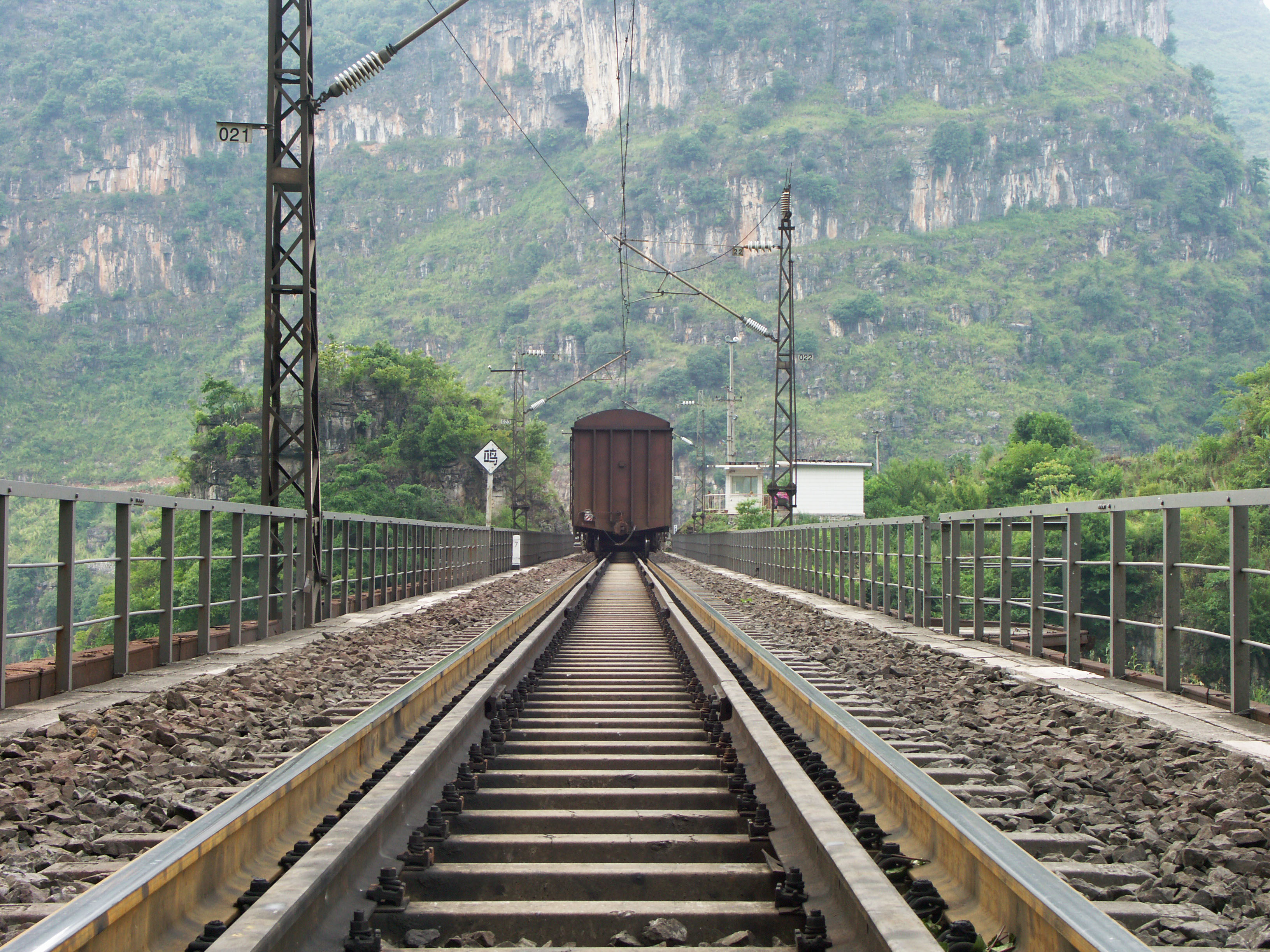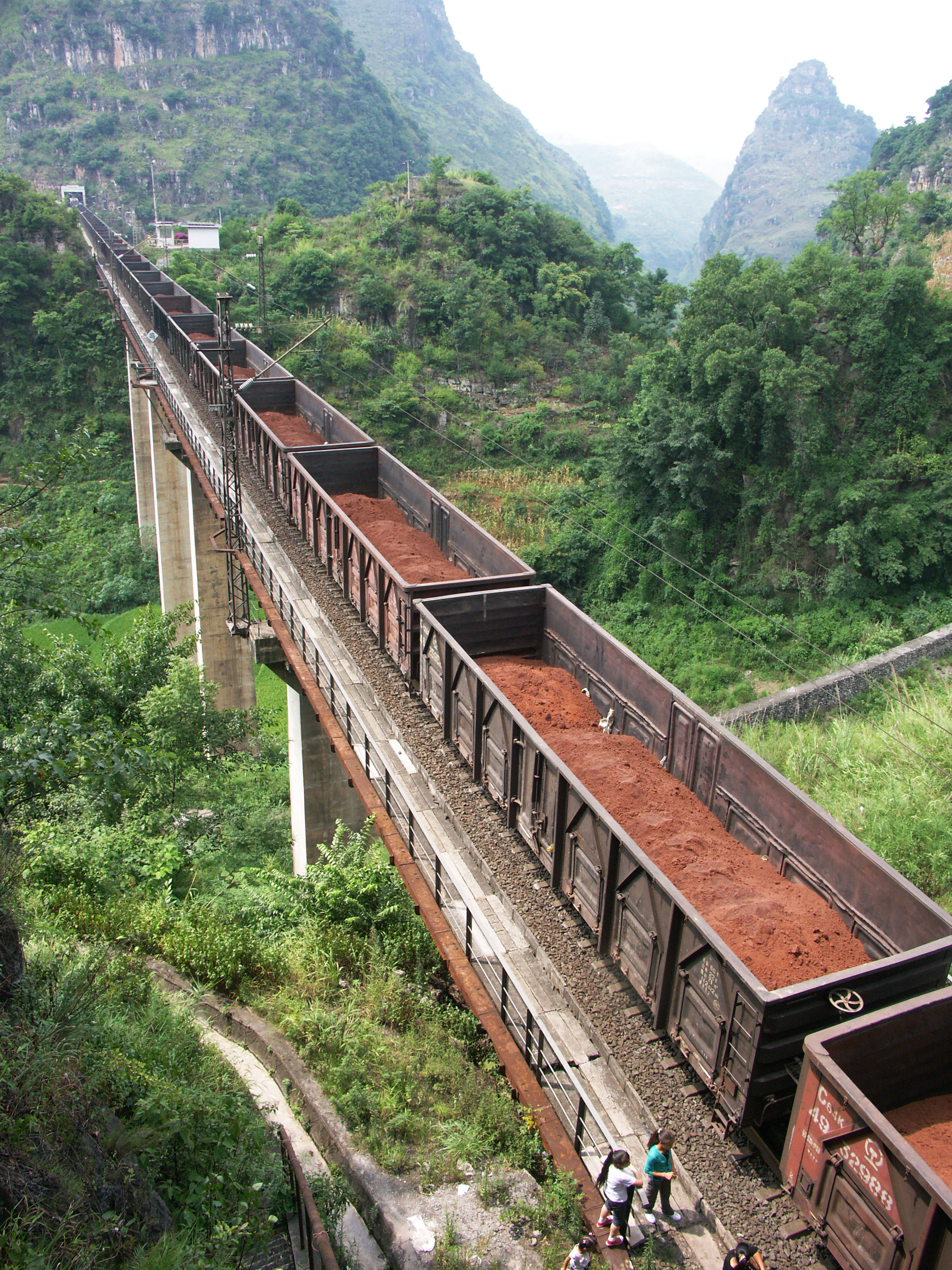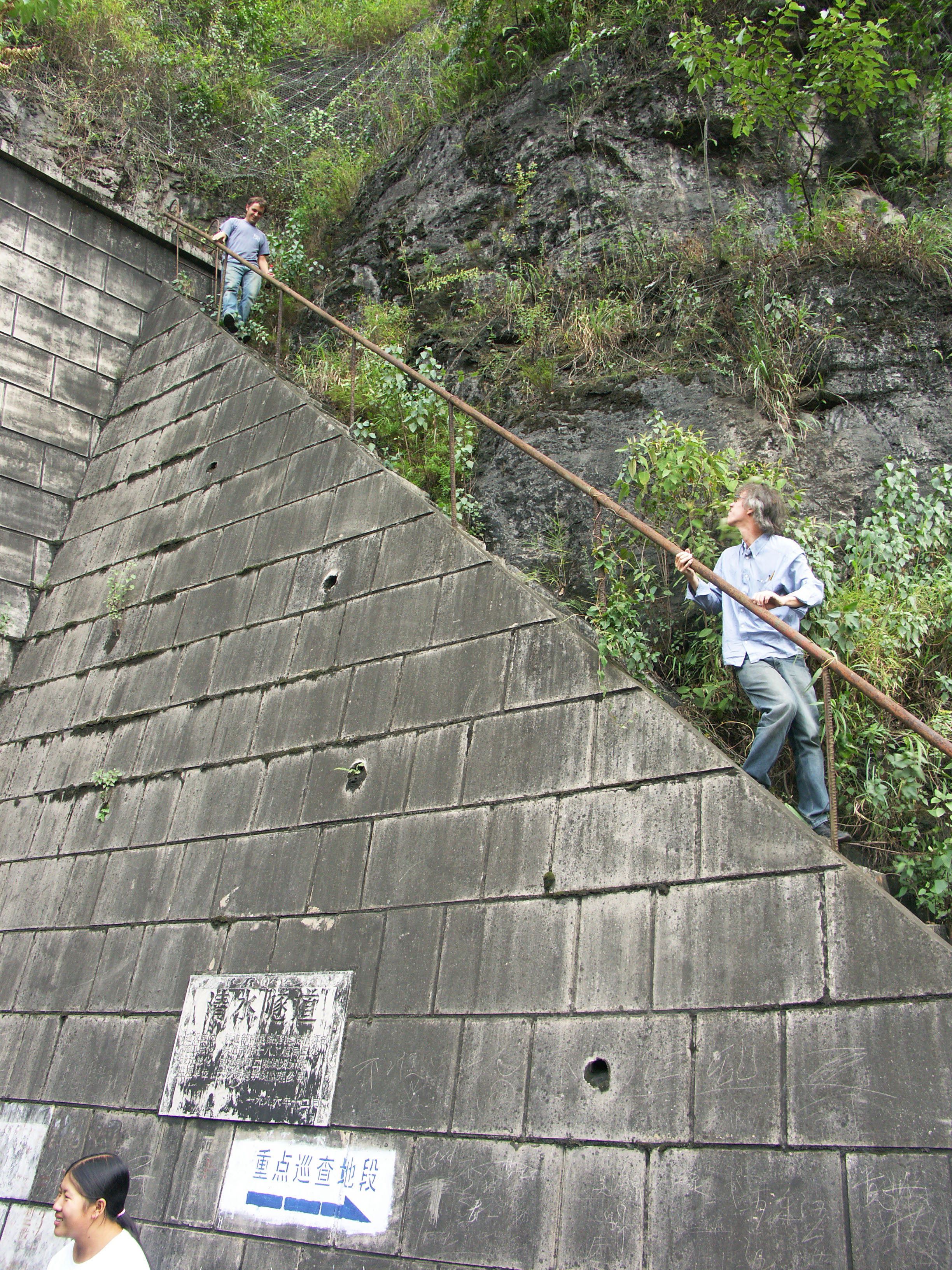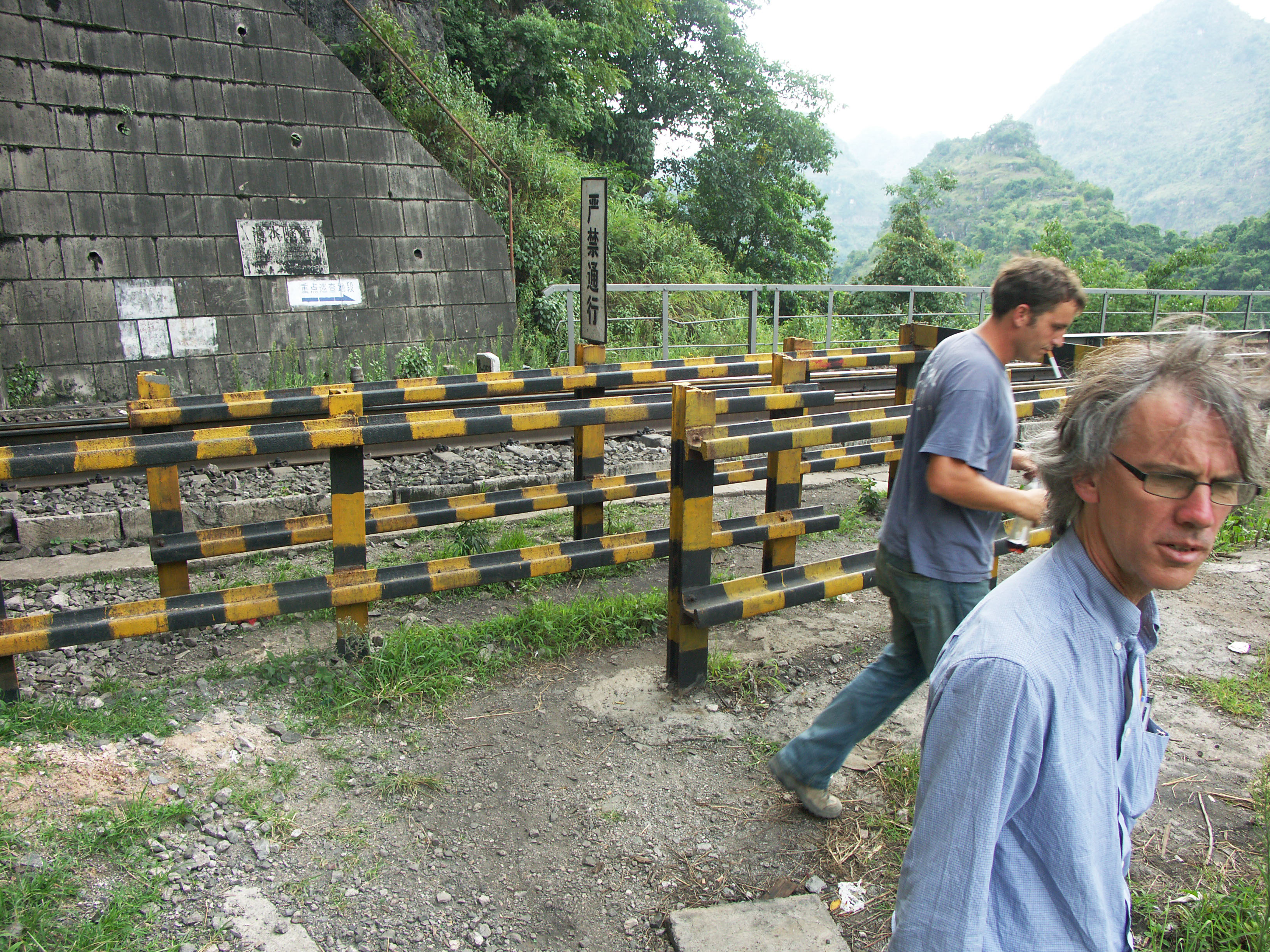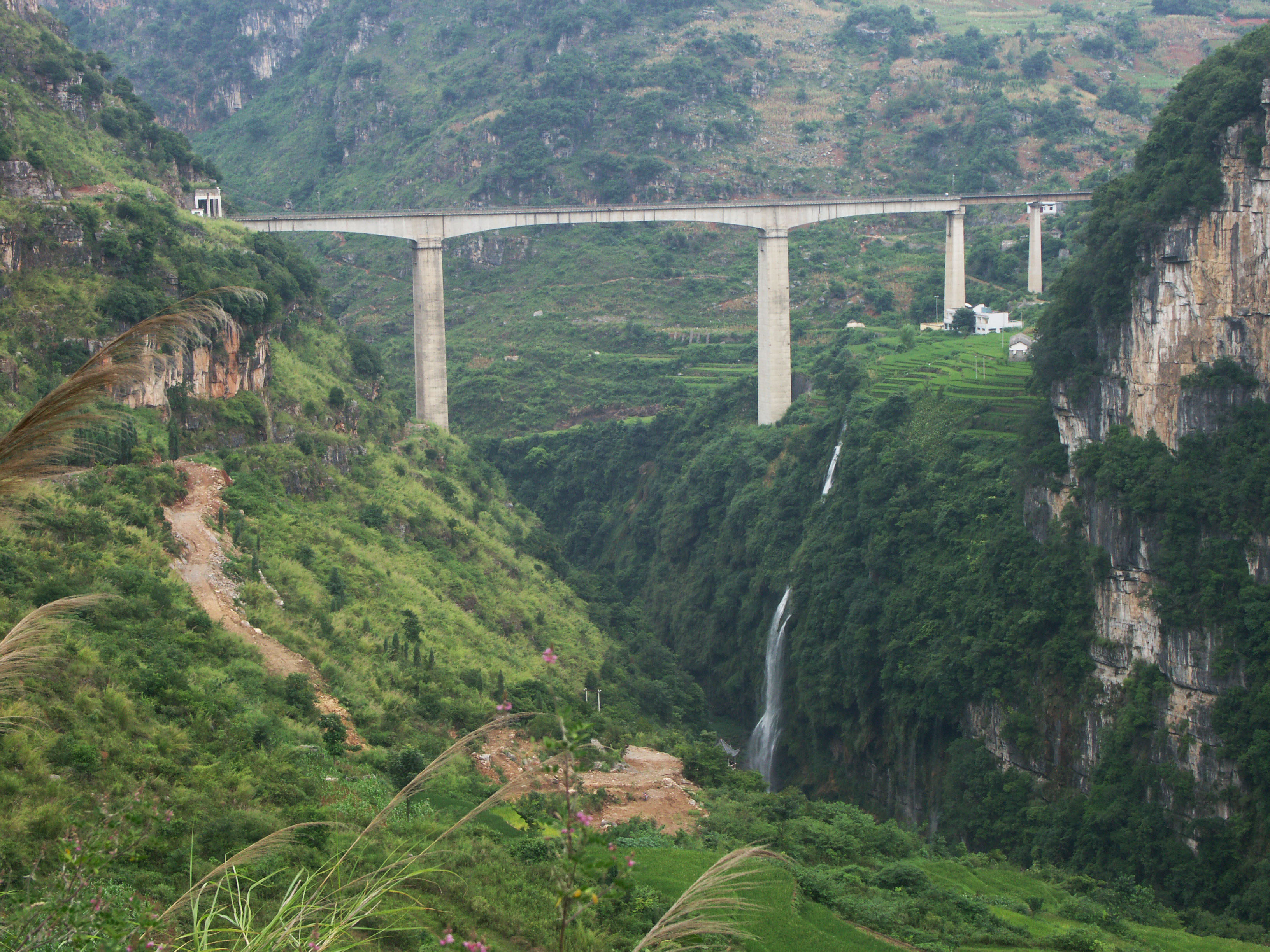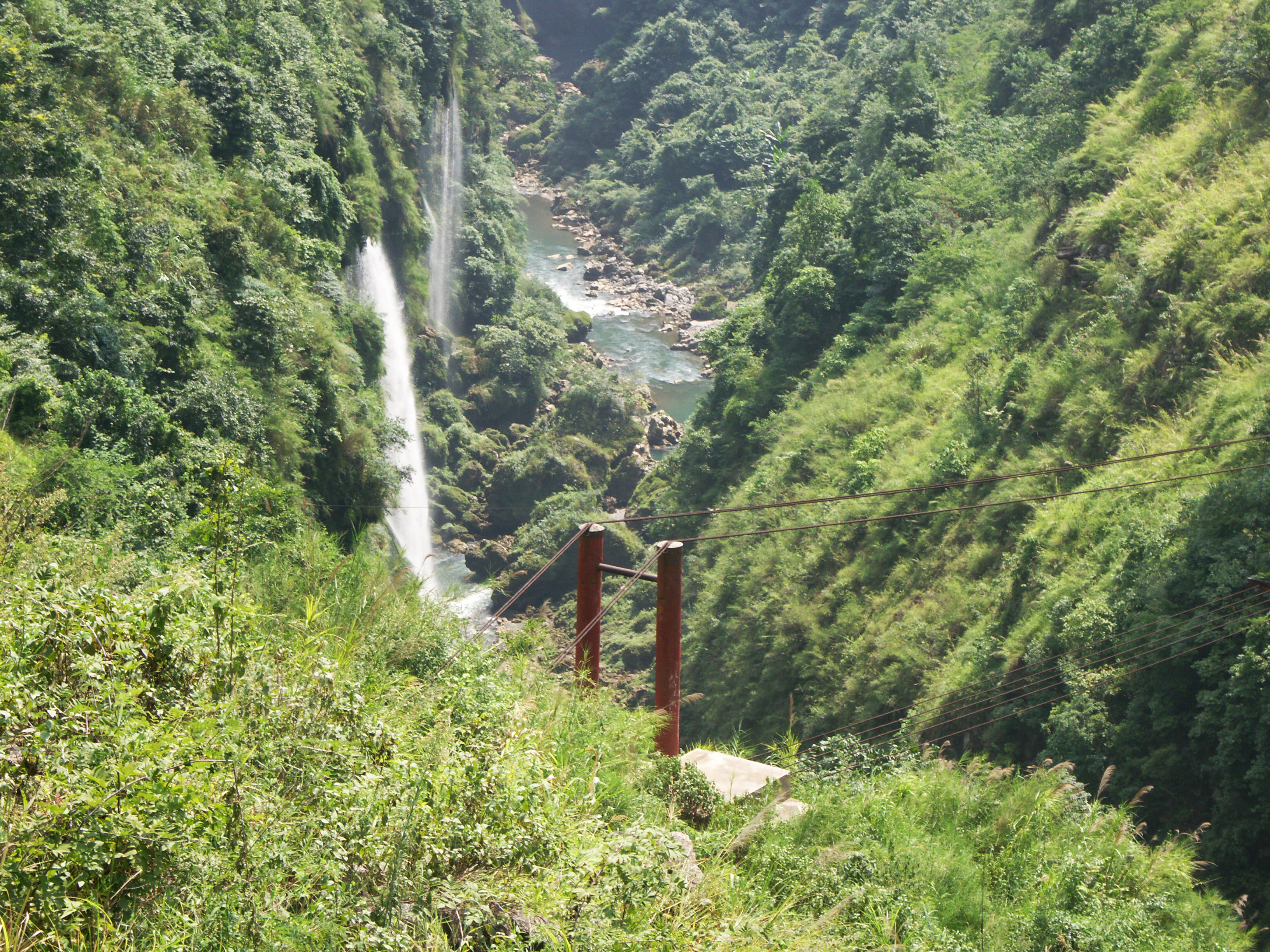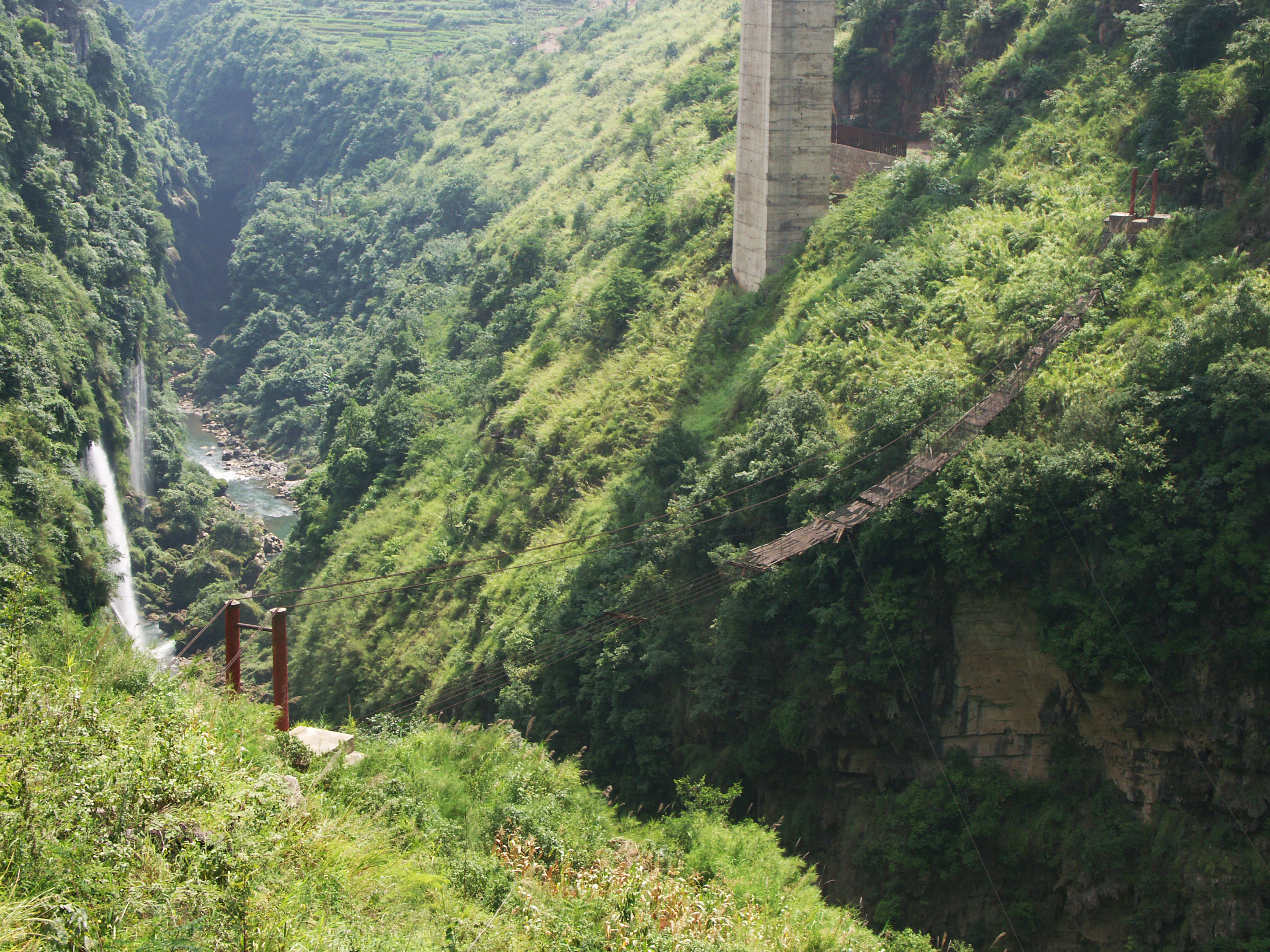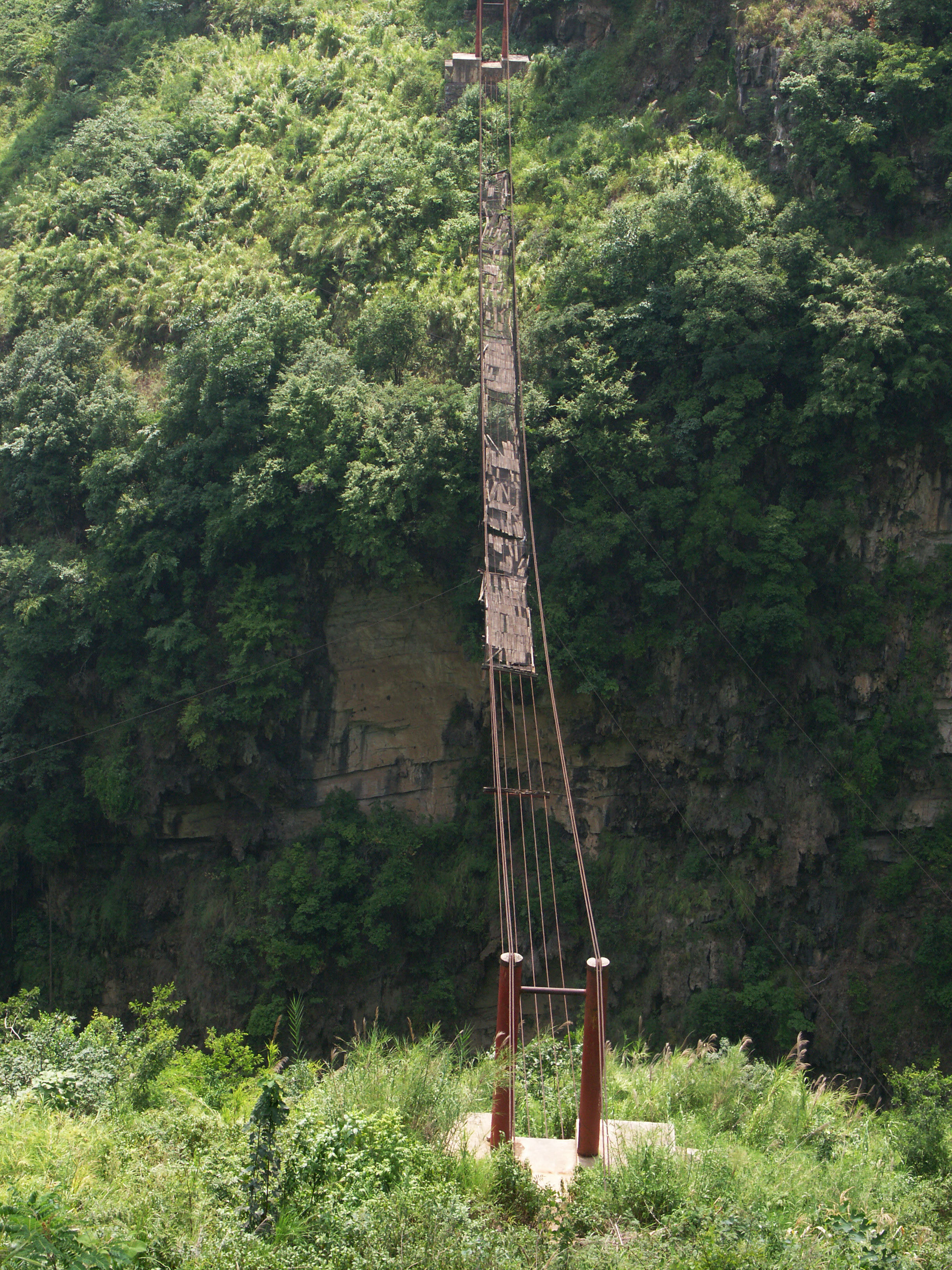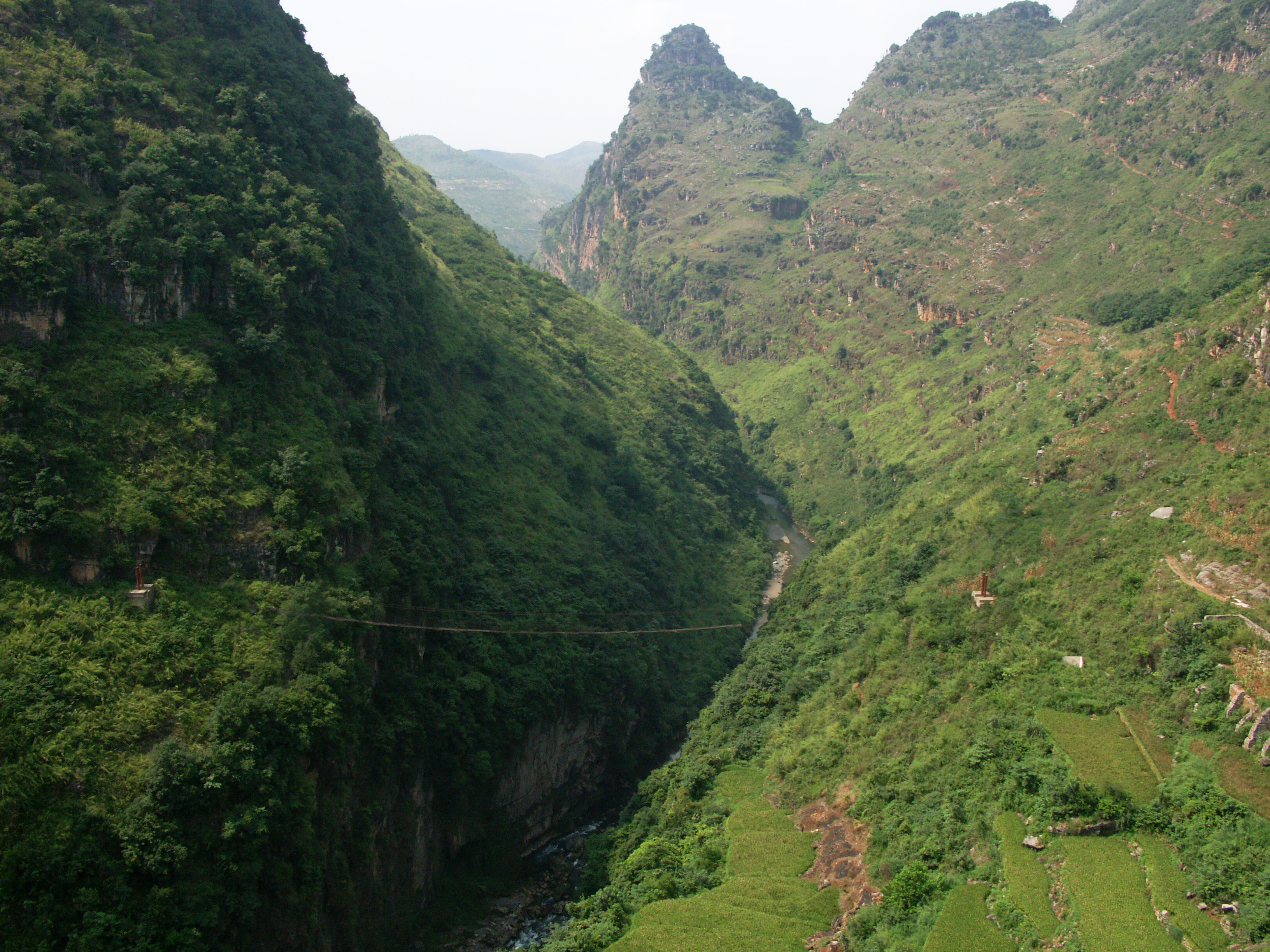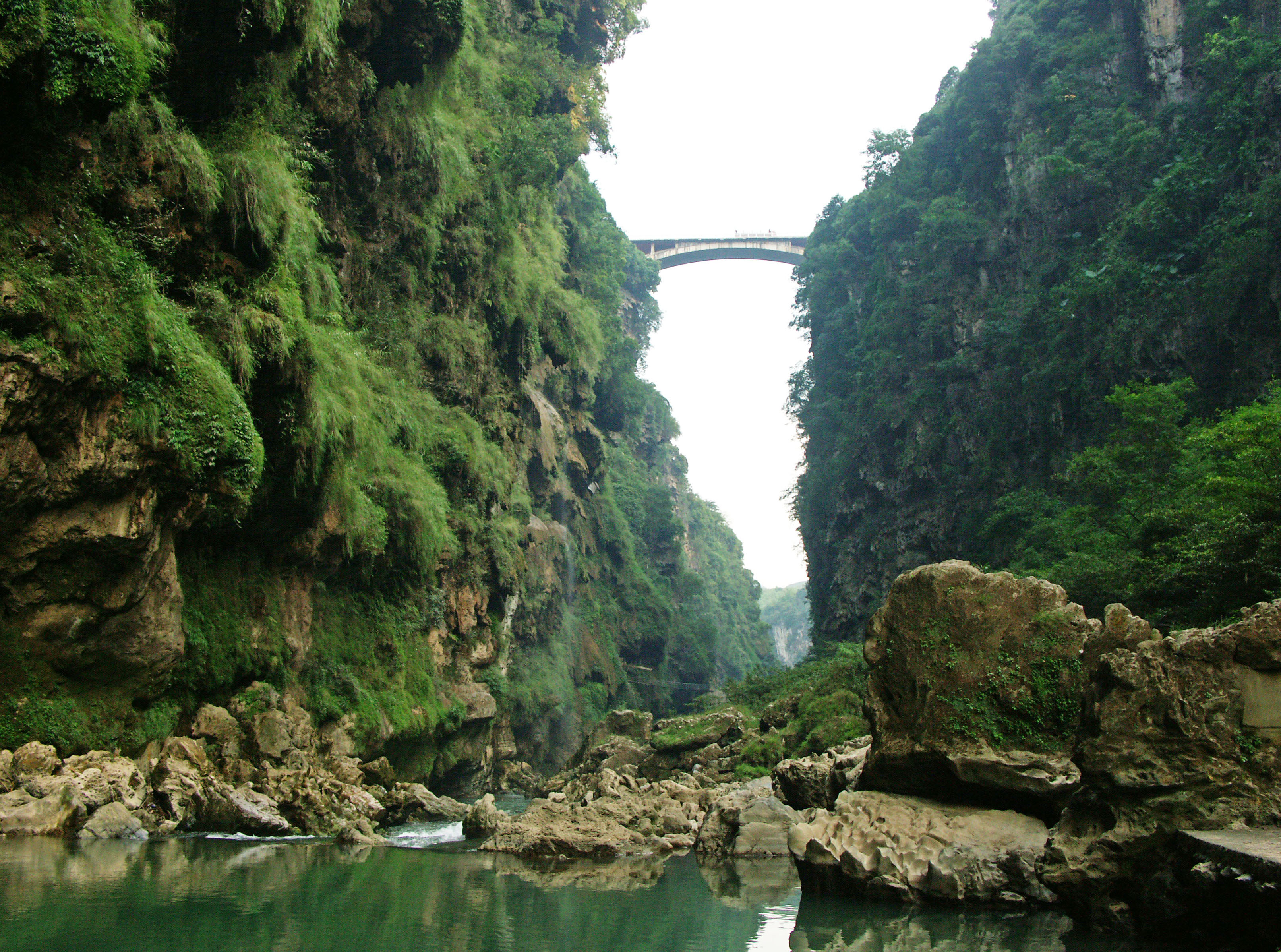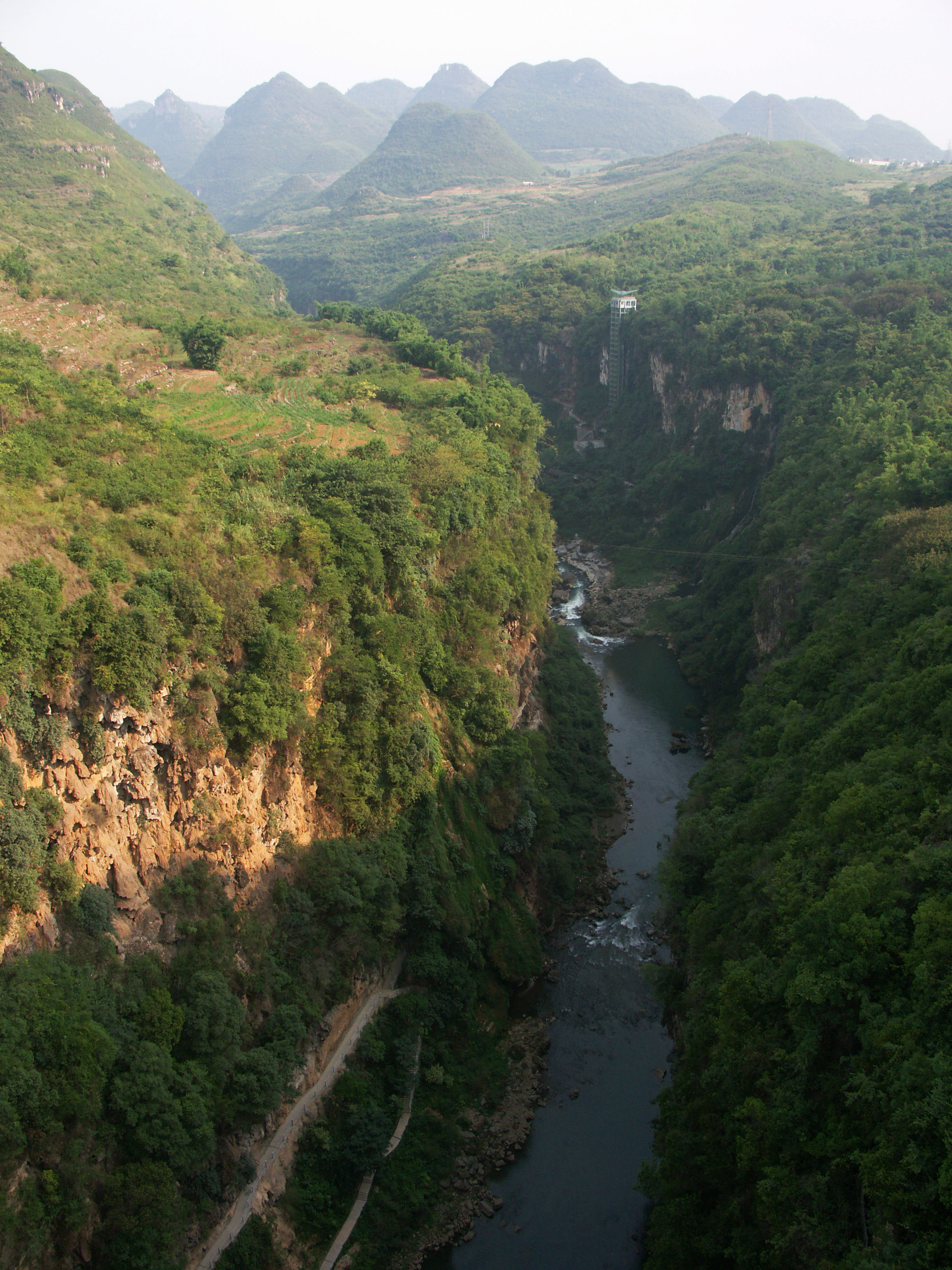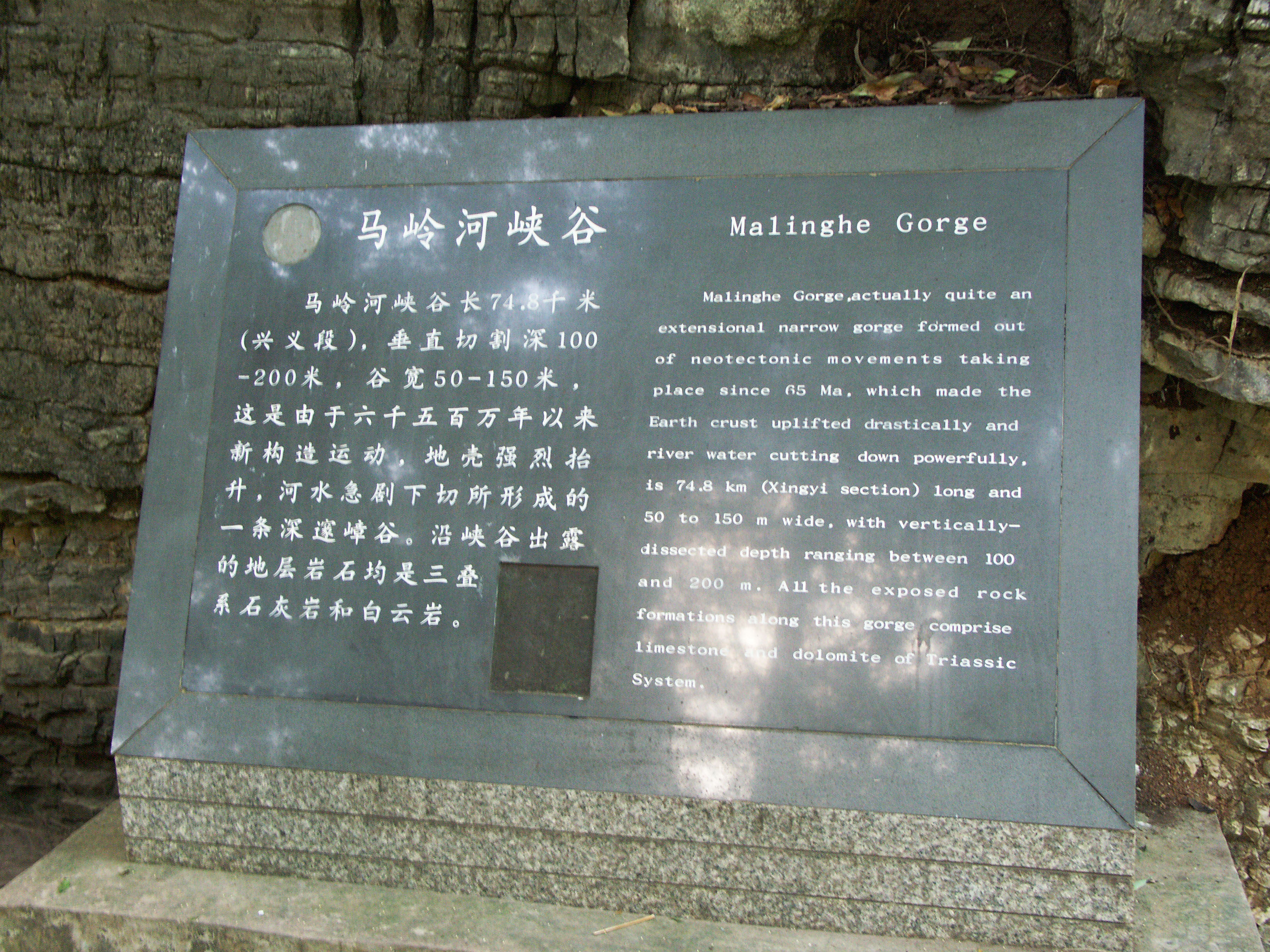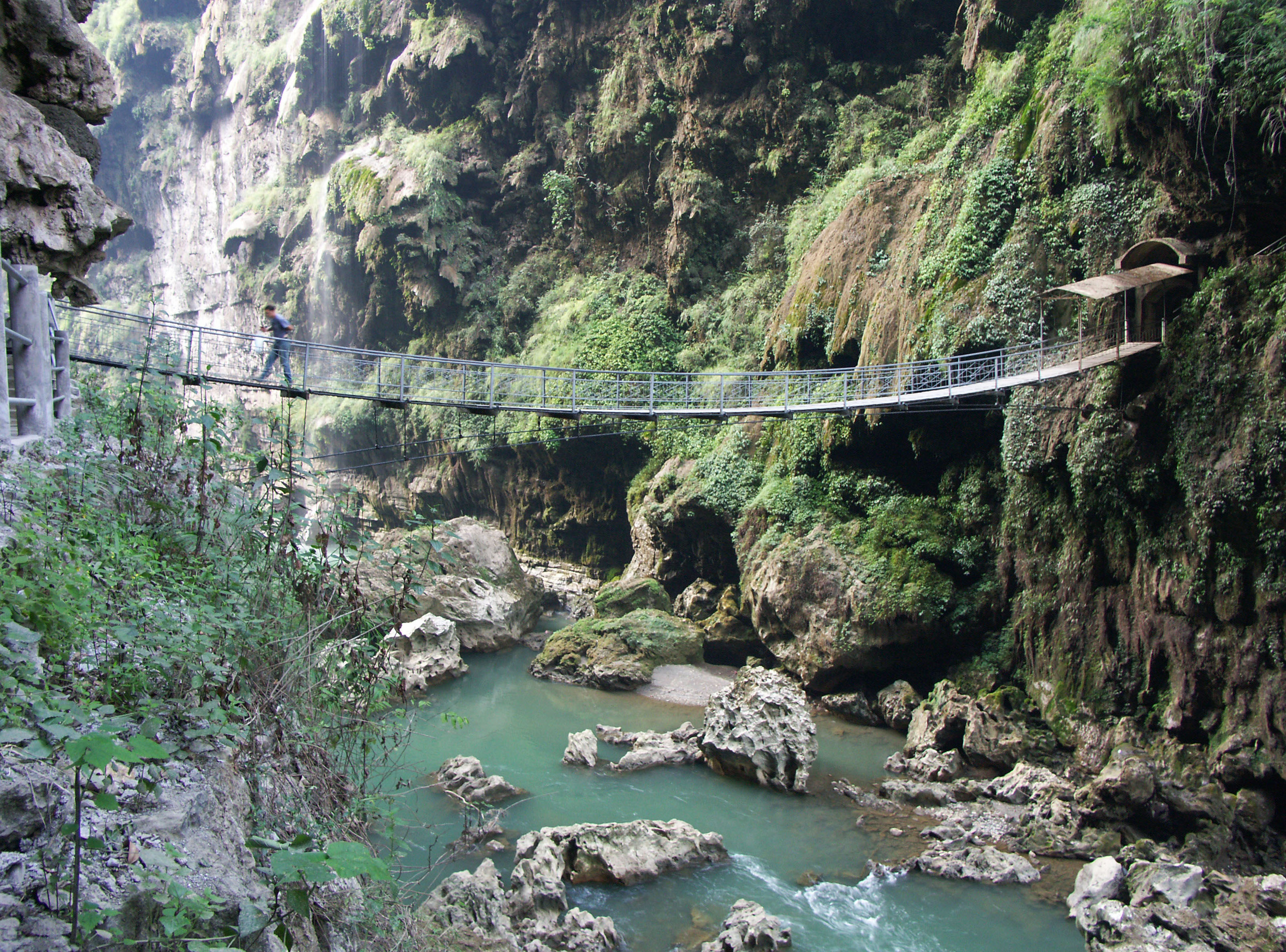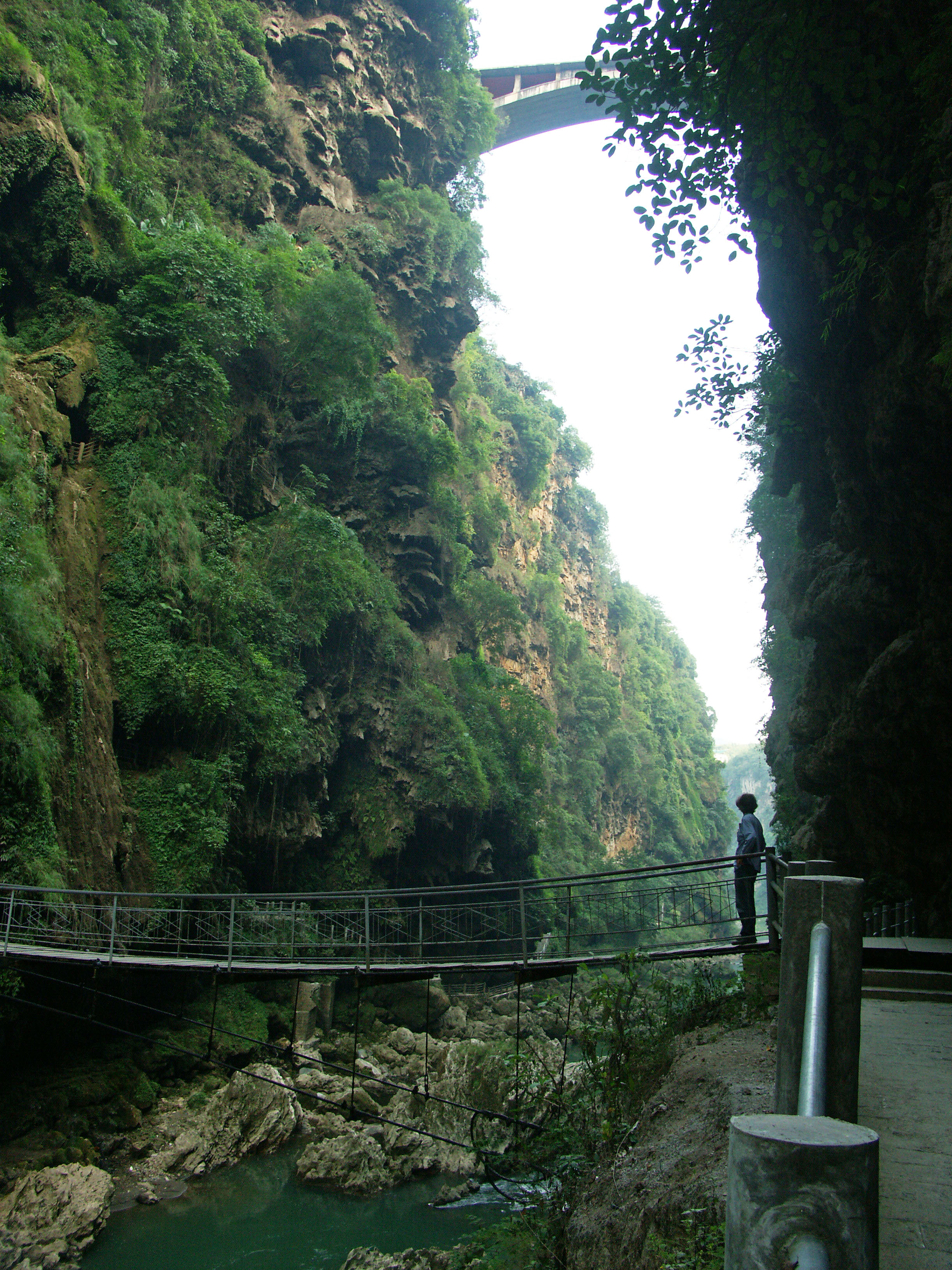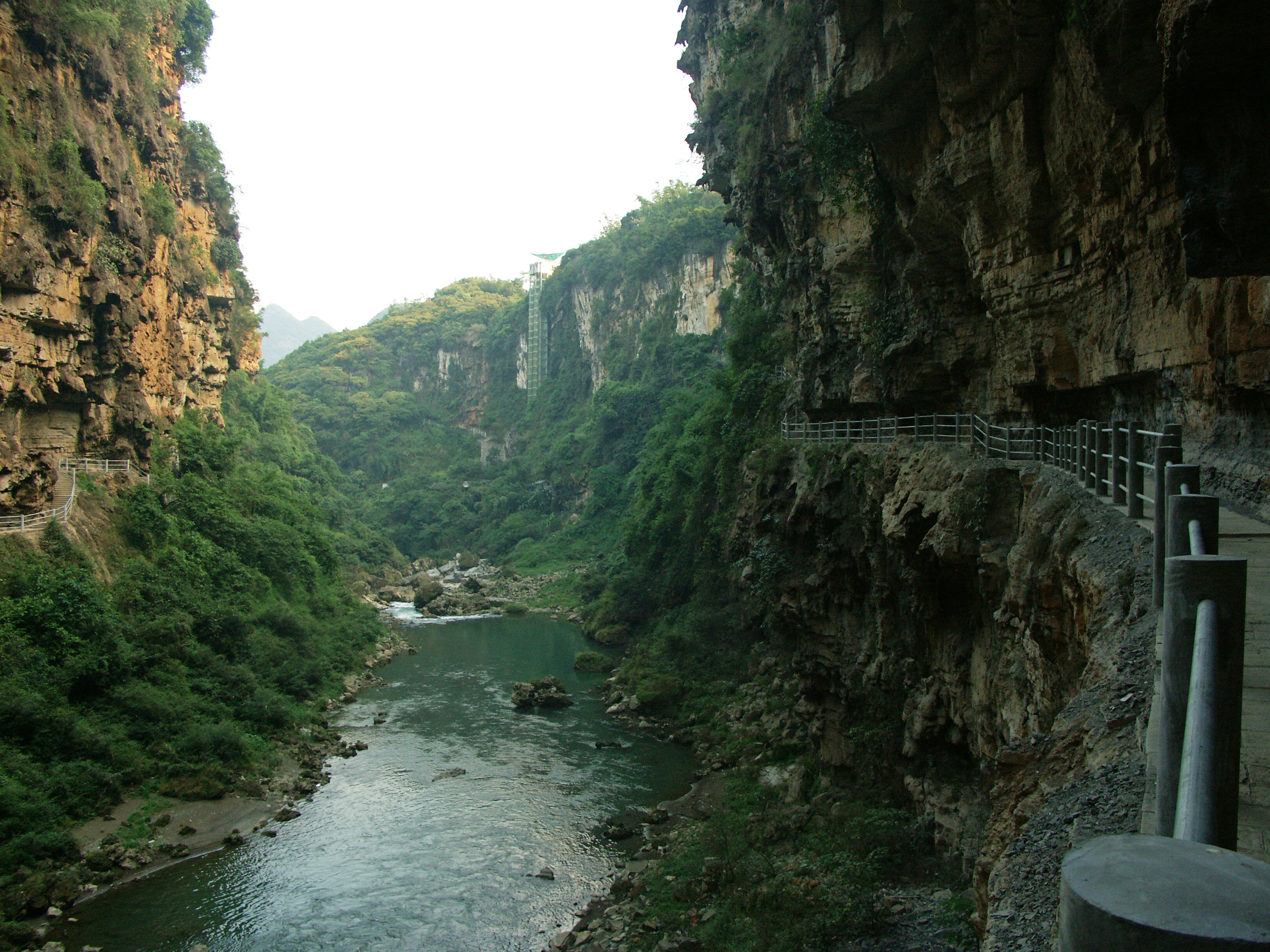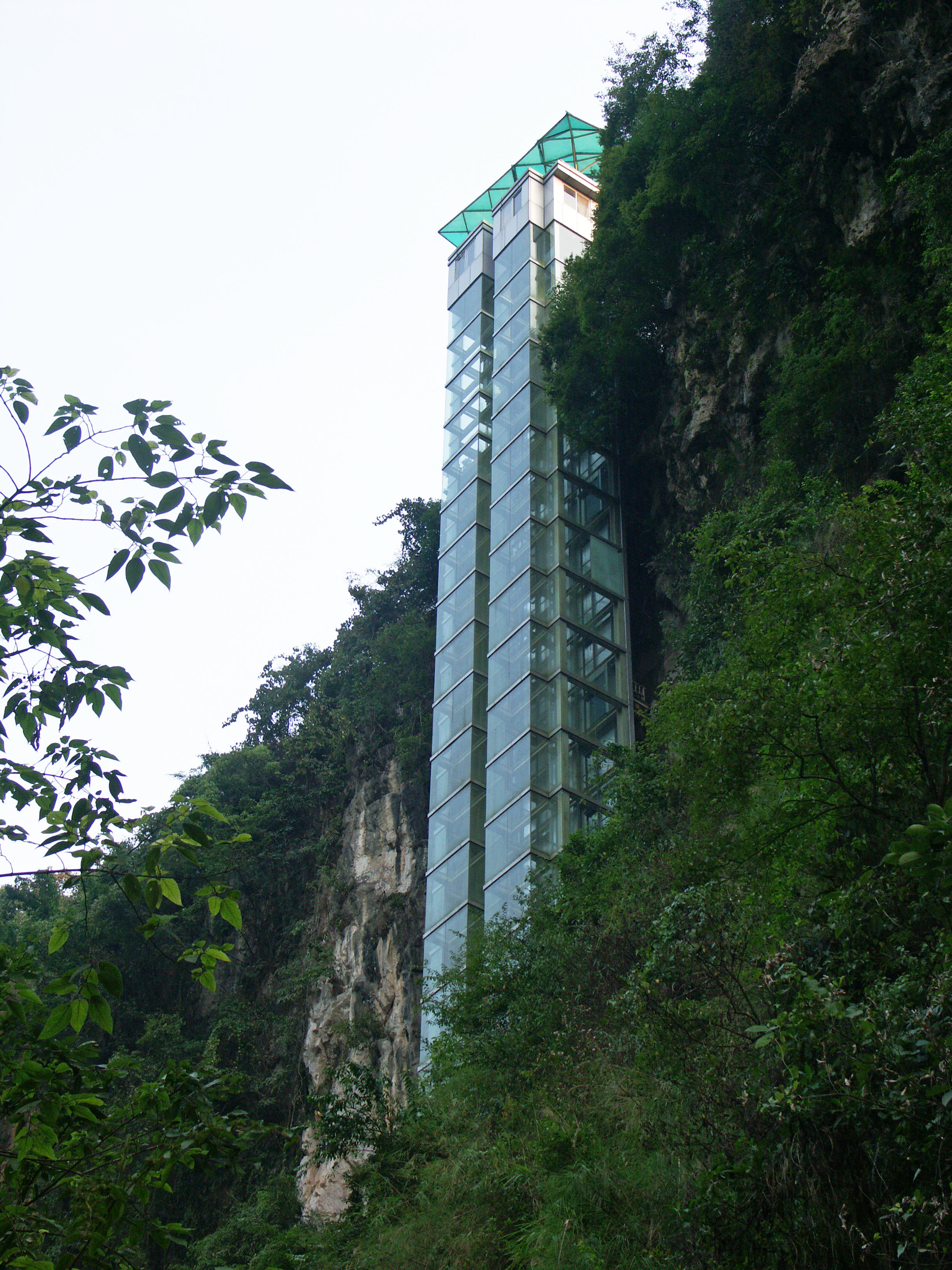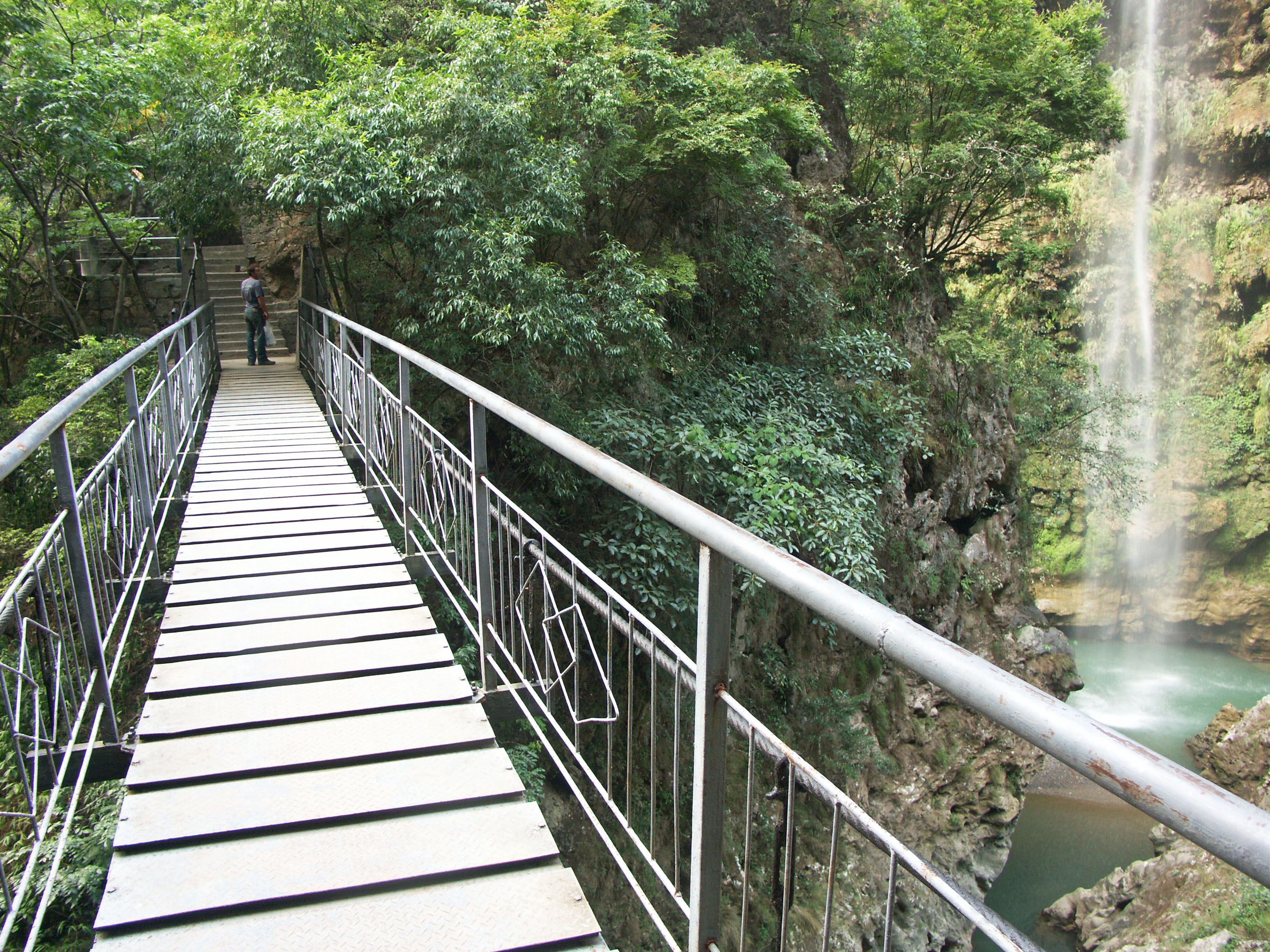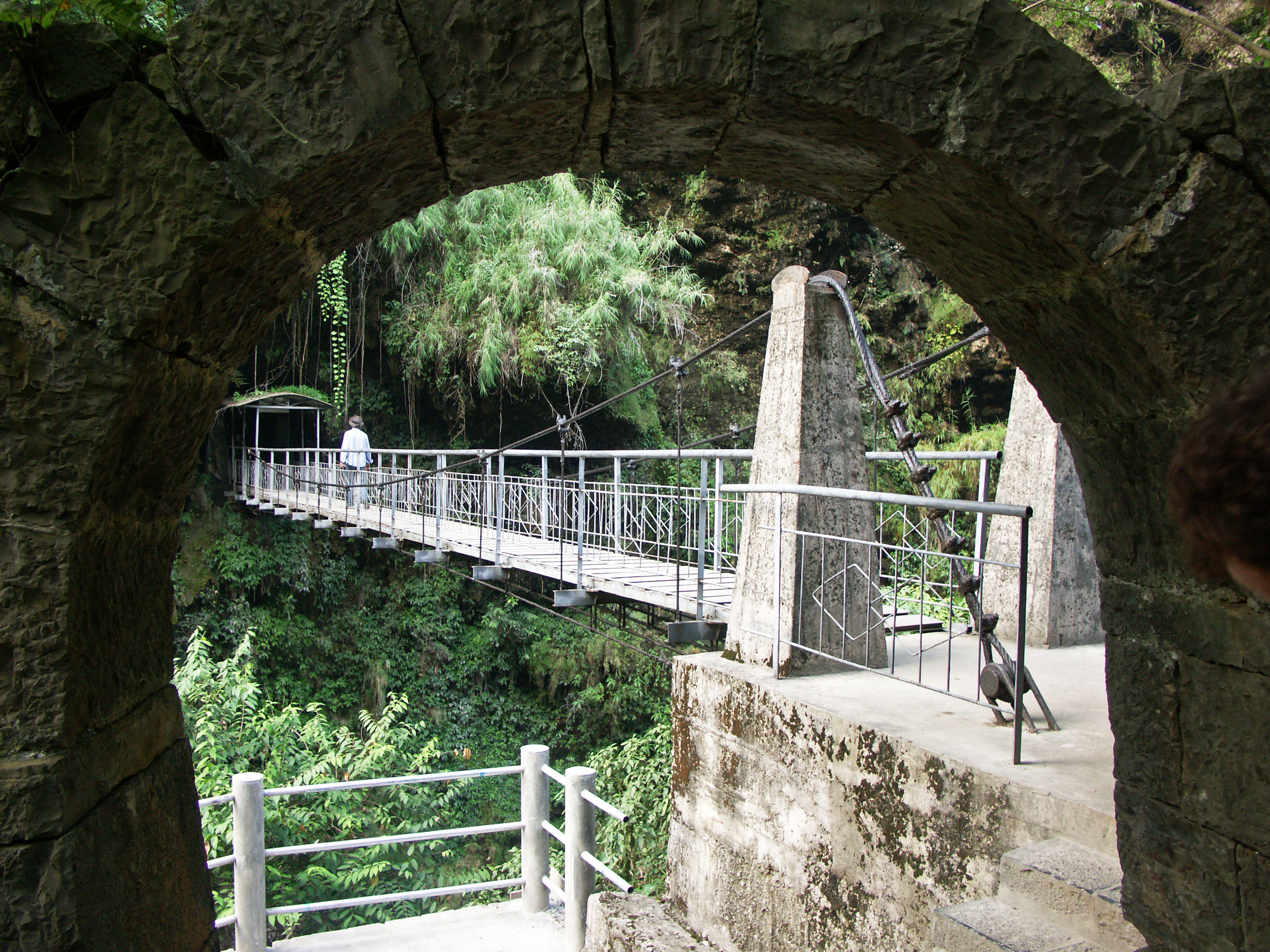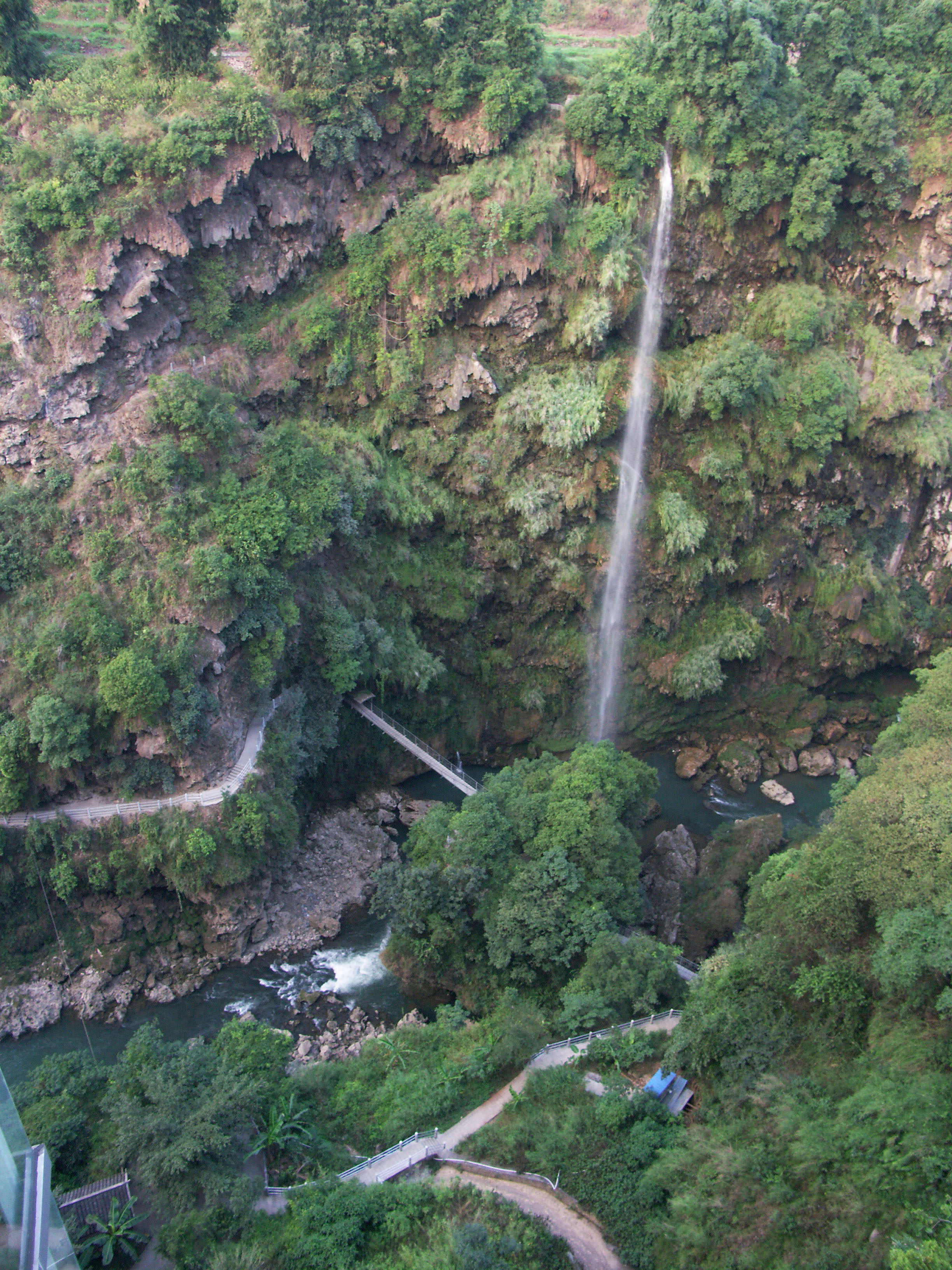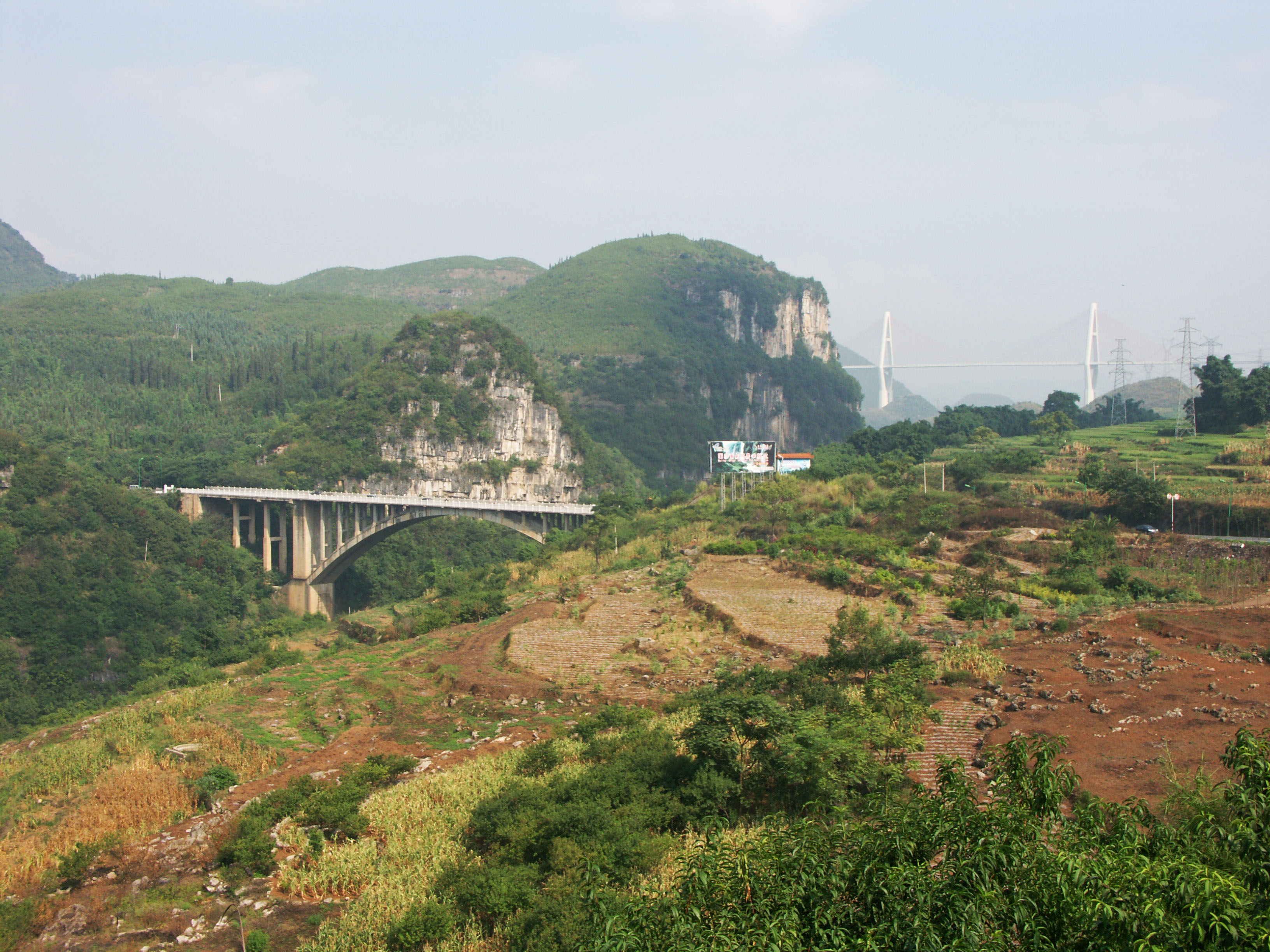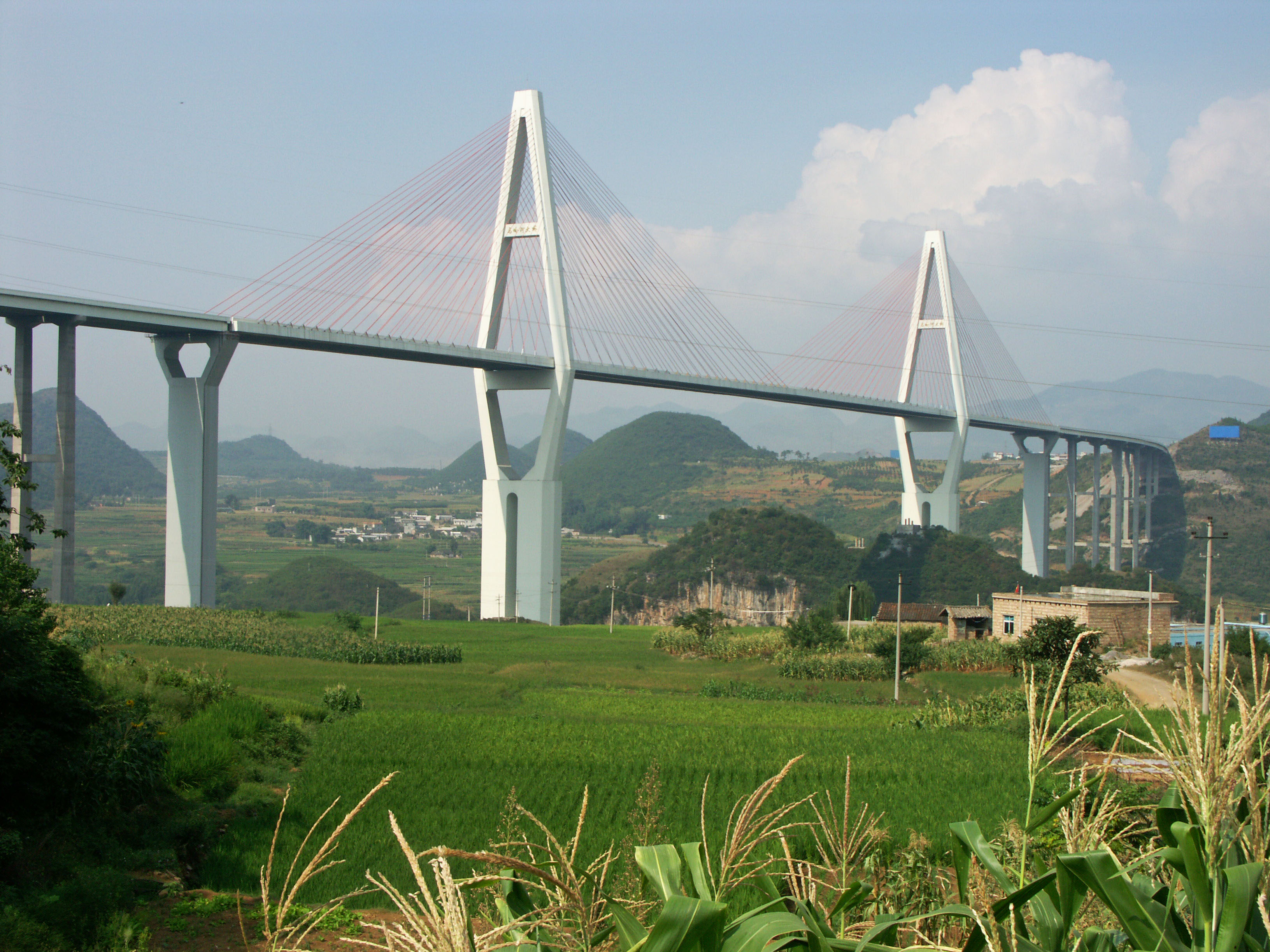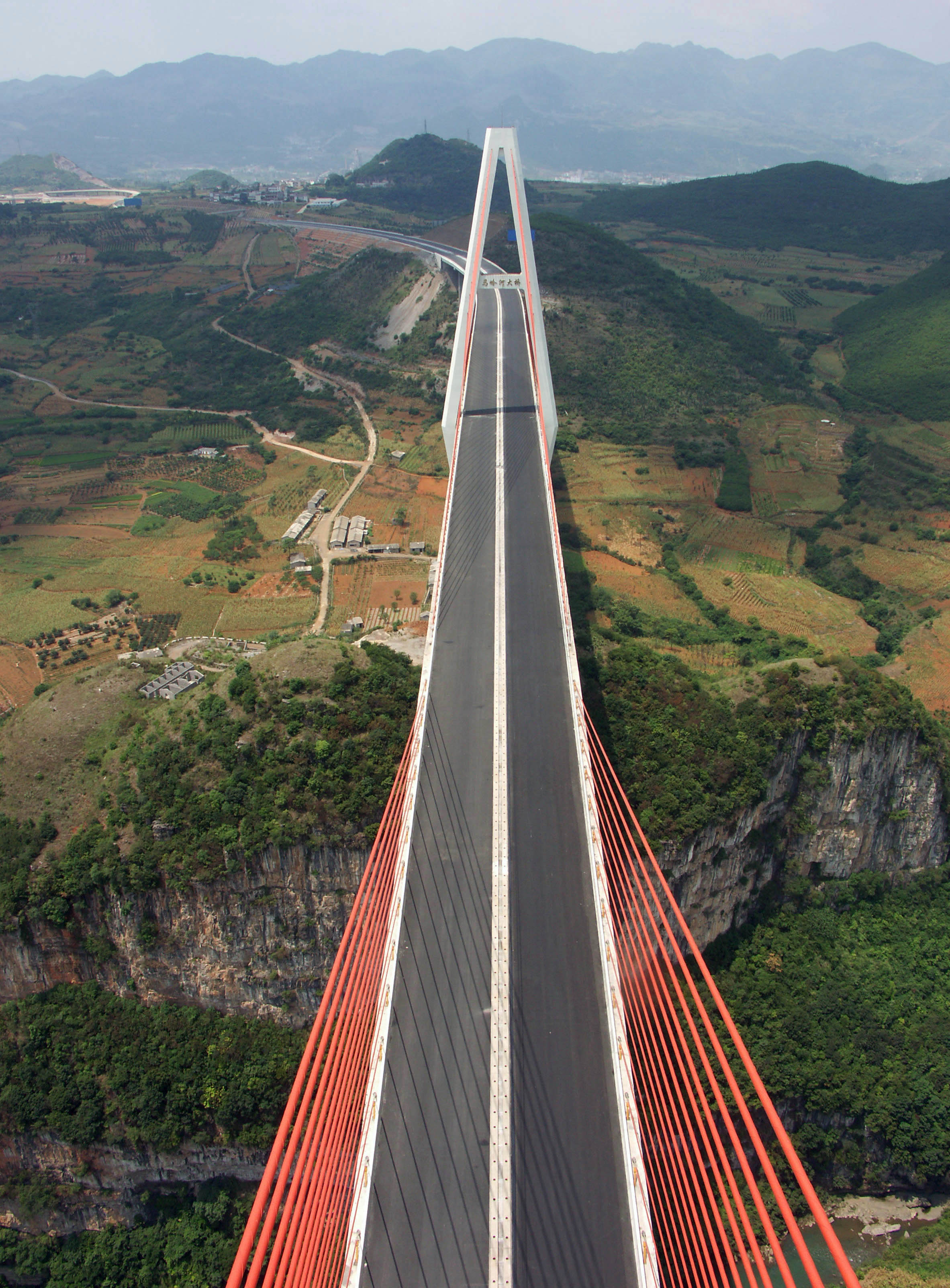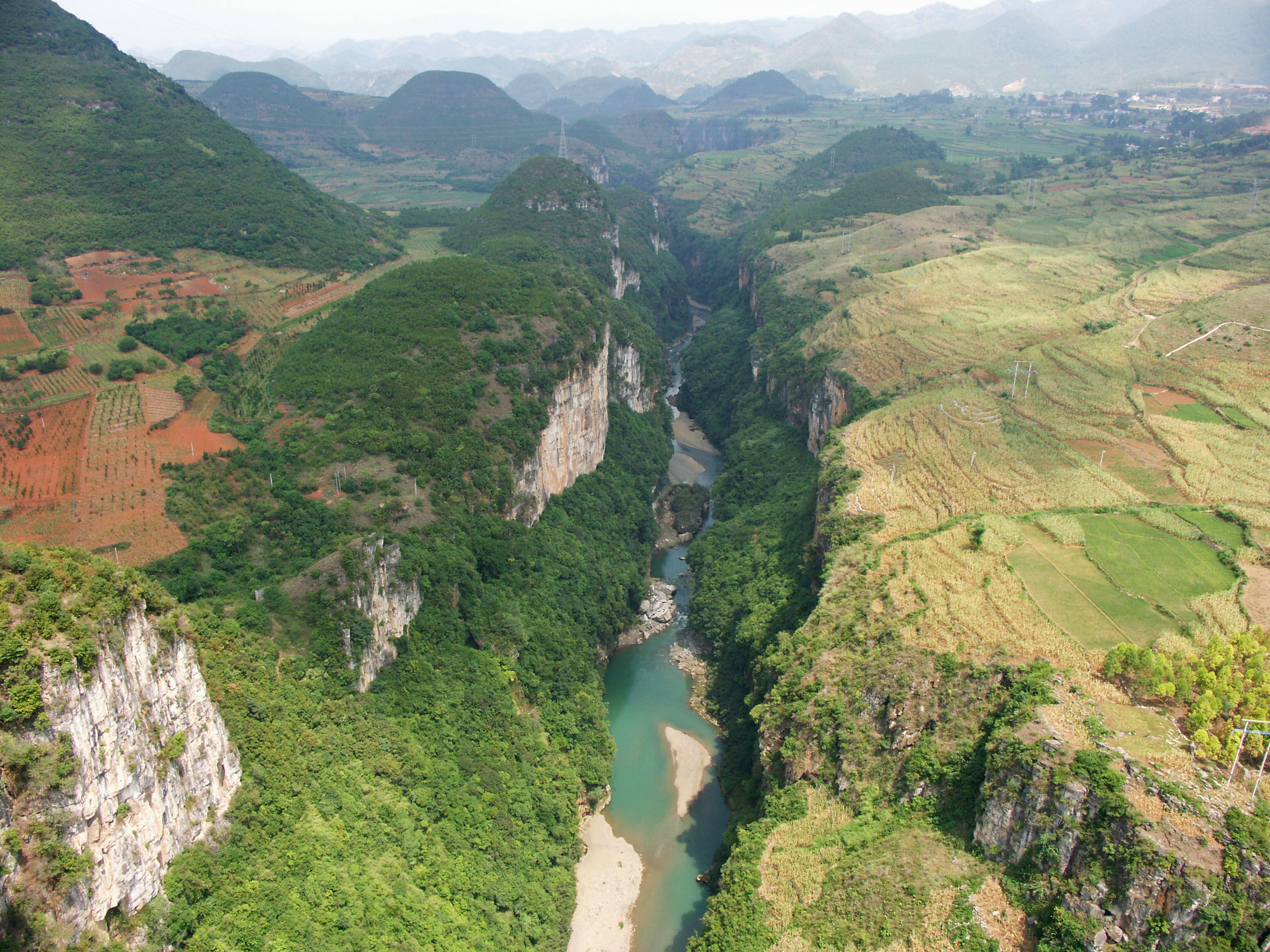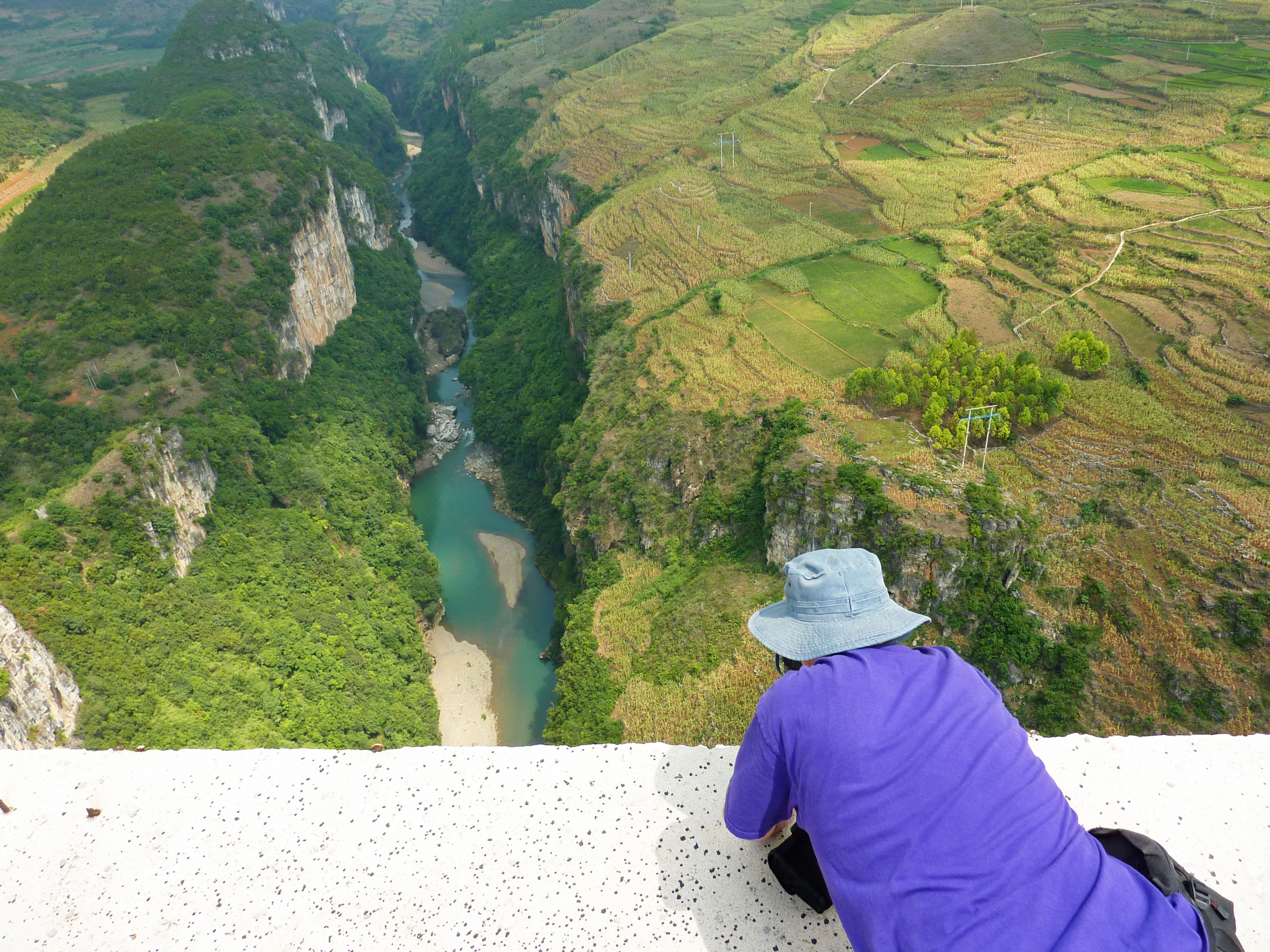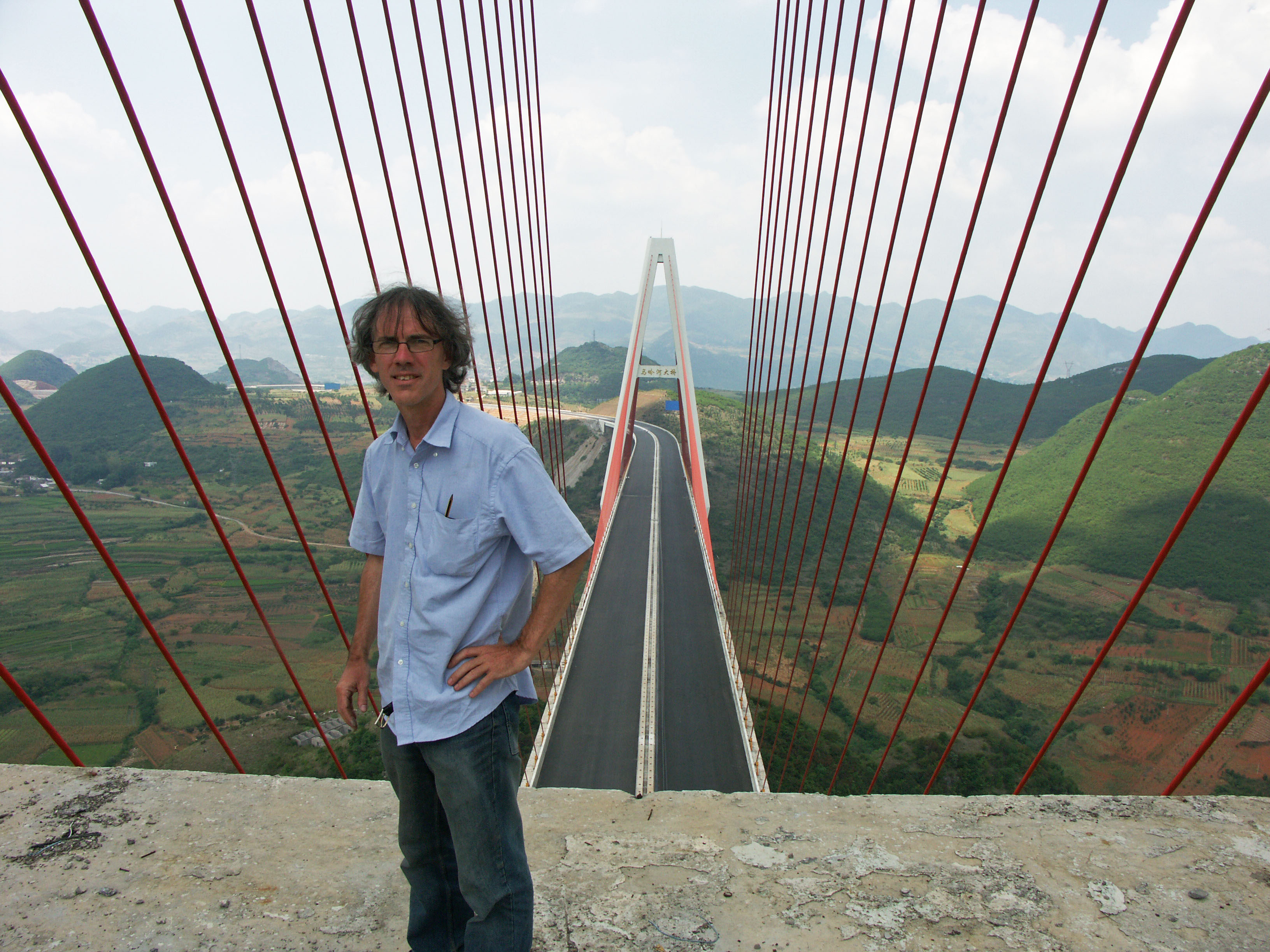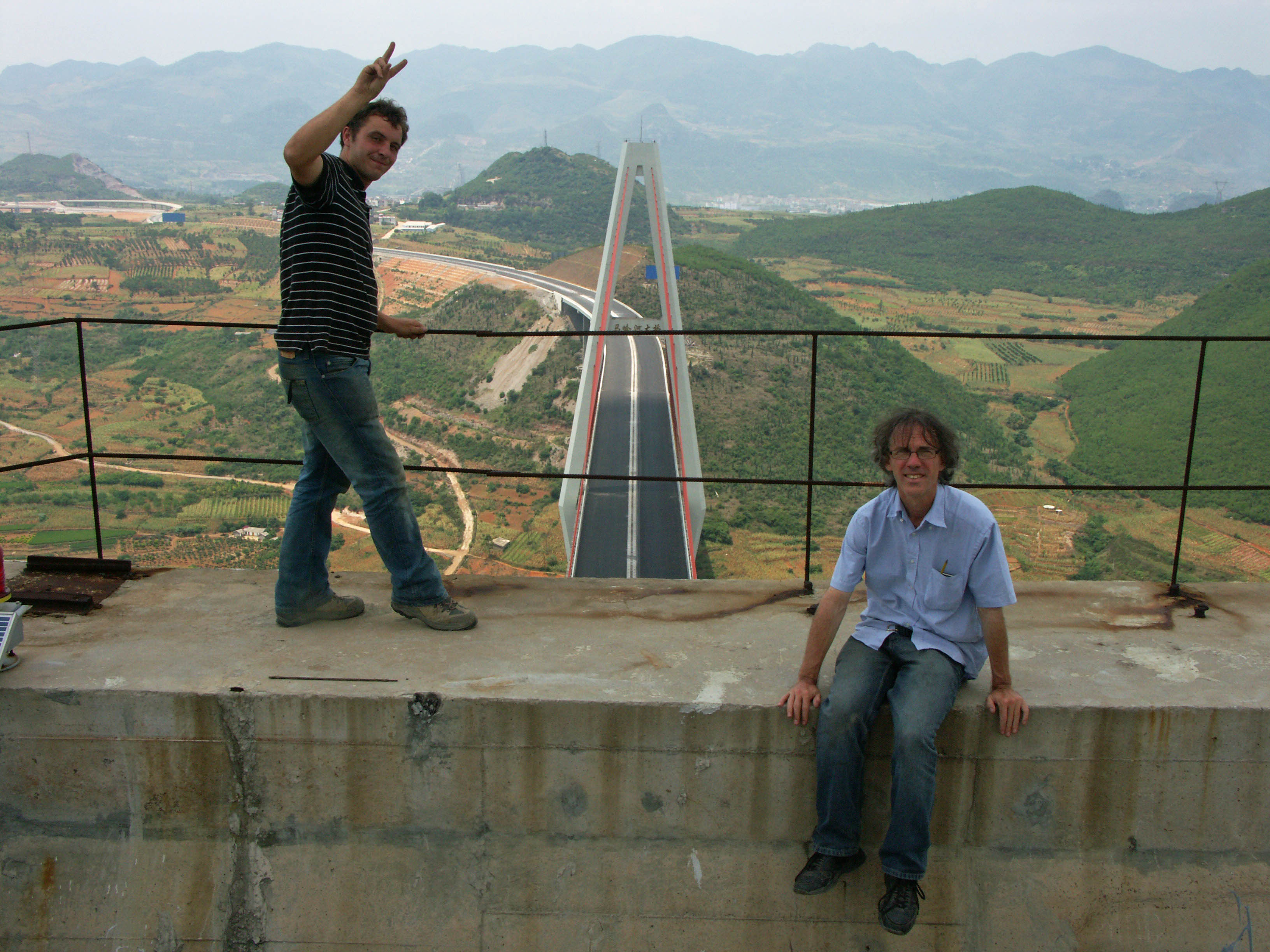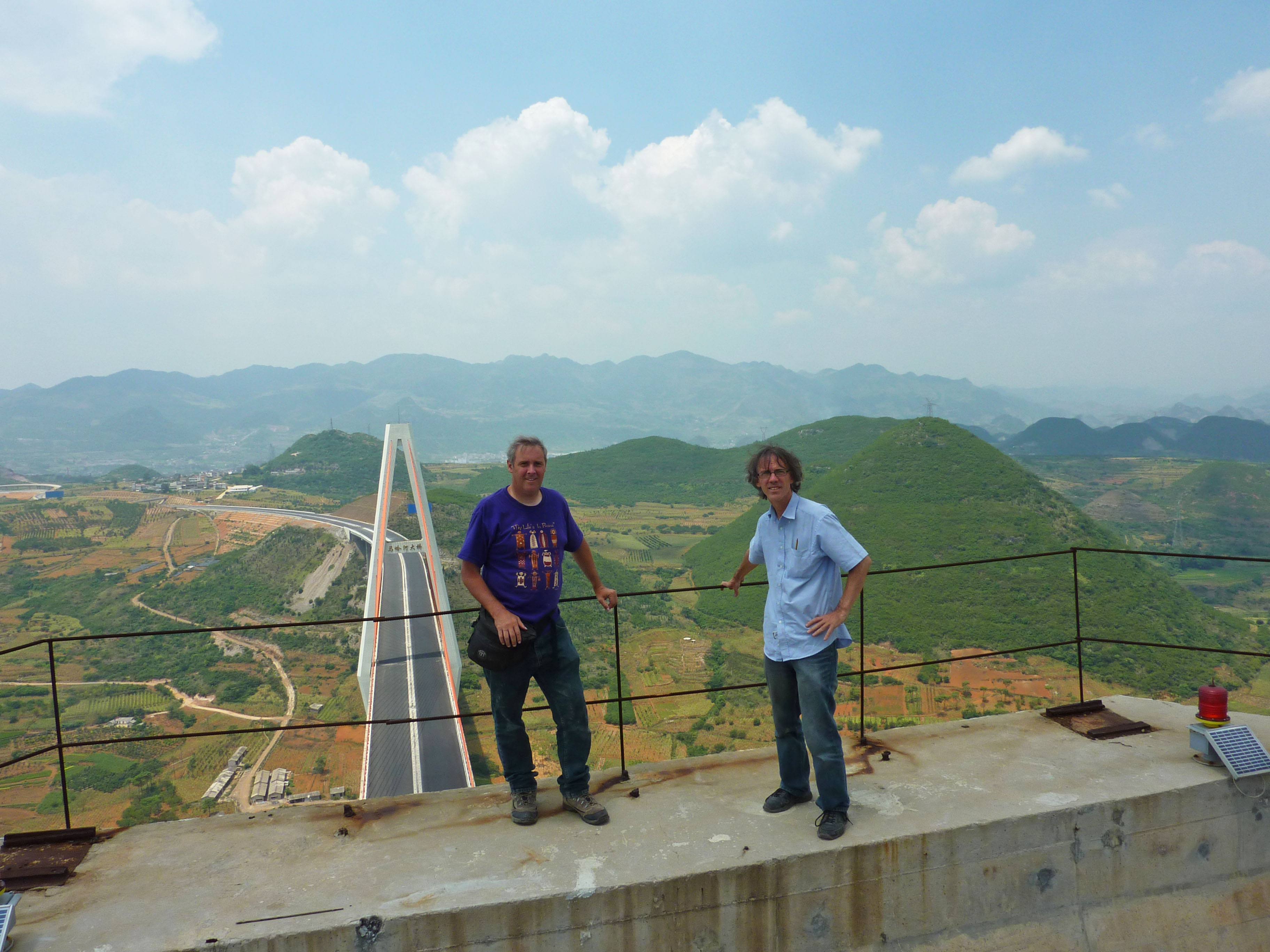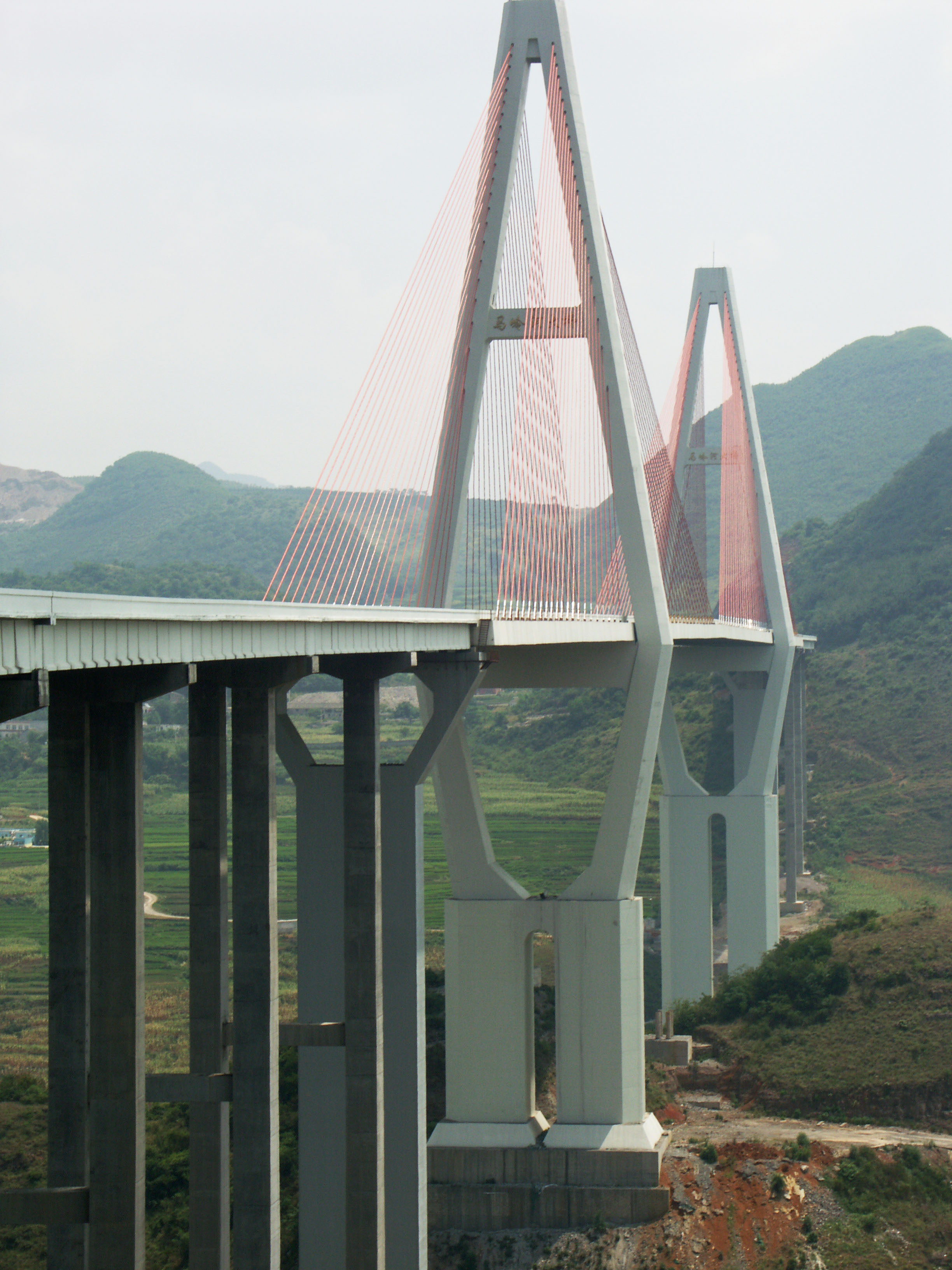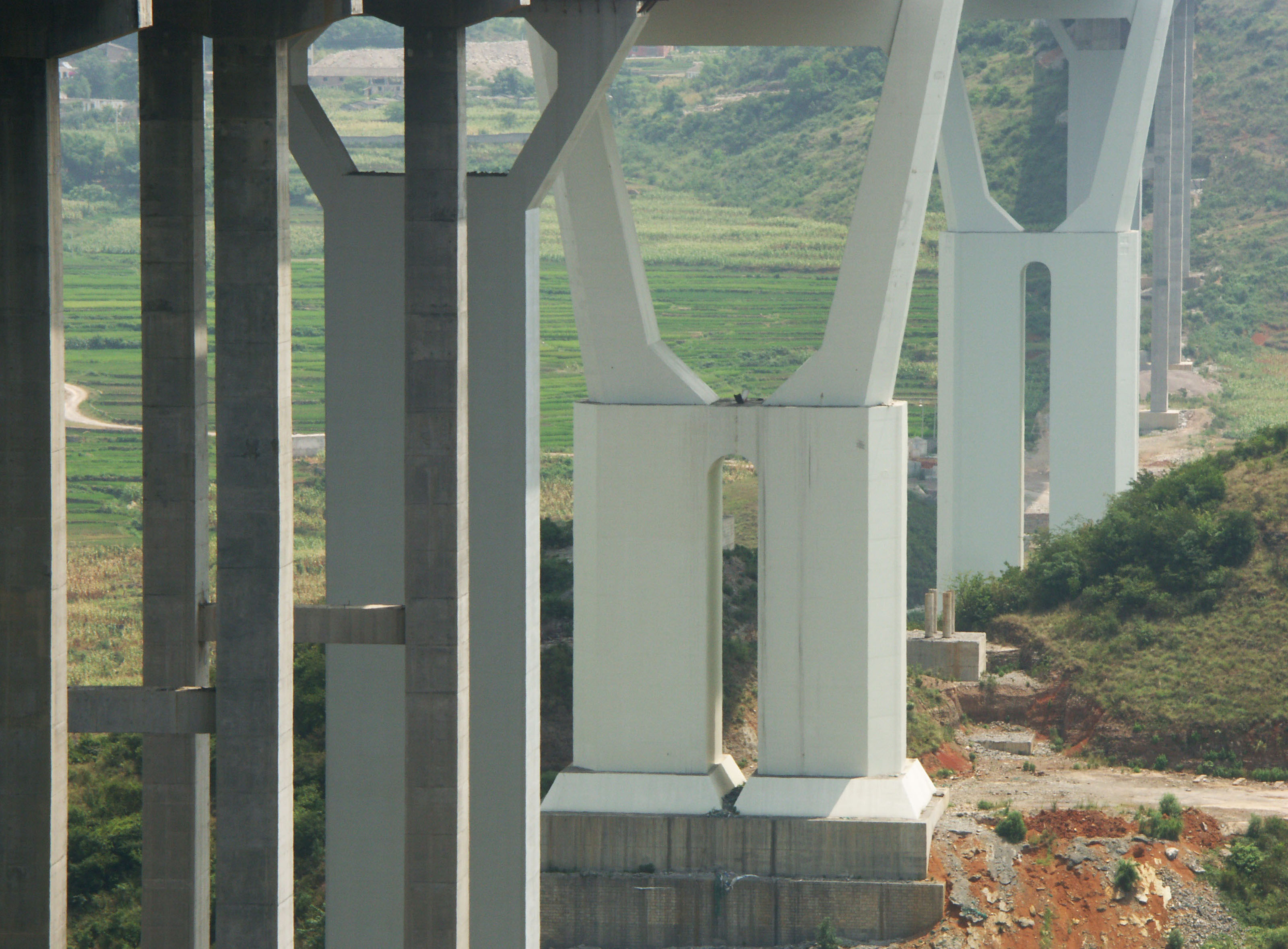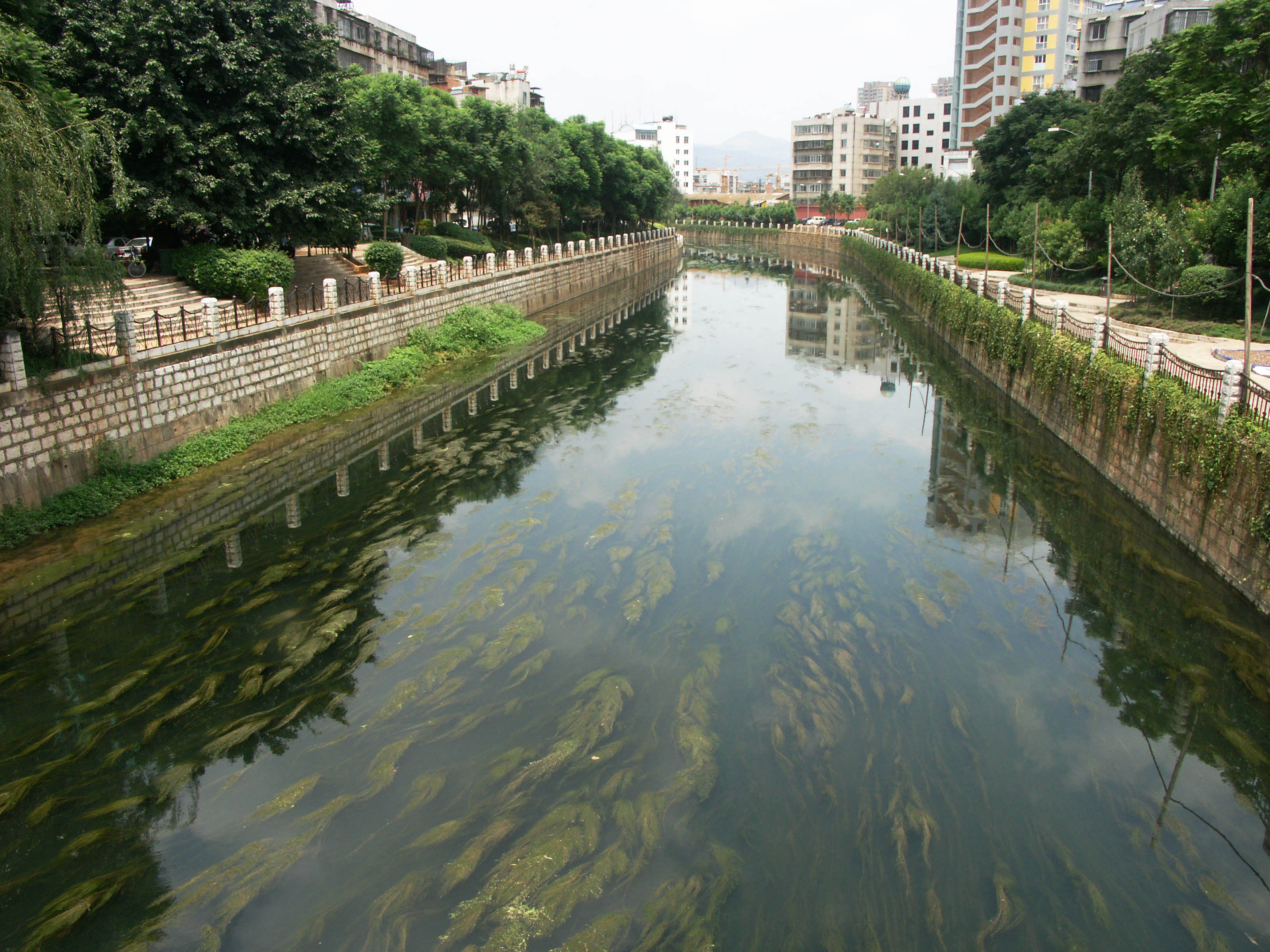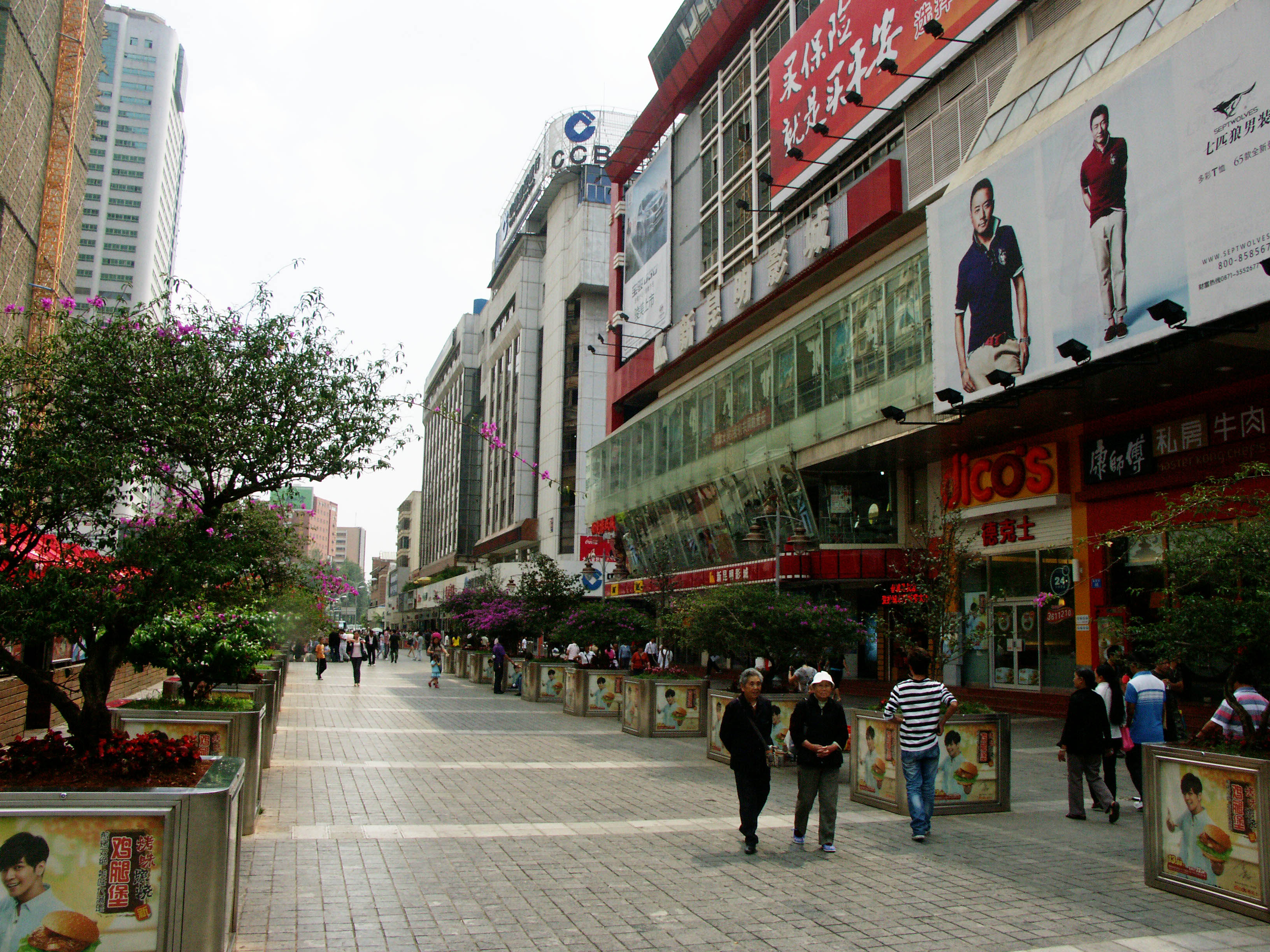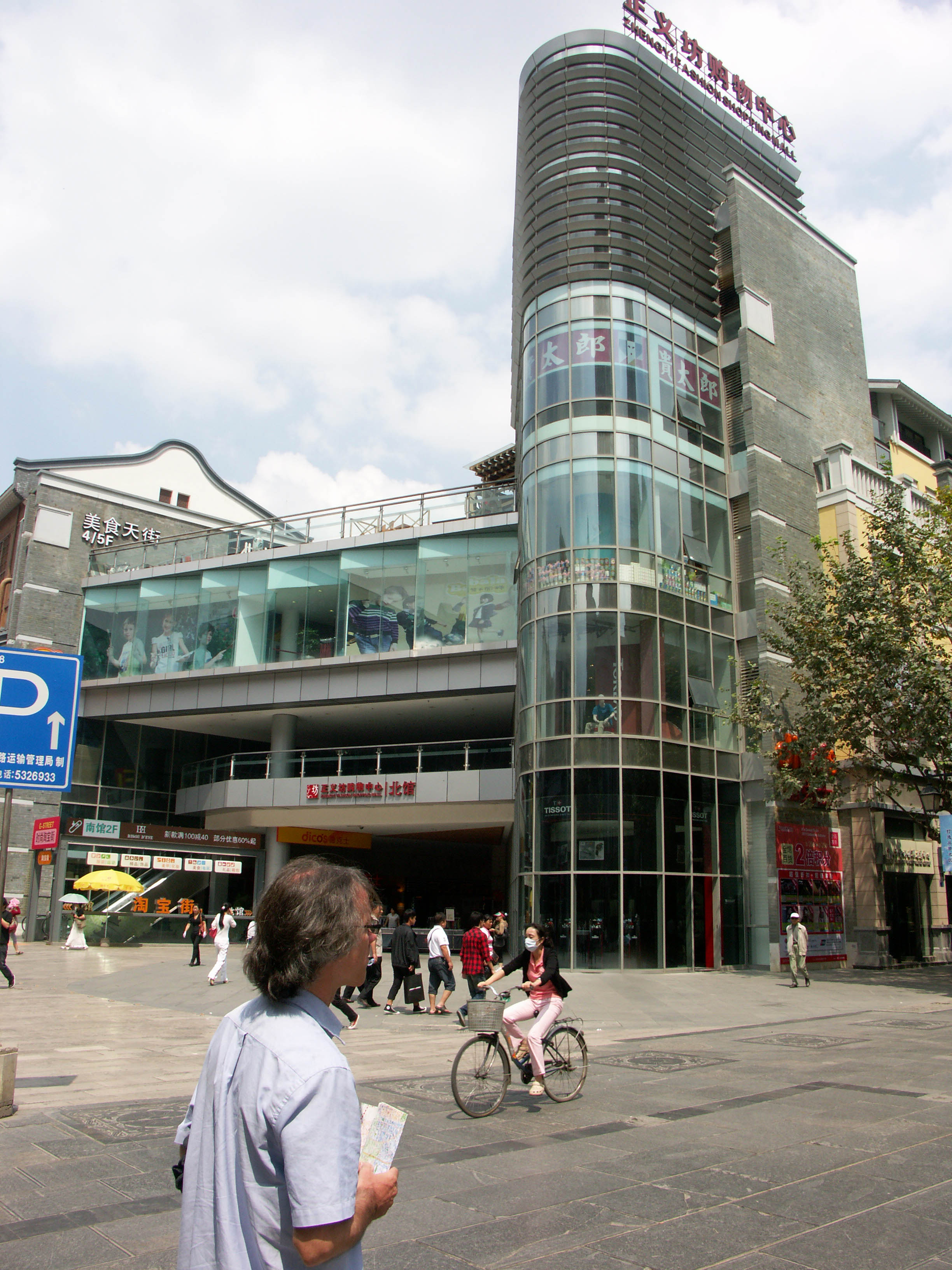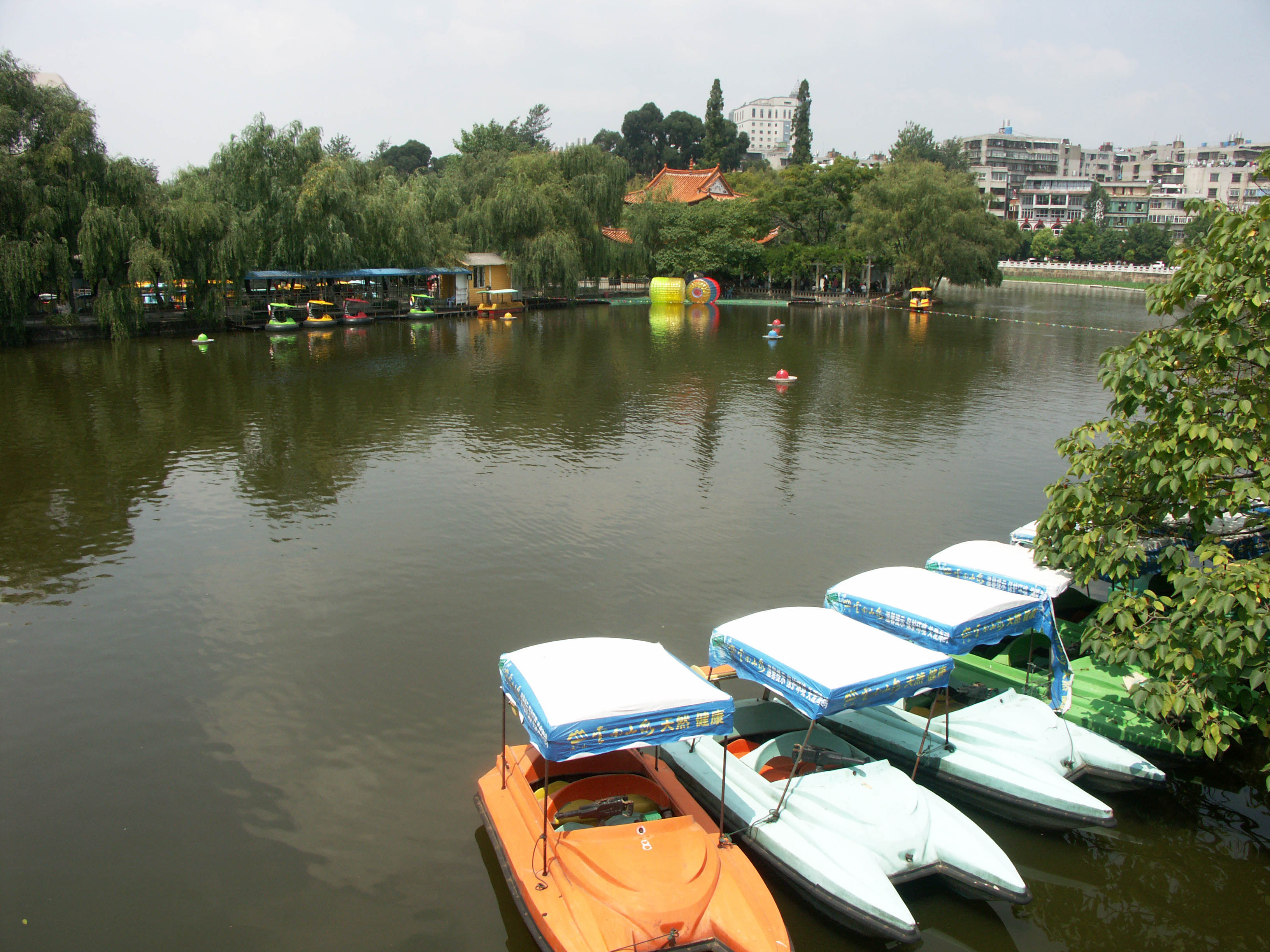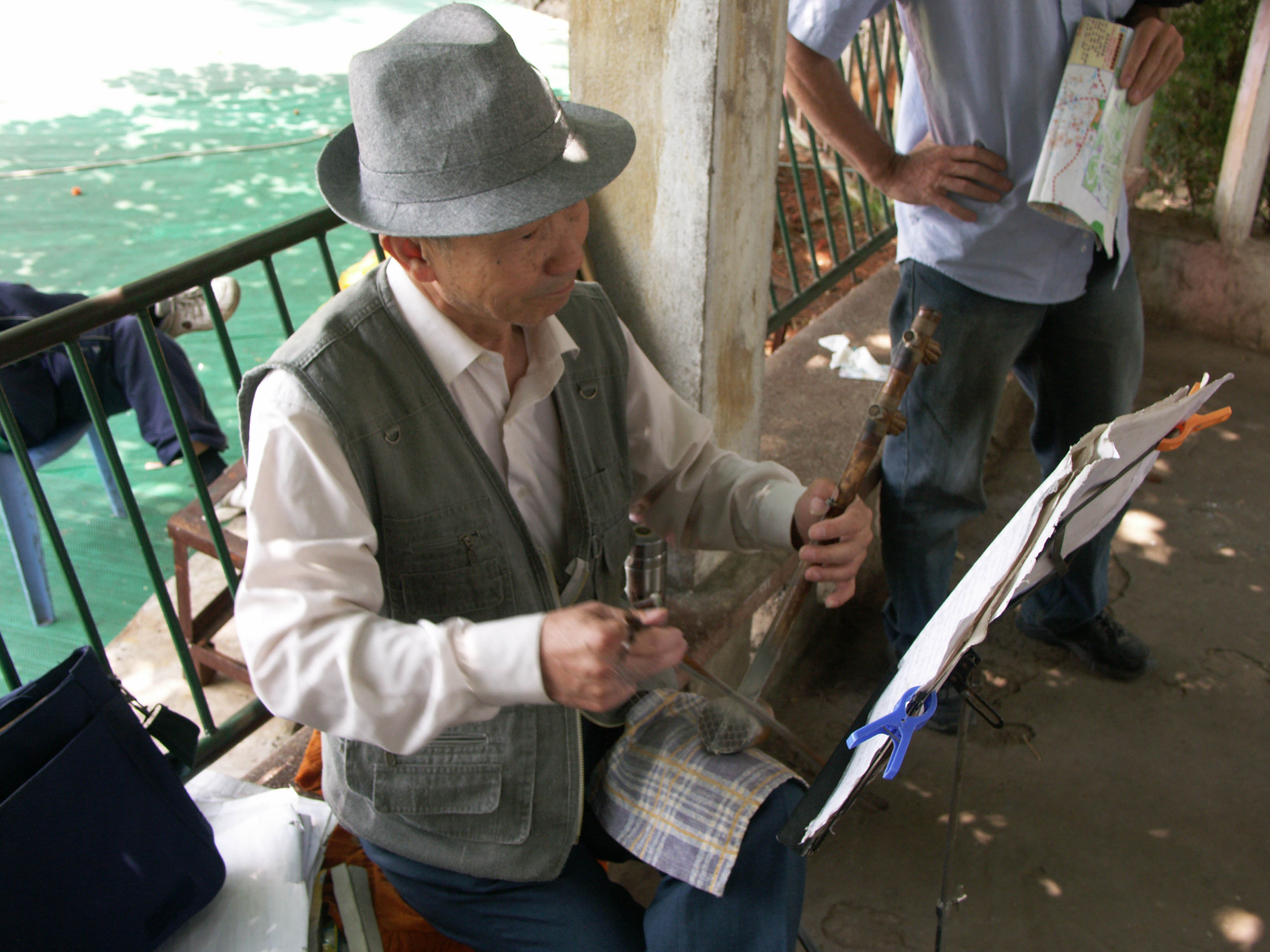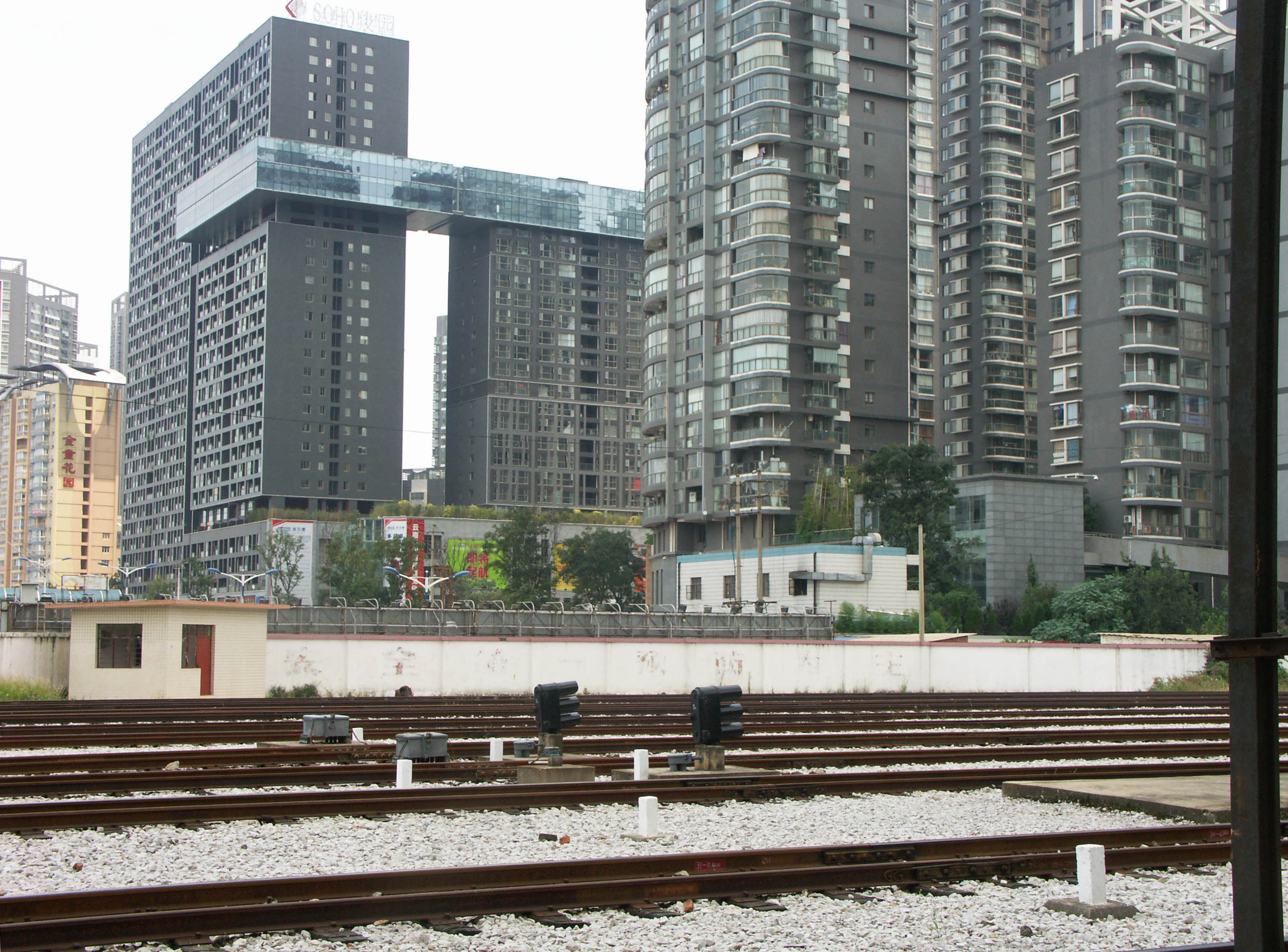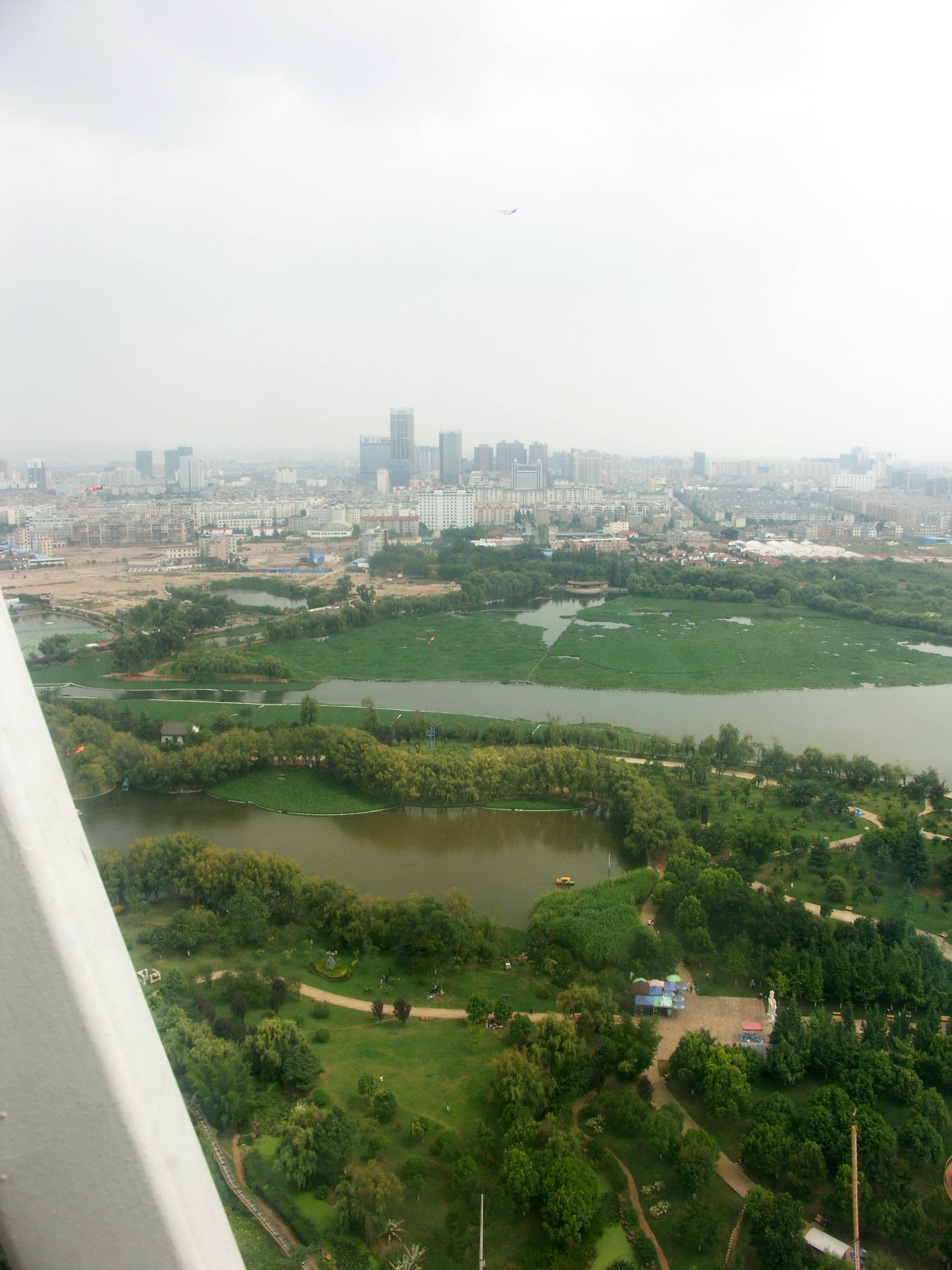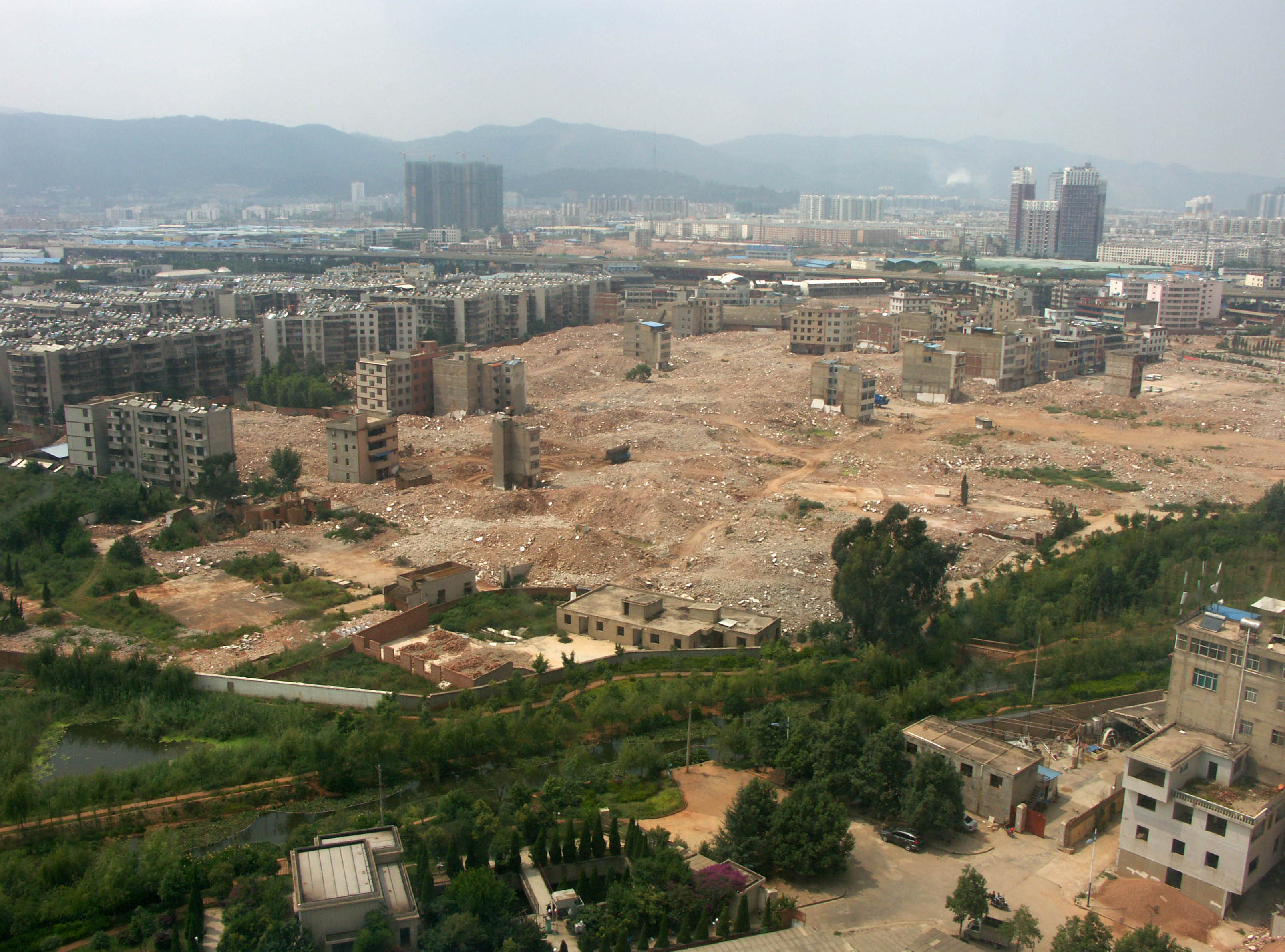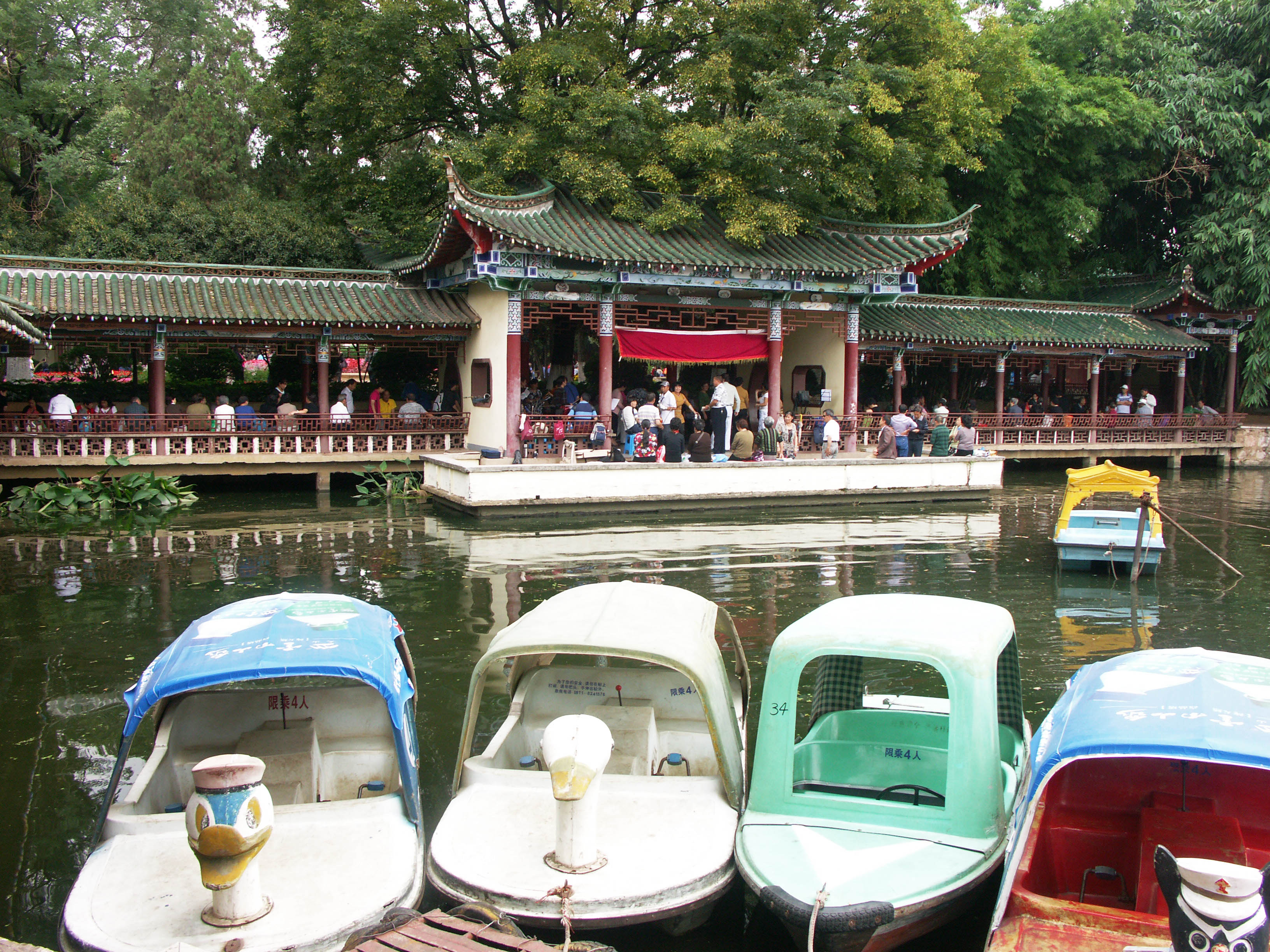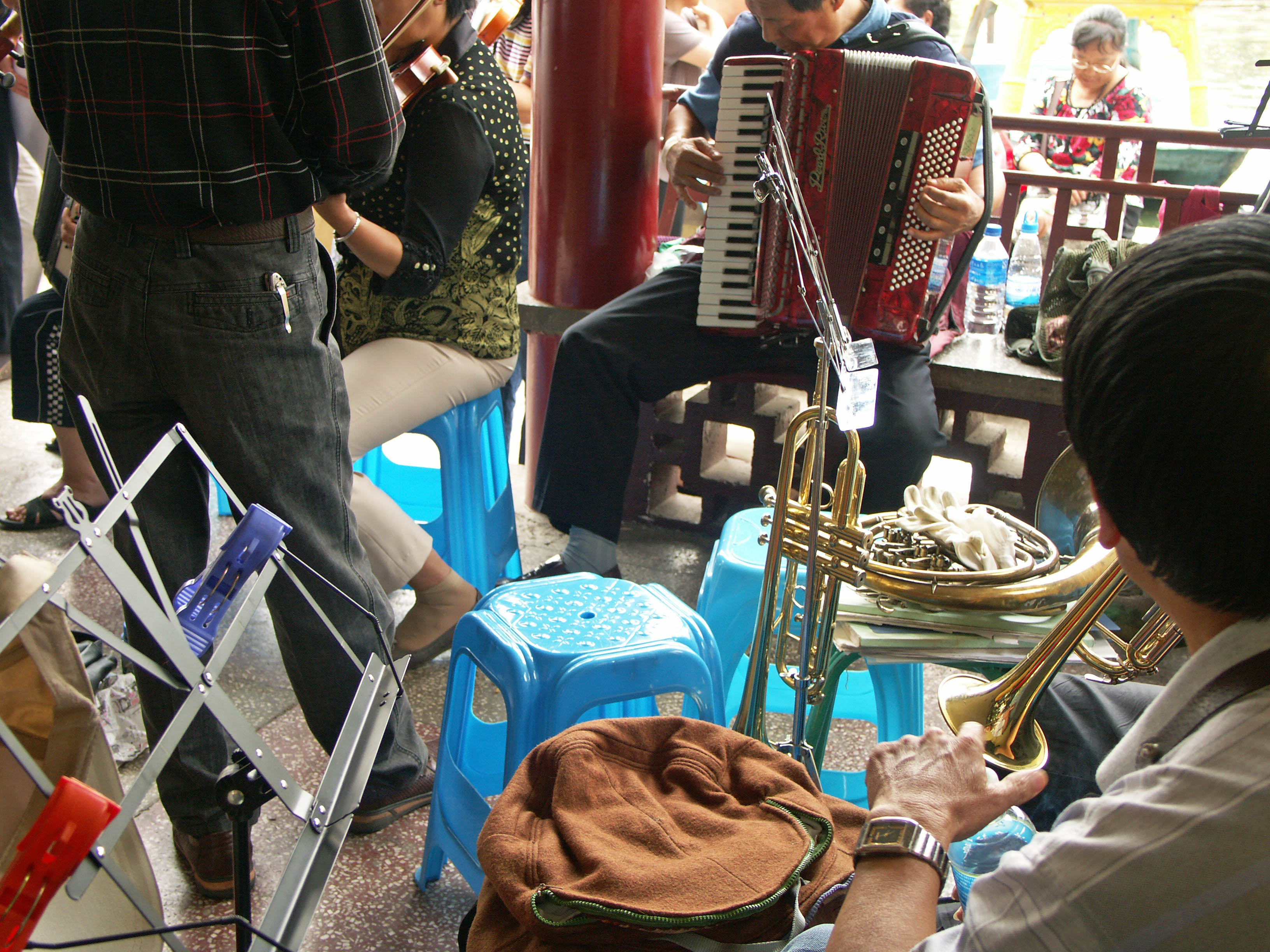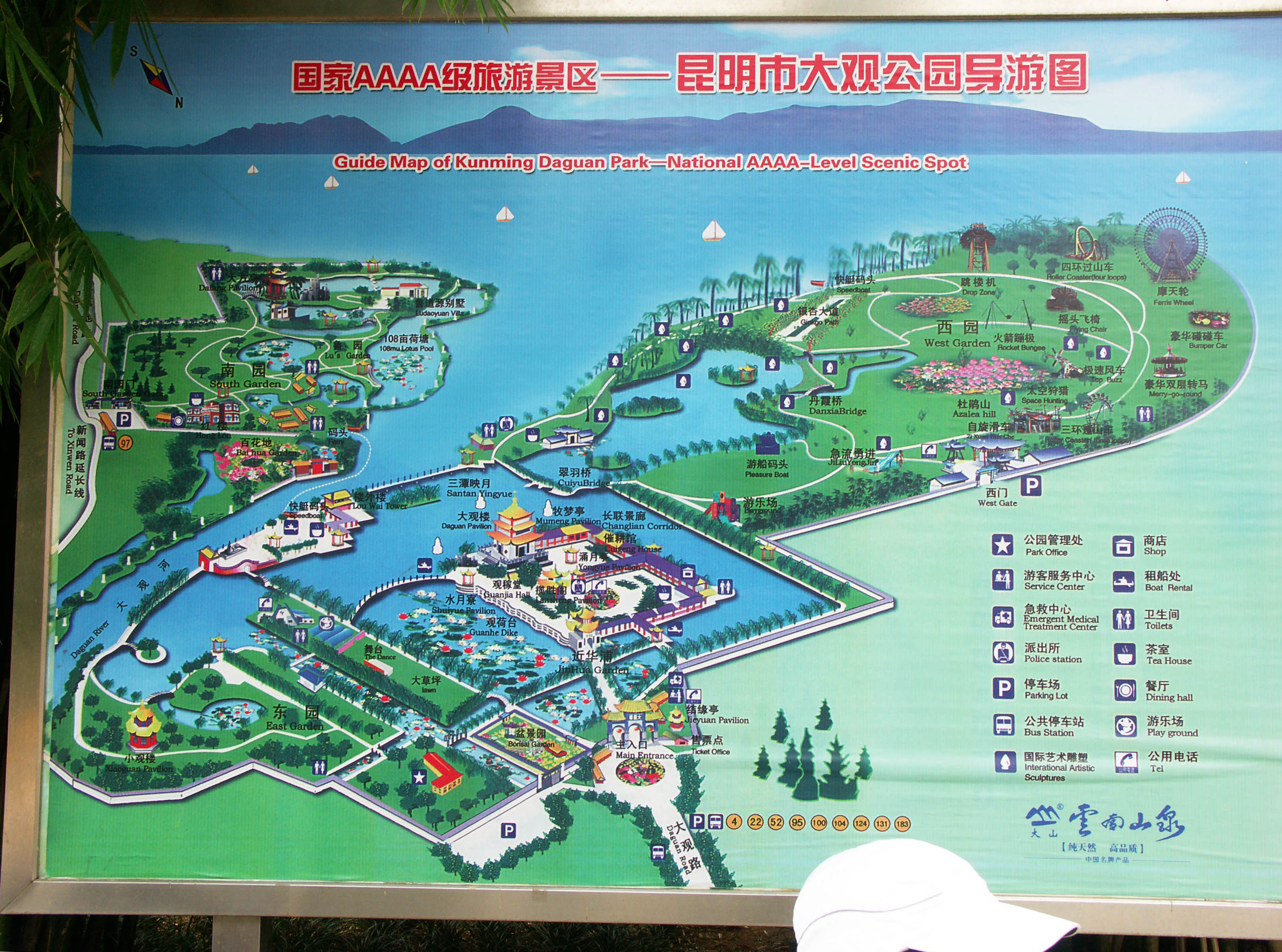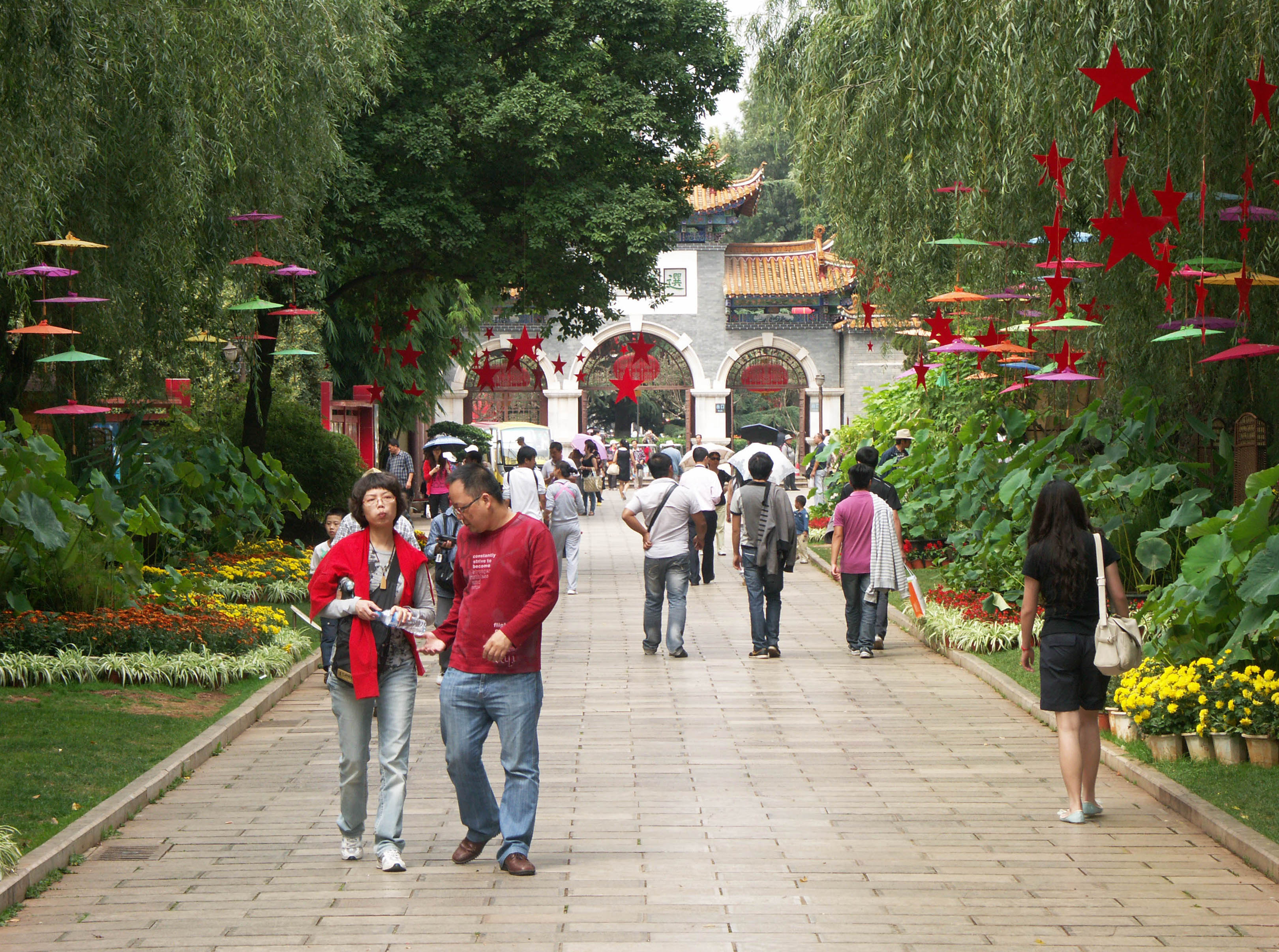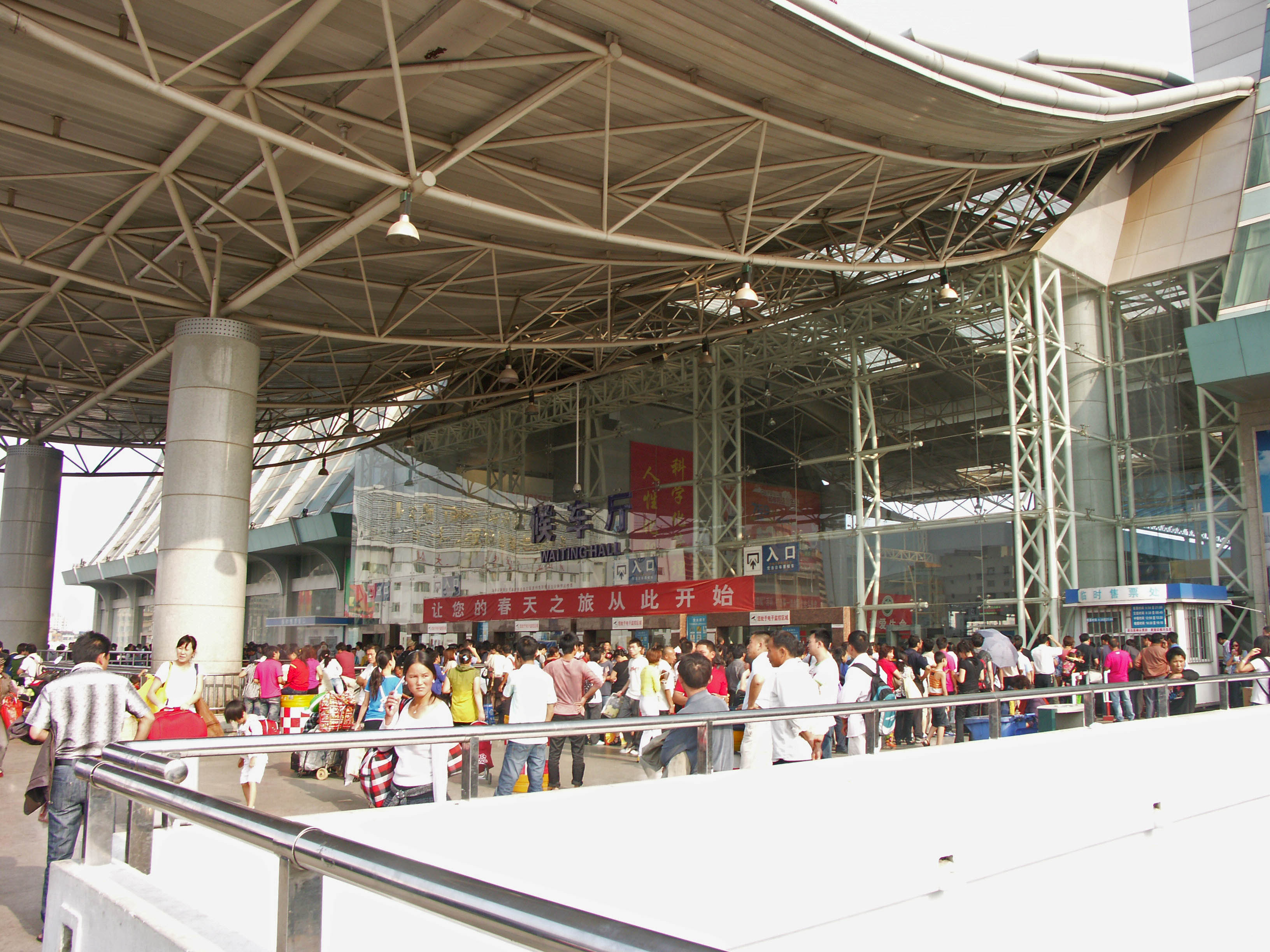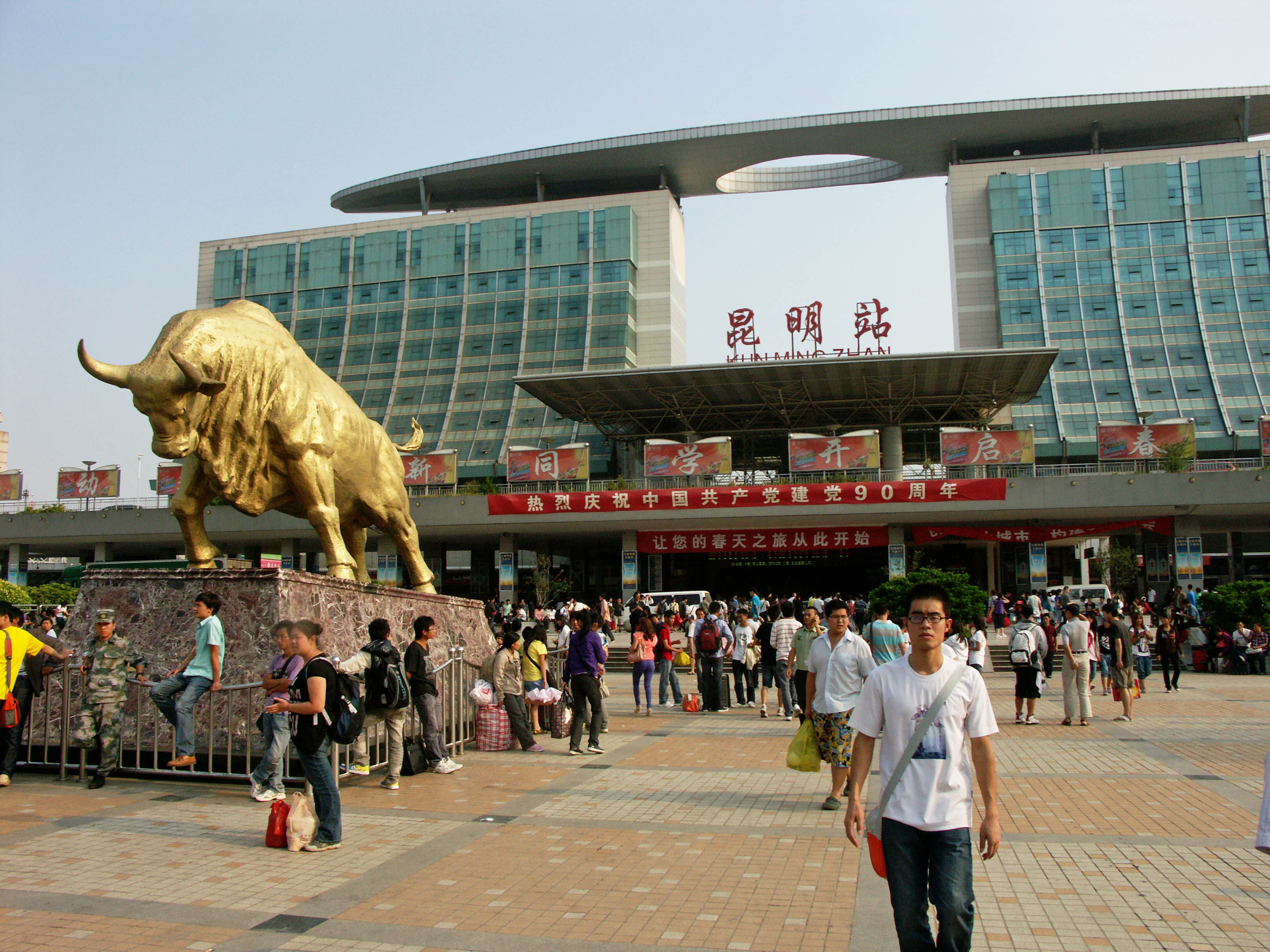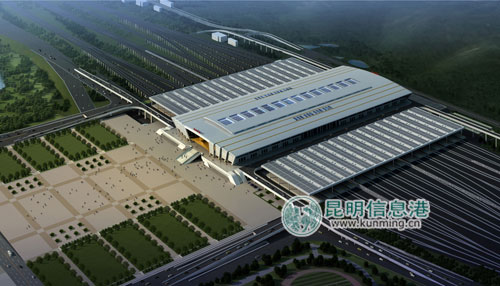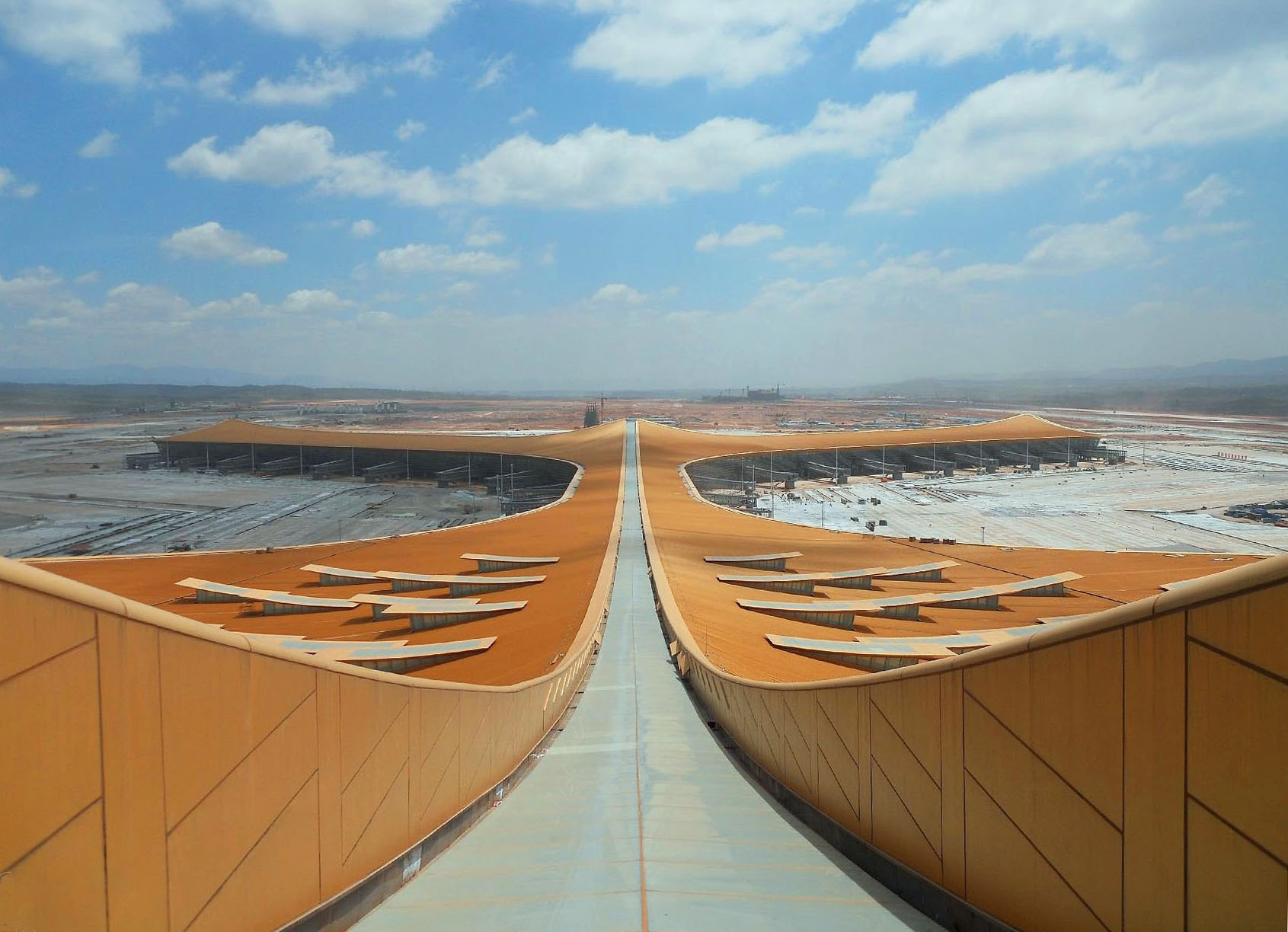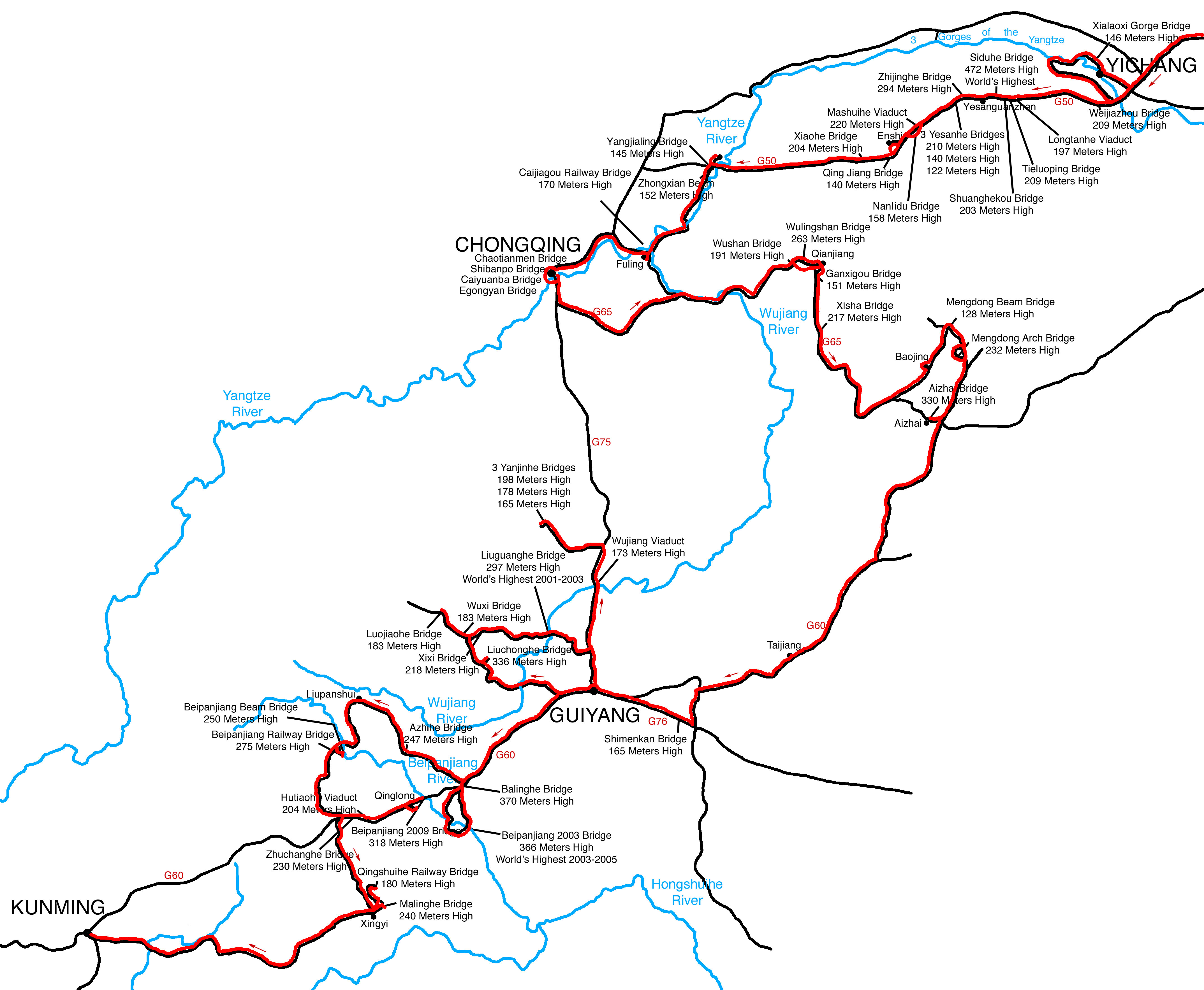2011 High Bridge Trip Photo Album/Week 3
2011 China High Bridge Trip Photo Album
Guizhou and Yunnan Provinces
The special spans visited during week three included Azhihe, Beipanjiang Railway, Beipanjiang 2009, Hutiaohe, Zhuchanghe, Qingshuihe Railway and Malinghe Gorge Bridges.
Perched between two cliffs, the Azhihe bridge is one of the 20 highest suspension bridges on earth with a deck 810 feet / 247 meters high. Similar in design to the nearby 2003 Beipanjiang Bridge, the extremely thin prestressed concrete slab deck is just 2 feet (.6 mtr) thick. The cable suspenders are a mere 16 feet (5 mtrs) apart. Image by Eric Sakowski / HighestBridges.com
The cable covers got quite rusty since my first visit in 2006. Image by Eric Sakowski / HighestBridges.com
A lot of locals head down into the valley on a trail next to the north end of the bridge. Image by Eric Sakowski / HighestBridges.com
Image by Eric Sakowski / HighestBridges.com
A visit in 2011 reveals a new gravel storage area under the North tower. Sandbags surround each pier to protect them from the rock piles. Image by Eric Sakowski / HighestBridges.com
Image by Eric Sakowski / HighestBridges.com
Image by Eric Sakowski / HighestBridges.com
Image by Eric Sakowski / HighestBridges.com
Image by Eric Sakowski / HighestBridges.com
The Qingshui arch is the second high bridge on the road to Liupanshui with a deck to water height of 150 meters. Image by Eric Sakowski / HighestBridges.com
The truss arch span is very similar in design to the Yanjinhe arch bridge we visited a few days earlier in Renhuai. Image by Eric Sakowski / HighestBridges.com
Our hotel in Liupanshui was the nicest of the entire trip with well decorated rooms and a rare bathroom where the shower area was separate from the toilet. Image by Eric Sakowski / HighestBridges.com
Image by Eric Sakowski / HighestBridges.com
They even sold Viagra! Image by Eric Sakowski / HighestBridges.com
The toll booths for local highway 212 were no longer in use. Like many of China's National Roads, the 2-lane highways are being bypassed by modern 4-lane expressways that will reduce travel times and distances significantly. By 2015 the G56 will allow people from Liupanshui to drive to almost any other place in China on a 4-lane expressway. Image by Eric Sakowski / HighestBridges.com
After more then an hour along one of Guizhou's roughest dirt roads we finally reached the Beipanjiang arch and currently the highest railway bridge in the world. We became the first Westerners to ever visit the span. Image by Eric Sakowski / HighestBridges.com
In 2012 the 275 meter high rail crossing will be much easier to visit as a major section of the G56 is going to cross right over the west end of the bridge. Image by Eric Sakowski / HighestBridges.com
The bridge was the first of what will eventually be at least 8 Bei Pan River crossings that rank among the World's 100 highest. No other river on earth outside of China has more then one high bridge over it. Image by Eric Sakowski / HighestBridges.com
There are catwalks on 3 different levels of the arch including the top, bottom and inside the truss. Image by Eric Sakowski / HighestBridges.com
Image by Eric Sakowski / HighestBridges.com
Image by Eric Sakowski / HighestBridges.com
A huge footbridge was built across the gorge to allow bridge workers access to both sides of the arch construction. With a maximum vertical deck to water distance of 650 feet / 198 meters, this was at the time the highest catenary footbridge in the world. Despite its dilapidated condition, I ventured across the chicken wire walkway. Travel mates Roger Perrin and Georges thought I was a bit crazy. Image by Eric Sakowski / HighestBridges.com
Georges takes a walk up to the west side of the footbridge. Image by Eric Sakowski / HighestBridges.com
A view looking 650 feet / 198 meters straight down! Image by Eric Sakowski / HighestBridges.com
Image by Eric Sakowski / HighestBridges.com
A long lens view diminishes the fact that I was over 600 feet above the river. Image by Georges.
Image by Eric Sakowski / HighestBridges.com
Image by Eric Sakowski / HighestBridges.com
Image by Eric Sakowski / HighestBridges.com
Image by Eric Sakowski / HighestBridges.com
Just upstream of the Railway bridge is the monstrous new Shuipan expressway crossing with an unprecedented span configuration of 220, 290 and 220 meters. The central span of 290 meters is one of the 10 longest concrete beam spans on earth and the first to be built with an unusual "open window" design that makes the beams look less bulky and more arch-like. Image by Eric Sakowski / HighestBridges.com
Once again we had to descend more then 1,000 feet down into the Bei Pan River gorge on some nasty dirt, rock and boulder strewn roads. Image by Eric Sakowski / HighestBridges.com
The beam bridge will be 245 meters above the river. Image by Eric Sakowski / HighestBridges.com
Image by Eric Sakowski / HighestBridges.com
The west pier is one of the 10 tallest on earth with a foundation to beam height of 176 meters. Image by Eric Sakowski / HighestBridges.com
A motorcycle shop along route 212 where we had a late dinner before an even later "midnight drive" to our hotel in Qinglong. Image by Eric Sakowski / HighestBridges.com
Our first bridge on the west end of the G60 was the 100+ meter high Mengzhai Bridge. Despite the viaduct's relatively "low" height, the bridge has three unusually long spans of 235 meters / 771 feet. Image by Eric Sakowski / HighestBridges.com
Image by Eric Sakowski / HighestBridges.com
Upon its opening on November 27th, 2009, the 1,043 foot / 318 meter high Beipanjiang highway bridge became the 3rd of what will eventually be at least 8 high crossings of the Beipanjiang River. Image by Eric Sakowski / HighestBridges.com
Image by Eric Sakowski / HighestBridges.com
The most unusual aspect of the bridge is the east tower which extends approximately 330 feet / 100 meters below the deck out of a total height of 525 feet / 160 meters. Image by Eric Sakowski / HighestBridges.com
A westbound truck carries a load of giant wind blades. Image by Eric Sakowski / HighestBridges.com
A worker cleans out one of the large expansion joints beneath each tower with a simple stick. The slats are separated by rubber spacers that get filled with dirt and other road junk. Image by Eric Sakowski / HighestBridges.com
Heading further west on the G60 another big beam span comes in the form of the 100+ meter high Xiaozhai bridge. Image by Eric Sakowski / HighestBridges.com
Image by Eric Sakowski / HighestBridges.com
Xinzhaihe Bridge is the next gargantuan G60 viaduct with 2 large spans of 230 meters supported by a central pier 132 meters high. Image by Eric Sakowski / HighestBridges.com
The total drop is 178 meters. Image by Eric Sakowski / HighestBridges.com
Baishuichong Bridge is next in the G60 beam bridge lineup with 2 main spans of 150 meters and a height of 125 meters. Image by Eric Sakowski / HighestBridges.com
Straddling a steep slope, the Sijiaotian bridge is one of the G60's smaller beam bridges with a height of around 80 meters. Image by Eric Sakowski / HighestBridges.com
Image by Eric Sakowski / HighestBridges.com
Below the Sijiaotian Bridge are a group of new buildings related to the construction of the amazing new high speed rail line that parallels the G60 from Guiyang to Kunming. Image by Eric Sakowski / HighestBridges.com
One of the 10 largest viaducts in the world, the massive Hutiaohe Viaduct crosses 200 meters above a low reservoir. The four mains spans measure 225 meters. Image by Eric Sakowski / HighestBridges.com
Pier number 7 is one of the highest in China measuring 492 feet / 150 meters from the top of the foundation to the underside of the box beam girder. Image by Eric Sakowski / HighestBridges.com
The Hutiaohe River valley was busy on the west end where the high speed rail line will enter a long tunnel. Image by Eric Sakowski / HighestBridges.com
Image by Eric Sakowski / HighestBridges.com
Image by Eric Sakowski / HighestBridges.com
West end rail tunnel entrance. Image by Eric Sakowski / HighestBridges.com
Several graves hug the mountainside below the west end approach spans. Image by Eric Sakowski / HighestBridges.com
A local farmer set up a sign advertising fruit for sale to anyone who pulls over. Image by Eric Sakowski / HighestBridges.com
The fruit lady! Image by Eric Sakowski / HighestBridges.com
Roger sizes up a beam on the east end of the bridge. Located just a couple feet off the ground, the span transitions the main bridge to a smaller viaduct over a side canyon. Image by Eric Sakowski / HighestBridges.com
Image by Eric Sakowski / HighestBridges.com
The smaller viaduct that makes up the east end of the Hutiaohe Viaduct. Image by Eric Sakowski / HighestBridges.com
Like so many big bridges constructed in rural areas, the Hutiaohe Viaduct worker housing was knocked down and abandoned as there was no longer any use for them once the highway opened. Image by Eric Sakowski / HighestBridges.com
Zhuchanghe is the last of the super high beam bridges on the G60 with a deck to river drop of 224 meters. Image by Eric Sakowski / HighestBridges.com
Similar to the nearby Hutiaohe Viaduct, the Zhuchanghe Bridge has piers that are closed until the halfway point where they transition to the traditional double shaft configuration. Image by Eric Sakowski / HighestBridges.com
Image by Eric Sakowski / HighestBridges.com
I never did get the name of this 100+ meter high bridge just west of Zhuchanghe. Image by Eric Sakowski / HighestBridges.com
After another long night of mountain driving we headed south to the city of Xingyi where the nearby Qingshui Railway bridge resides. One of the highest railway beam spans in the world, the crossing of the Qingshuihe River gorge is accomplished with a 128 meter main span atop piers 100 and 86 meters tall. Image by Eric Sakowski / HighestBridges.com
Image by Eric Sakowski / HighestBridges.com
Image by Eric Sakowski / HighestBridges.com
Motorcycles are not allowed across the bridge but people were able to walk across until around 2014 when it was closed to pedestrians. You were required to sign in to a log by an officer on the west end of the bridge. Image by Eric Sakowski / HighestBridges.com
Image by Eric Sakowski / HighestBridges.com
Image by Eric Sakowski / HighestBridges.com
Image by Eric Sakowski / HighestBridges.com
Image by Eric Sakowski / HighestBridges.com
Image by Eric Sakowski / HighestBridges.com
Image by Eric Sakowski / HighestBridges.com
Locals use the railway bridge to get across the river. On the east end they must cross over the tracks through this switchback gate. The reason for the barriers is simple - you are forced to look in both directions to ensure you don't walk in front of an oncoming train. A simple but very effective safety trick, especially for a crossing located in front of a tunnel entrance. Image by Eric Sakowski / HighestBridges.com
Image by Eric Sakowski / HighestBridges.com
A catenary suspension bridge catwalk was built next to the railway bridge for construction workers. The footbridge has fallen into disrepair and can no longer be used. The deck is approximately 262 feet / 80 meters above the river. Image by Eric Sakowski / HighestBridges.com
Image by Eric Sakowski / HighestBridges.com
Image by Eric Sakowski / HighestBridges.com
Image by Eric Sakowski / HighestBridges.com
One of the most beautiful and scenic waterways in all of China, the remote Maling River gorge slices across a high plateau in Western Guizhou Province near the border with Yunnan. Dozens of waterfalls cascade into the river from cliffs more than 328 feet / 100 meters high. Hiking paths and an elevated walkway descend into the gorge, allowing tourists to view the stunning effects of water erosion. Rock formations that look like mushrooms or tapestries hang over portions of the walkway. In 1994, Maling gorge was declared an official National Scenic Spot.
The first high bridge crossing of the Maling River came when a concrete arch was built 470 feet / 143 meters above the surging river. Image by Eric Sakowski / HighestBridges.com
Image by Eric Sakowski / HighestBridges.com
Image by Eric Sakowski / HighestBridges.com
Image by Eric Sakowski / HighestBridges.com
There are 3 suspension bridges that cross the river and allow easy access to trails on both sides of the canyon. Image by Eric Sakowski / HighestBridges.com
Image by Eric Sakowski / HighestBridges.com
Image by Eric Sakowski / HighestBridges.com
Image by Eric Sakowski / HighestBridges.com
A classic stone arch footbridge that has seen better days. Image by Eric Sakowski / HighestBridges.com
Image by Eric Sakowski / HighestBridges.com
An elevator rises approximately 100 meters for those who do not want to hike back up. Image by Eric Sakowski / HighestBridges.com
The second suspension bridge crosses over to an "island" in the middle of the river channel. Image by Eric Sakowski / HighestBridges.com
The third suspension bridge that connects the mid-river island to the east side. Image by Eric Sakowski / HighestBridges.com
A view from the top of the west cliff clearly shows the third suspension bridge and the ribbon fall next to it. Image by Eric Sakowski / HighestBridges.com
Image by Eric Sakowski / HighestBridges.com
The 4-lane Malinghe cable stayed bridge leaps across the deep river chasm in a single span of 1,181 feet / 360 meters. The road deck hangs 810 feet over the river from two planes of cable stays supported on two A-frame towers. One of the towers was built on the backside of a tall mini-mountain that rises 150 feet or so from the surrounding terrain before dropping vertically into the Malinghe River canyon. Since the bridge and highway were not quite completed during our visit we decided to embark on a once-in-a-lifetime "self-guided" tour to the top of the east bridge tower. Image by Eric Sakowski / HighestBridges.com
Image by Eric Sakowski / HighestBridges.com
Image by Eric Sakowski / HighestBridges.com
The price to pay for getting access to the tower stairs! Image by Georges.
Image by Eric Sakowski / HighestBridges.com
A view looking north up the the Maling River gorge. Image by Eric Sakowski / HighestBridges.com
I had to climb over the barrier to get an official height measurement! Image by Georges.
Image by Eric Sakowski / HighestBridges.com
Image by Eric Sakowski / HighestBridges.com
Image by Georges.
Narrow catwalks and flimsy rebar "handrails" made the dark hike up the tower an eerie and unnerving adventure that was both fun and dangerous at the same time. Image by Eric Sakowski / HighestBridges.com
Image by Eric Sakowski / HighestBridges.com
Image by Eric Sakowski / HighestBridges.com
The last day of the trip was a more casual tour around Kunming, the largest city in Southwest China with a population of over 6 million. The main river empties into the huge Dian Lake that is the largest in Western China with a length of 39 kilometers. Image by Eric Sakowski / HighestBridges.com
One of the largest plaza areas in the city center. Image by Eric Sakowski / HighestBridges.com
Image by Eric Sakowski / HighestBridges.com
A small portion of the giant Cuihu Park lake in central Kunming. Image by Eric Sakowski / HighestBridges.com
Roger was interested in hearing some local musicians since he is a musician himself in London. Image by Eric Sakowski / HighestBridges.com
Image by Eric Sakowski / HighestBridges.com
Kunming has a huge railway museum that was unfortunately closed the day of our visit. Image by Eric Sakowski / HighestBridges.com
Behind the museum are the narrow gauge tracks that come into Kunming from the south. One of the most difficult railway engineering projects of its time, construction began on the 289 mile / 465 kilometer Kunming to Vietnam line in January of 1904 and continued for 6 years. Originally proposed by both the French and the British, the extreme topography eventually led the British to bow out. The French Yunnan-Vietnam Railway Construction Company recruited more than 60,000 Chinese laborers as well as 3,000 French, American, British, Italian and Canadian engineers. When it was all completed, 107 permanent bridges and 155 tunnels were built. Image by Eric Sakowski / HighestBridges.com
A view from the Daguan Park Ferris wheel shows a skyline with few really tall skyscrapers. Image by Eric Sakowski / HighestBridges.com
Another view from the lakefront park shows how entire neighborhoods are destroyed to make room for more modern condominiums. Image by Eric Sakowski / HighestBridges.com
As a roller coaster fanatic I had to take a spin on Daguan Park's appropriately named 4 Loop Coaster. Image by Eric Sakowski / HighestBridges.com
The monstrous wheel is at least 80 meters tall. Image by Eric Sakowski / HighestBridges.com
Image by Eric Sakowski / HighestBridges.com
Daguan Park also had musicians singing traditional Chinese songs. Image by Eric Sakowski / HighestBridges.com
Kite flying is very popular in China's large city parks. Image by Eric Sakowski / HighestBridges.com
Image by Eric Sakowski / HighestBridges.com
Image by Eric Sakowski / HighestBridges.com
Image by Eric Sakowski / HighestBridges.com
There is an entire district in Kunming devoted to sign shops. Image by Eric Sakowski / HighestBridges.com
Originally constructed in 1958, the huge Kunming Railway Station was updated in recent years with a more modern "surfboard" shaped roof. Despite these upgrades, construction began in 2011 on a huge new station in southern Kunming that will be 28 kilometers from the current station. To be completed by 2015, the new station will have 30 railway lines on 16 platforms as well as connection to metro lines 1 and 4. Kunming has also completed a new airport that opened in January of 2012. Located 22 kilometers east, the soaring new air hub has made the old 1923 airport obsolete. Image by Eric Sakowski / HighestBridges.com
Image by Eric Sakowski / HighestBridges.com
The new Kunming South railway station under construction.
The new Kunming Changshui International Airport terminal that opened in January of 2012.
A view from the roof showing the huge array of gates. Image by Luodingyu.
Another look at the map of the 3 week bridge journey that took us along 3,000 miles / 5,000 kilometers of road from Wuhan to Kunming. You can click in for a closer look. Image by Eric Sakowski / HighestBridges.com
Click on the entries below for many more detailed images and information on the more then 50 high bridges we visited in 2011.
List of Major High Bridges Visited on the 2011 Tour
- Siduhe Bridge
- Zhijinghe Bridge
- Weijiazhou Bridge
- Longtanhe Bridge
- Tieluoping Bridge
- Shuanghekou Bridge
- Yangjialing Bridge
- Yesanhe Bridge
- Yesanhe Arch Bridge
- Yesanhe Railway Bridge
- Mashuihe Bridge
- Nanlidu Bridge
- Xialaoxi Bridge
- Qingjiang Bridge Huyu
- Xiaohe Bridge
- Caijiagou Railway Bridge
- Zhongxian Changjiang Bridge
- Yanxigou Bridge
- Wulingshan Bridge
- Wushan Bridge
- Xisha Bridge
- Aizhai Bridge
- Maotai Bridge
- Yanjinhe Arch Bridge
- Yanjinhe Route S208 Bridge
- Wujiang Bridge Lanhai
- Liuguanghe Bridge
- Xixihe Bridge Guibi
- Wuxi Bridge
- Luojiaohe Bridge Guibi
- Xixi Gangou Bridge
- Gangou Bridge
- Balinghe Bridge
- Azhihe Bridge
- Beipanjiang Railway Bridge Shuibai
- Beipanjiang Bridge Guanxing
- Beipanjiang Bridge Hukun
- Beipanjiang Bridge Shuipan
- Mengzhai Bridge
- Hutiaohe Bridge
- Zhuchanghe Bridge
- Qingshuihe Railway Bridge
- Maling Gorge Arch Bridge
- Malinghe Bridge Shankun
Original 2011 High Bridge Trip Promo
http://highestbridges.com/wiki/index.php?title=2011_China_Bridge_Trip
